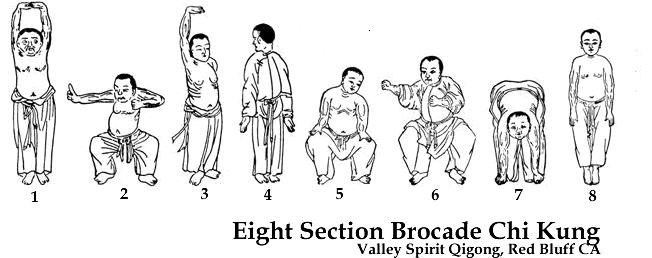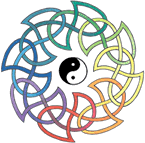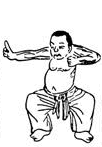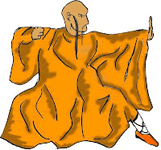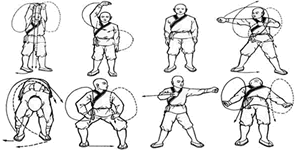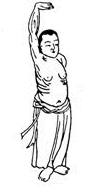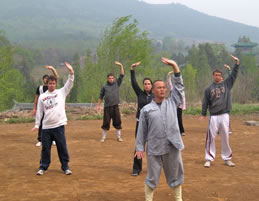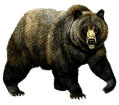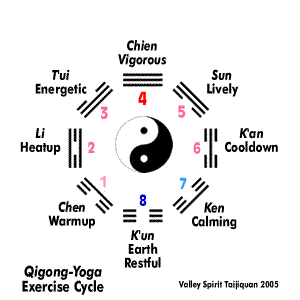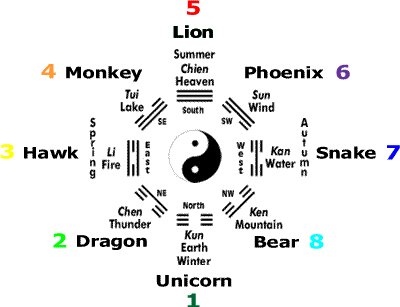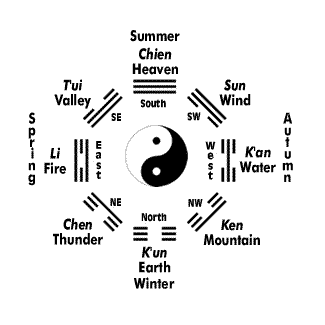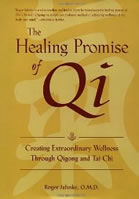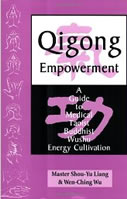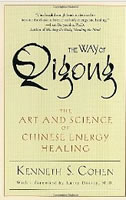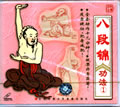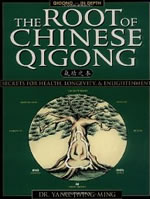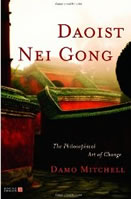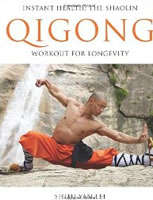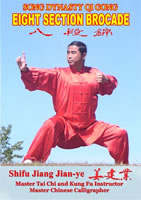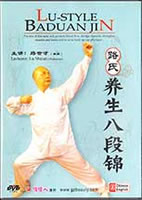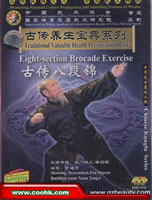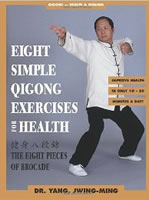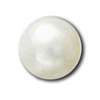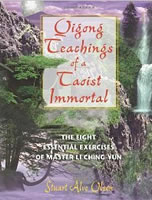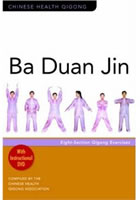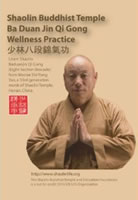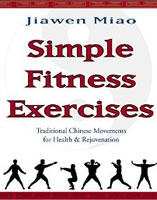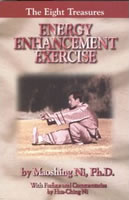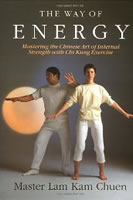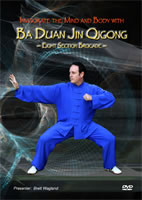Eight Section Brocade Chi Kung, Ba Duan Jin Qigong, Eight Treasures Exercise Routine from China (original) (raw)
A Hypertext Notebook by
Michael P. Garofalo, M.S.
The use of calisthenics, stretching, and breathing exercises to maintain good health, fight disease, and enhance the quality of life is of great antiquity. This type of physical activity has a long documented history in both India and China. Artwork, medical manuals, folklore, treatises, scriptures and reports on the subject go back over 2,500 years. Likewise, military physical conditioning techniques, and training with military weapons (bow,sword, staff,saber, knife, spear, etc.) are of comparable antiquity.
Over many centuries in China, traditional medical remedies (e.g., herbs, massage, diet, heat, acupuncture, exercise routines, etc.) were combined with esoteric and magical Daoist (Taoist) and local shamanistic healing practices. In addition, trade and cultural exchanges between India and China transferred Buddhist theory and practices, Tantra, Yoga, Dao-yin, medicinal herbs, medical techniques, and martial arts training techniques between these civilizations.
Taoism emphasizes the underlying unity of the individual and the cosmos, living in harmony with the true Way or Dao (Tao), giving up petty viewpoints, simplicity, solitary retreats, avoiding violent interference with others, a simple natural diet, natural and compassionate living, sharing with others, seeking insight into "emptiness", seeking a higher understanding or enlightenment, living a healthy lifestyle, storing and circulating energy (Qi, Chi, Prana), practicing meditation, studying and working diligently, and seeking mystical insights. These methods and practices were explored and adapted in China for thousands of years to help to maintain good health, to prevent and cure diseases, to restore vitality, to calm the mind, and to enhance the spirit of the patient or practitioner. Seeking ways to enjoy a long, healthy, energetic, ethical and enchanted life are, of course, of widespread and perennial interest.
Interesting theories abound about the origin and development of the Eight Section Brocade Chi Kung. It is likely that ancient dances, medical theory, military drills and exercises, shamanistic rituals, and Buddhist and Taoist practices were all sources for the specific and formal movement routines of Dao-yin or Chi Kung (Qigong). The ancient terms for these types of Qigong or Chi Kung(energy/Qi/breath training) fitness exercises include: Dao Yin (guiding, breathing and stretching), "guiding and stretching" or "pulling and guiding" exercises; or, Daoqi Yinti (guide the qi and stretch the body); or, Yang Sheng Fa(Longevity Practices, Nourishing Life); or Neidan (Inner Alchemy). Literature that talks about such health and fitness exercise postures or routines, with some movements quite similar to movements in the Eight Section Brocade Chi Kung, goes back nearly 2,500 years. Let us now review some of that historical development, in chronological order.
There are statements in the writings of the philosophical Taoists likeLao Tzu and Chuang Tzu, circa 500-300 BCE, that comment on health exercises. Chuang Tzu says in Chapter 15,
"Breathing in and out in various manners, spitting out the old and taking in the new, walking like a bear and stretching their neck like a bird to achieve longevity - this is what such practitioners of Daoyin, cultivators of the body and all those searching for long life like Ancestor Peng, enjoy."
- Chuang Tzu, Chapter 15, circa 300 BCE (Actually, Chuang Tzu seems to be mocking these exercises as unnecessary.)
There was a wealthy King Ma who lived sometime around 160 BCE during the Western Han Dynasty (206 BCE - 24 CE). When King Ma died they placed many documents in his tomb. In 1973, archeologists in China excavated the tomb of King Ma. In King Ma's tomb at Mawangdui, on the outskirts of the city of Changsha in Hunan Province, they discovered medical manuals, compilations, and a silk scroll on which were drawn 44 humans in various poses or postures. Under each pose, on the Dao-yin diagram (Tu), was a caption with the name of an animal exercise or the name of the disease that the posture might help cure. A number of the postures depicted in the Dao-yin Tu closely resemble some postures in the Eight Section Brocade Chi Kung (The Wonders of Qigong, 1985, pp. 13-17; andLi Jingwei, 2014, p. 4-14).
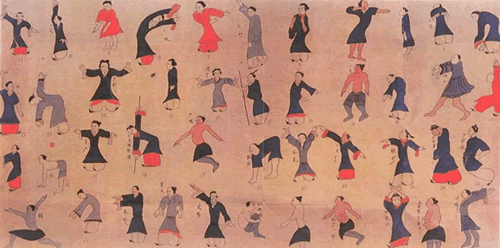
Redrawn and colored art reproduction of the Dao-yin Tu scroll found in the Mawangdui Tomb of King Ma from around 160 BCE
"The Dao-yin Tu is the finest example of the consistency and continuity of qigong healing
techniques. The majority of the exercises look so similar to the postures of modern qigong
that it is possible to deduce how they were performed. The rich themes found in the
Dao-yin Tu run like a fine thread through the fabric of qigong history and evolution.'
- Kenneth Cohen, The Way of Qigong, 1997, p. 19
Making beneficial exercises interesting and enjoyable has always been a challenge to creative people. Hua T'o (110-207 CE) is one of the most famous physicians of the Han Dynasty. He created a series of exercises called the "Animal Frolics." There are many versions of the animal frolics exercises today, and some of these exercises are similar to those found in the Eight Section Brocade Chi Kung. In The History of the Later Han, Hua T'o wrote:
"Man's body must have exercise, but it should never be done to the point of exhaustion. By moving about briskly, digestion is improved, the blood vessels are opened, and illnesses are prevented. It is like a used doorstep which never rots. As far as Tao Yin (bending and stretching exercises) is concerned, we have the bear's neck, the crane's twist, and swaying the waist and moving the joints to promote long life. Now I have created the art called the Frolics of the Five Animals: the Tiger, the Deer, the Bear, the Monkey, and the Crane. It eliminates sickness, benefits the legs, and is also a form of Tao Yin. If you feel out of sorts, just practice one of my Frolics. A gentle sweat will exude, the complexion will become rosy; the body will feel light and you will want to eat."
- From: Drawing Silk: A Training Manual for T'ai Chi, p. 6.
One tradition is that the Buddhist teacher, Bodhidharma(448-527 CE), a famous Grand Master of Chan (Zen), introduced a set of 18 exercises to the Buddhist monks at the Shaolin Temple. These are known as the "Eighteen Hands of the Lohan." This Shaolin Lohan Qigong (i.e., the art of the breath of the enlightened ones) "is an internal set of exercises for cultivating the "three treasures" of qi (vital energy), jing(essence), and shen (spirit)," according to Howard Choy. The Kung Fu master, Sifu Wong Kiew-Kit, referring to the Shaolin Wahnam style, says "the first eight Lohan Hands are the same as the eight exercises in a famous set of chi kung exercises called the Eight Pieces of Brocade." Shifu Yan Lei says that the eight exercises were developed at the Shaolin Temple a few hundred years after the Bodhidharma died. There are numerous versions, seated and standing, of Bodhiidharma's exercise sets - including the related "Tendon-Changing and Marrow-Washing" (Yi Jin Jing) qigong set with exercises identical to Brocade versions (Li Jingwei, 2014, p. 23-30). Some versions of the 18 Lohan (Luohan) Hands have up to four levels, and scores of movement forms for qigong and martial purposes.
Professor Wang Jiafu has traced the history of Dao-yin fitness exercises, and states "Books and diagrams about daoyin appeared in growing numbers in the Western Jin Dynasty (266-316 AD). By the time of the Sui and Tang dynasties (581-907 AD) daoyin had branched out into other forms of fitness exercises, such as the popular baduanjin." (Wonders of Qigong, p.13).
The Qigong and American Indian master,Kenneth Cohen, notes that the eight-century Daoist treatise Xiu Zhen Shi Shu ("The Ten Treatises on Restoring the Original Vitality"), attributes the development of the Eight Section Brocade to one of the legendary Eight Immortals of Chinese folklore, Chong Li-quan.
The qigong and Chinese scholar, Stuart Alve Olson, says the seated Eight Section Brocade form was created by T'ao Hung-ching, a Taoist adept living in the fifth century CE, and further developed by the Taoist sage Chen Tuan (Chen Hsi-yi, Hsi-yi) living in the tenth century CE.
During the period of 800 - 1200 CE, variations of these exercises were done in Wudang Mountain Daoist Temples for health and meditation purposes, and some were used as warm up exercises by monks training at the Shaolin Temple in hard style martial arts. One can also see some movements and postures in the Five Animal Frolics that are comparable to the Eight Treasures. Longevity and fitness instructors, and some doctors, throughout China prescribed specific exercises to help prevent or heal injuries, improve health, or cure various illnesses, along with the other curative methods of traditional Chinese medicine. Many of thesehealth exercise practices continue to this day, and the Eight Treasures are often considered a Wai Dan medical qigong exercise set.
The Chinese Health Qigong Association says that "as a traditional Chinese health and fitness Qigong exercise routine, Ba Duan Jin, or Eight Section Exercises, dates back to the Song Dynasty (960-1279)."
The scholars Ji Jingwei and Zhu Jianping say, in their bookAn Illustrated Handbook of Chinese Qigong Forms from the Ancient Texts
During the Southern Sung Dynasty in China (1177-1279 CE), the famous General Yeuh Fei (Yue Fei) developed a set of twelve exercises that were used to train his troops, and some like Master Tom Bisio, suggest that they were one source of the Eight Section Brocade Chi King style. General Yeuh Fei is also credited with developing the Hsing I internal martial arts style. At first, there were twelve movements in this exercise set, all done in a vigorous manner, and done with the weight of military equipment on the body.
In the 13th and 14th centuries the Taoist compilation "Ten Books on the Cultivation of Perfection (Xiuzhen Shishu)" included essays and illustrations about the seated version of the Eight Section Brocade (Li Jingwei, 2014, p. 83).
Since 1800, eight of the exercises, done with far less speed and force, became widely used as a warm-up exercise set in many soft style internal martial arts (i.e., Taijiquan,Bagua, Hsing I), or in parts of other Chi Kung (Qigong) practice routines; and, became widely known as the Eight Section Brocade or Eight Treasures Exercises. The soft qigong style (Rou Gong) of the Eight Section Brocade Chi Kung, emphasizing Daoist exercise methods and the aims of inner qigong (Nei Gong), and general bodily and mental health benefits, is arguably the most popular Chinese Qigong exercise set now practiced all around the world.
In 1843, Ma Yizhen collated many Buddhist documents into the "Two Classics of Yijin and Xisui" which included descriptions and illustrations of the seated Eight Section Brocade for Physique Building. (Li Jingwei, 2014, p. 196).
In 1895, Zhou Shuguan provided introductions and illustrations for the Eight Section Brocade in "An Illustrated Book of Exercises to Benefit the Internal Organs - Promoting the Metabolism, Limbering Up the Tendons and Refreshing the Marrow, Volume 16." (Li Jingwei, 2014, p. 83).
In the 20th century, especially after World War II, traditional qigong and taijiquan teachers from China immigrated to the United States, Southeast Asia, Australia, Japan, and Europe. They taught the Eight Section Brocade Chi Kung in T'ai Chi Ch'uan and Chi Kung classes. Since, 1990, many books in English, instructional videos, and Internet webpages in many languages have also taught this form. Now the Eight Section Brocade Chi Kung form is appreciated and practiced all around the world.
"All Chi Kung exercises are intended to improve health, increase energy, revitalize the body and mind, prevent or control disease, tone the internal organs, improve balance, reduce stress, boost the immune system, remove toxins, tone the muscles and tendons, uplift mood, contribute to longevity, and provide an integrated mind-body practice leading towards enlightenment and harmony with the Tao. Take some confidence in this promise, "Every person who uses Qi cultivation methods consistently experiences some form of health improvement and personal access to greater energy and power"
- Roger Jahnke, OMD, The Healing Promise of Qi, 2002, p. 31.
Learning the Eight Section Brocade
I have been taught this exercise set by seven different taijiquan or qigong instructors. Some instructors have done the eight movements very slowly, very deliberately, only two times, and with a minimum of muscular effort. Some teachers did the movements at a moderate pace, each movement was done 8 to 16 times, and the degree of exertion was moderate to demanding. Some encouraged low horse stances, others used higher shoulder width stances. Some were precise about repetitions, others not. There were slight to significant variations in the style and form of the movements depending upon the speed with which they were done, in the order of the movements, and in the breathing patterns. All but one instructor taught us to do the movements in a standing position; thus, there is both a Wen or slow, soft and seated style; and, a Wu or active, standing style of the_Ba Duan Jin_. One instructor emphasized yin-yang balance, meditation, opening qi channels, circulating the qi, visualizations, and other esoteric and arcane aspects of Southern Complete Reality Taoism. The literature on the subject, and videotaped lessons, also reflect the different styles, goals, intensity, and fitness objectives used when performing this very popular chi kung set.
I enjoy doing the movements of the Eight Section Brocade at a moderate pace, doing up to 8 repetitions of each movement, and using the breathing patterns and the order of the movements as presented below. I use the set for warming up my body before Taijiquan practice or walking. I tend to do the set in a relaxed and easy manner, and primarily for loosening and stretching. Occasionally, I do the Eight Treasures very slowly, with emphasis placed on breathing, energy movement and gathering, and for meditation. What is most important is 1) doing the entire set once each day, and 2) using a pace and doing a number of repetitions that are suitable to your current level of physical conditioning and the overall state of your physical-mental health, 3) reflecting on the power of "beliefs" and choosing them wisely, and 4) recognizing the limitationsof any exercise regime.
Considerable attention is given to concentrating, focusing the mind, intention and gazing when doing the eight exercises. To facilitate concentration: be deliberate, slow down the movements more, and follow a formal routine for doing the movements. The literature on Qigong (Chi Kung) often repeats the idea of "Yi Guiding Qi." The conscious, alert, and discerning mind is a Big Player here. Move with intention. Imagine willing a movement and executing the movement precisely. Imagine wielding a surgeon's knife and cutting flesh exactly were you want to cut. Imagine gently and carefully moving an infant. Imagine driving a motorcycle in bad road conditions as if your life depended on every movement you make. Use whatever imagery or mind-set you need to concentrate on the exercise movements. Be focused!! Pay full attention to the movements while moving, knowing exactly where and how to move, and where and when to stop on a dime. Learn how to move, store, and utilize Qi (Life Energy) most effectively by the power of will, disciplined action, logical processes, intentionality, accomplishing objectives, concentration, visualization, mental focus, etc.
The Eight Section Brocade is one of scores of exercise sets in the large Chi Kung (Qigong) family. "Ch'i" or "Qi" is the Chinese word for breath, energy, vital force, air, or life power; and, there are different types of Ch'i. The Sanskrit word 'Prana' and the Japanese word 'Ki' are very similar in meaning to 'Qi.' The word "Kung" or "Gong" implies a regular, systematic, intense, long term, and dedicated training regiment. Therefore, "Ch'i Kung" or "Qigong" is a long term training program to circulate, cultivate, regulate, enhance, and guide vital internal energies to achieve health, vitality, and spiritual awareness. Prior to the mid-20th Century, "Qigong" exercise regimens were called by other names even back 1300 years ago, e.g., "Yangshenggong" Health Enhancing Training;" Stretch and Pull the Musculature/Tendons; Breathing exercises, "Dao-yin."
In traditional Taoist practices, the teachers speak about the need to do this exercise routine for a minimum of 100 days before any benefits become noticeable, and before you decide to stop doing the exercise set. The cultivation of the "Dan Tien" or "Field of Elixir", like the cultivation of any garden or field, requires work (Kung) over an extended period of time before the crop grows to harvest size. Tomatoes take 70-100 days to grow and to produce and ripen their lovely and tasty fruits. The long term cultivation of the "Field of Elixir" or "Orchard of Elixir" demands that we continue these qigong exercises for many years to assure longevity and to aim towards attaining the special powers of a chen-jen or "realized being." The ancients Taoists said,
"Only after a hundred days of concentrated work is the light real;
Only then is it the fire of spirit.
To set up the Foundation requires a hundred days."
- The Secret of the Golden Flower, Translated by Thomas Cleary, p. 17, 49.
Some experts contend that the Eight Section Brocade is not a Qigong (Ch'i Kung) exercise set or Taoist set. They argue that the eight movement set is a Shaolin Buddhist martial arts warm up and stretching exercise set. The movements can be done without the mental (Mind=Yi) emphasis being placed on guiding and moving the Ch'i in the body, unblocking Ch'i channels, circulating the Ch'i around the Microcosmic Orbit, storing Ch'i, converting Ch'i to Jing, etc. Just move precisely, don't think a lot. When the Eight Treasures movements are done at a faster pace or with more muscular emphasis, it is not always possible to concentrate on Yi guiding Ch'i or other facets of serious Ch'i Kung training. Nevertheless, many of the physical and psychological benefits derived from using the Eight Treasures as a Ch'i Kung exercise routine will also be obtained if the Eight Treasures are practiced daily and solely as a martial arts warm up and stretching exercise set. If Ch'i is a reality, it must function without our conscious attention; but, we cannot gain additional benefit or advantage from Qi management arts (i.e., discovering, gathering, circulating, purifying, directing, conserving, storing, transforming, dissolving, or transmitting Qi [Jahnke 2002: 80]) in our martial arts practice or health regimen without disciplined conscious attention.
Most people will enjoy and benefit greatly from doing the Eight Section Brocade in a relaxed (Sung) manner. The use of intense muscular contractions, excessive stretching, or aggressive movements are counterproductive. Relax, breathenaturally and fully, move slowly, sink into the earth, become like freely moving water, be soft, be gentle. Don't be attached to your ordinary mind of free associations, worries, and concerns - observe them and then release them into the past. Free your mind of mundane concerns and cultivate calmness, inner peace, and not thinking. Allow yourself to feel your body and take pleasure from it during the movements. Be present in the here and now.
Be fully aware of your surroundings through all of your senses. Listen to your body. Relax and enjoy yourself. Cultivate a detached, open, and tranquil consciousness. Unburden your body-mind of anxieties and tensions and fully relax. All of these aims can be summarized by the term "Sung." Sung denotes relaxation, alertness, looseness, openness, sensitivity, awareness, calmness, and a tranquil mind. Stay grounded and centered.
There are many books, manuals, VHS and DVD instructional media, andUTube videos that are available to help you to learn the Eight Section Brocade Chi Kung. I have provided below a detailed bibliography including references to books, magazine articles, DVDs, links, resources, authorities, etc.
Millions of people practice Ba Duan Jin Qigong regularly and could teach you to do the form. I have also tried to provide you with some instructions for learning the form, as well as related background information. For each movement I give the variations of the movement, alternative names, health benefits, and general comments.
I have collected a number of quotations regarding the Eight Section Brocade Chi Kung and Dao-yin/Qigong in general.
I taught yoga, qigong, and taijiquan at the Tehama Family Fitness Center in Red Bluff, California, from 2002 - 2016. I used my earnings to attend workshops,
purchase books and DVDs, take classes, and earn certifications as a yoga, taiji, and fitness instructor. I used variations of movements from the
Eight Section Brocade regularly in my hatha yoga and for stretching in fitness classes.
Thanks to everyone who has sent me email withpositive comments and good suggestions for this webpage.
So, let us begin learning more about the Eight Section Brocade Chi Kung movements.
My very best wishes to everyone for good health, increased vitality, and mental and spiritual harmony along the Way,
February 2019, Michael P. Garofalo
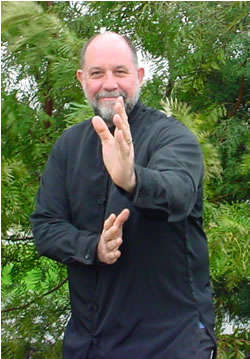
Michael P. Garofalo
Valley Spirit Qigong
Red Bluff, California
February 2006
"Breathing in and out in various manners, spitting out the old and taking in the new, walking like a
bear and stretching their neck like a bird to achieve longevity - this is what such practitioners of
Dao-yin, cultivators of the body and all those searching for long life like Ancestor Peng, enjoy."
Chuang-tzu, Chapter 15, circa 300 BCE.
Eight Section Brocade Chi Kung
Starting and Resting Position, Wuji
1. Pressing Up to the Heavens with Two Hands
2. Drawing the Bow and Letting the Arrow Fly
3. Separating Heaven and Earth
5. Big Bear Turns from Side to Side
6. Punching with an Angry Gaze
7. Touching the Toes then Bending Backwards
Comments on the Sequence of Movements in Eight Section Brocade variations.
List of Movements of the Eight Section Brocade, 1 page, PDF file, read or print. A handout for my for Qigong students.
"Both hands carry heaven to regulate the triple burner.
Draw the bow left and right as if to shoot a vulture.
Regulate spleen and stomach by lifting one hand.
Remedy the 5 symptoms and 7 disorders by looking backward.
Turn the head and swing the tail to eliminate heart-fire.
Clench fists and look angry to increase qi and strength.
Two hands grab the feet to strengthen kidneys and waist.
Jolt the back 7 times and hundred illnesses will disappear."
- Translated by Hielke Hylkema
Starting and Resting Position while Standing: Wu Ji
Stand up straight.
Your feet should be close together - touching each other.
This aids in the improvement of balance; however, a stance with the feet 7"-15" apart may be more productive and efficient for many persons. The toes should be pointed straight ahead.
Both feet should be flat on the floor.
The weight should be equal on both feet.
Don't lean to one side or the other.
Relax your body.
Stay balanced and centered.
Clear you mind and set aside the work and worries of the day.
Your face should seem happy, joyful, reflecting an "Inner Smile."
Smile! Refer to Mantak Chia's comments on the "Inner Smile."
Keep your head up and look forward.
Your eyes should be open, with a soft and wide angle focus.
Breathe in and out in a relaxed, easy, and regular manner.
Keep your lips parted slightly.
Your arms should hang down in a relaxed manner at your sides.
The palms of your hands should face your thighs.
Relax the shoulders and let them hang down.
Some recommend that you keep the tip of your tongue lightly touching the roof of your mouth.
Breathe softly in through your nose and blow out softly through your mouth.
This posture is often called the "Wu Ji Posture" in Taijiquan. It is the resting position, the position before any motion begins, a state of "grand emptiness." It is the primordial condition - empty, free, motionless, without qualities. It precedes the movement of Yin/Yang both logically and temporally. The classics talk of Wu Ji giving birth to_Tai Ji,_ emptiness transforming itself into the manifold of cyclic dualities. Of course, our bodies are never completely at rest: our hearts contract and relax, our blood moves up and down, we breath in and out, our two feet and two arms help keep us in balance as we stand, our mind may be calm and focused at the same time as billions of neurons are quite busy in our brains creating that phenomenon we directly apprehend as consciousness. So, the "Wu Ji" state of this posture is more symbolic, allegorical, or figuratively interpreted.
Students should note that the_Wuji_ posture is very similar to theYogaposture of Tadasana - the Mountain Pose. It is also called the_Samasthiti_ pose in Hatha Yoga. We should stand like a Mountain: strong, stable, unmoving, grand, still, aloof, above the mundane, powerful, accepting but unbroken by the storms of ideas, emotions and worries. The arms are held out from the body by 8"-10" in Tadasana. Reference: Light on Yoga, B.K.S. Iyengar, 1977, p.61-62.
Please also refer to my instructions for Wu Ji in the Zhan Zhuang (Standing Like a Tree) webpage. The very best book on the power of Wuji qigong is by Jan Diepersloot:Warriors of Stillness: Meditative Traditions in the Chinese Martial Arts. Also refer to Jan Diepersloot'sTao of Yiquan: The Method of Awareness in the Martial Arts. Simply standing can have great benefit to body and mind.
After completing each of the eight movements in the Eight Section Brocade Chi Kung, then use Wu Ji as the transition:
Return you left foot back into the Wu Ji position to rest and realign the body-mind.
Wu Ji signals the end of one movement and the beginning of the next movement.
Wu Ji is called "Mountain Pose" Tadasana in Hatha Yoga.
Bring your feet closer together or have heels touching.
Keep the knees slightly bent.
Enjoy some cleansing breaths. Opening/Closing.
Stand up straight and tall. Lift the head. Tuck the chin inward a little.
Loosen Up, Soften, Merge and Relax.
Feel yourself sinking and rooting into the Earth.
Free up the mind, reduce thinking, forget, become outside more.
Wu Ji is the fertile nothingness that precedes Yin and Yang, an empty and free state of being conscious, the still place before movement, the Zhong Ding of the Tao, a stop-rest-pause stop, an orgasm of the Chaos of Emptiness at the Big Bang, a transition point in the exercise routine, etc.
"When you see excellence, you shouldtry to surpass it.
When you see the opposite, examine yourself."
- Lao Tzu

1. PressingUp to the Heavens with Two Hands
Starting Position: Wu Ji
Movement Name: Pressing the Sky with Two Hands, Lifting the Heavens with Two Hands, Holding Up the Sky
Step out with your left leg into a comfortable and wide horse stance.
The toes should point at about 45 degrees to the outside.
Hands are relaxed by the hips.
Gradually lift both arms up to your shoulders, palms facing down. Inhale.
Continue gently lifting of the arms well above your head, palms facing each other.
Then relax the shoulders, let the arms come down, palms facing down. Exhaling.
Your palms should be open, with your fingers slightly apart, and relaxed.
Draw the arms down the sides of your body as you squat down and bend your back. Exhale.
Bring both hands together, palms facing up.
Imagine energy from your body intermingling with energies from the Earth through theYong Quan (Bubbling or Gushing Well) acupressure and acupuncture point on the front center of your feet. Yong Quan is an endpoint on the Kidney meridian.
Imagine scooping up some water from a lake or the ocean. Inhaling.
Inhale as you draw the arms up to your face. When moving up imagine your internal energy (Chi) moving up from your waist, up your spine, and into your head.
Draw both hands, palms up, up the center line of the body as you rise up out of the squat and straighten the upper body.
Imagine spashing cool clear water on your face.
Draw the arms above your head, turn the palms upward, press out and upward, stretch the arms upward. Hold at peak for 4 seconds.
Imagine the energy of the air, sky and the Heavens filling your lungs and whole being.
The fingers of each hand should point to each other, and be kept about 2 to 4 inches apart.
When your hands reach your face, turn the palms to face outward.
Raise both hands up until you reach your forehead.
Press your arms upward and outwards in front or your body. Exhale.
The arms should press out at a 20 to 45 degree angle from the body, do not force to press the arms straight up.
Keep your wrists bent so your fingers point to each other.
Keep your fingers 2 to 4 inches apart.
Gently stretch the whole body upward as the arms press upward.
Rise your heels up slightly as your hands reach their maximum height.
Keep your head looking forward as your arms move up, keep a wide angle focus to your eyes, and follow your hands with your eyes.
Imagine energy from your body intermingling with energy from the Heavens through the Lao Gong (Palace of Labor) acupressure and acupuncture point on the center of your palms. Lao Gong is connected with the Heart and is a pericardium meridian endpoint.
Stretch your arms up to the limit of your comfort zone, then begin the downward cycle of the movement.
Movement Tips:
Turn the palms outward and down as you circle both arms out and down.
Continue to slowly exhale as your arms move down.
Return your feet to a flat footed position.
Gently tighten your abdomen as your exhale.
When moving your hands down imagine moving energy from the Heavens and from your head and lungs down the front of your body into your waist area - into the center of your being in your Dan Tien or Field of Elixir (about three inches below and behind your navel).
Keep your head looking forward as your arms move down, keep a wide angle focus to your eyes, and follow your hands with your eyes. Keep both hands in your field of vision as your hands move down.
Begin to squat and bend forward as the arms reach the legs in their downward arc.
Draw the arms down in front of the body as you squat down and bend your back. Exhale.
Bring both hands together, palms facing up.
Imagine scooping up some water from a lake or the ocean.
Draw both hands, palms up, up the center line of the body as you rise up out of the squat and straighten the upper body.
Inhale as you draw the arms up to your face.
Generally, inhale when moving up, exhale when moving down. Make adjustments in your breathing as needed.
Repeat "Pressing the Sky" 2, 3, 6, 9, or 12 times. Whatever number of repetitions are chosen for the first exercise should be duplicated in each of the other exercises. I prefer 6 repetitions with a count of four to six seconds on the inhale, and a count of four to six seconds on the exhale.
Return you left foot back into the Wu Ji position to rest and realign the body-mind.
Wu Ji signals the end of one movement and the beginning of the next movement.
Wu Ji is called "Mountain Pose" Tadasana in Hatha Yoga.
Bring your feet closer together or have heels touching.
Keep the knees slightly bent.
Enjoy some cleansing breaths. Opening/Closing.
Stand up straight and tall. Lift the head. Tuck the chin inward a little.
Loosen Up, Soften, Merge and Relax.
Feel yourself sinking and rooting into the Earth.
Free up the mind, reduce thinking, forget, become outside more.
Wu Ji is the fertile nothingness that precedes Yin and Yang, an empty and free state of being conscious, the still place before movement, the Zhong Ding of the Tao, a stop-rest-pause stop, an orgasm of the Chaos of Emptiness at the Big Bang, a transition point in the exercise routine, etc.
Breathe naturally a few times. These are often called "cleansing breaths." Sometimes the arms are raised up in front of the body to about chest height while breathing in through the nose, and then the arms are lowered to the sides as one exhales through the mouth. Use as many "cleansing breaths" as needed to help you relax, lower your heartbeat, and compose yourself. Another transitional movement could be the Opening Hands and Closing Hands (He Shou, Kai Shou) movement of the Sun 73 Form.
Again, this neutral, standing position is often referred to as _Wu Ji_- the place before movement, an empty and free state of being, the fertile nothingness that precedes Yin and Yang. Some Chi Kung enthusiasts stand in this position for many minutes, doing nothing, bothering nobody, not interfering, minding their own business (wu wei).
Variations of the 1st Movement (Pressing Up to the Heavens with Two Hands) The Eight Section Brocade Chi Kung
a) This is the most common version of Pressing Up Heaven with Two Hands that I have seen, done, or read about.
Don't squat. Keep the knees slightly bent.
Remain standing up straight during the whole movement.
Bring the hands to the Dan Tien (waist area) with your palms facing up.
Draw both hands up the center line of the body, palms up.
Inhale while drawing the hands up.
When the hands reach the face area, turn both palms and face the palms outward and slightly upward.
The thumbs can touch the forehead.
Begin to exhale.
Press both arms up from the forehead, keeping the wrists flexed and the palms facing out.
Press up the arms has high as you can.
Raise the heels slightly.
Stretch upward.
Also called "Supporting Heaven" or "Holding up the Void."
When you reach the maximum upward press, then release the arms.
Allow the arms to trace a graceful arc downward.
Exhale completely on the way down and begin to inhale.
As the arms come down, the palms face down.
When the hands reach the waist area, then bring the hands back to the center line, palms facing up.
Breathe in when lifting arms up, breath out when pressing upward.
You could stretch to the left side and then right side with the arms extended upwards.
Some teachers have you interlace your fingers as you move your hands from the forehead upwards.
Demonstration by Mike Garofalo of Movement #1: Pressing Heaven with Two Hands (2005, 175Kb, Animated GIF)
b) My version involves some squatting as the arms come down to scoop up water. I think that the squats or deep horse stances of Drawing the Bow (2), Punching with Angry Eyes (6), and Pressing Up to the Heavens with Two Hands (1) give the body a more challenging workout. Most teachers of Movement 1 of the Eight Section Brocade Chi Kung do not squat. Their movement concentrates on the shoulders, arms, upper back, and chest muscles. I prefer a little more leg work in my version.
I would like the title for this Movement 1 to be "Scoop Up the Sea and Carry to the Top of the Mountain" or "Scoop Up the River Water and Present It to the Heavens." Earth low, Heavens high, Water both low and high. I liked Maoshing Ni's (R12) titles of "Water and Fire Meet, Bringing the Sea to the Top of the Mountain."
c) Don't Squat.
Remain standing up straight during the whole movement.
Use Reverse Breathing (Taoist or Reverse breathing).
Breathe out when your arms are pressed upward/outward, breath in when your arms return down.
When breathing in gently tighten your abdomen and expand your chest.
When breathing out expand your abdomen and sink the chest.
Do the movements very slowly when you begin Reverse Breathing techniques.
Note: It is best to begin with Regular breathing (Buddhist style): relax and expand your abdomen as you inhale and slightly compress/tighten the abdomen as you exhale. Breathe into your belly. Don't expand the chest very much.)
d) The arm movements of this exercise can be done while seated or while walking.
e) Some emphasize lifting the elbows up, with the hands, so to speak, being just along for the ride. This style lifts the scapula and shoulders up for a stretch, and flexes the trapezes muscles more. I recommend keeping the shoulders down in Movement #1.
f) Some begin the movements by stepping out with the right leg instead of the left leg. Having a Yang style taijiquan background, I generally open with the left leg stepping to the right. Feet are parallel, toes facing forward.
g) You can practice the Eight Section Brocade Chi Kung indoors alone or with a small group. Select a quiet room or space in your home. Taoist and Druid artwork indoors is enhancing. Silenceis cultivated during your practice. However, sometimes, you might try doing Chi Kung to some soft, NewAgey, melodic, ethereal music.
h) Doing Chi Kung outdoors in the early morning, when it is not windy or bitter cold, is always recommended by Chi Kung teachers and masters. I enjoy doing the Eight Section Brocade Chi Kung on my screened back porch.
i) You can raise your heels and balance on your toes when you push both arms up to the sky.
j) Do only two repetitions in a very slow and deliberate manner with little muscular effort. Keep your feet flat on the floor at all times during the movement.
Health Benefits of Movement 1: Pressing Up to the Heavens with Two Hands) The Eight Section Brocade Chi Kung
Deep soft breathing helps to lower your heartbeat and blood pressure.
Stretching helps contribute to the relaxation of stiff and tense muscles.
Standing up straight helps realign the back muscles and the spine.
Many Chinese healers believe that this exercise helps regulate and improve the heart, lungs, stomach, spleen, and liver. It stimulates the internal organs in the upper trunk area. The Triple Warmer or Triple Burner (Sanjiao) refers to the heart, lungs, and stomach.
A clear and peaceful mind reduces negative stress on the body.
Shoulders, pectorals and triceps are exercised a little in this exercise.
Bending the knees exercises the front thighs.
Squatting down exercises theleg muscles including the thighs (quadriceps), hamstrings (biceps femoris), buttocks (glutes), calves (gastrocnemius), iliopsoas, and increases demands on the cardio-vascular system.
Sat Chuen Hon, in his book Taoist Qigong, includes a movement sequence very similar to "Press Heaven with Two Hands" and using the healing sound "Hey", and considers these actions to be of great benefit to the health of the Triple Heater.
Ba Duan Jin Exercise Set 1 Instructions, illustrations, video. "Support the heaven with both hands regulate the three visceral cavities housing the internal organs (san jiao)."
"Lift Two Arms Up to Sky-Height, Be Your Gut in Great Delight." - Philip Bonifonte
It should be noted that traditional Chinese medicine does not ascribe to the same views on anatomy, physiology, or causation that are used in contemporary scientific bio-medical theories. The "Spleen Organ" or "Heart Organ" in Chinese medicine have functions and attributes of a different nature than we might understand the heart or spleen in contemporary medicine. For an excellent explanation of these concepts please read the book The Web That Has No Weaver: Understanding Chinese Medicine, by Ted J. Kaptchuk, O.M.D..
References for the Names for Movement 1 (Pressing Up to the Heavens with Two Hands) The Eight Section Brocade Chi Kung (See below for reference sources.)
Prop the Heaven to Improve the Functions of the Triple Warmers. (Zong Wu and Li Mao, R1)
Supporting the Sky with Both Hands Regulates All Internal Organs. (Lam Kam Chuen, R2)
Double Hands Hold up the Heavens to Regulate the Sanjiao - Triple Burner (Yang Jwing-ming, R3)
Scoop the Stream. (Geoff and Phyllis Pike, R4)
Holding up the Sky with both Hands to Regulate the San Chiu(Triple Warmer). (PRC Publication, R5)
Two Hands Reach Skyward to Balance the Triple Burner. (Kenneth Cohen, R6)
Pressing Up to the Heavens with Two Hands. (Michael Garofalo, R7)
Upholding Heaven with Both Hands. (Stanley Wilson, R8)
Upholding Heaven with Two Hands to Regulate the Triple Burner. (Daniel Reid, R9)
Supporting the Heaven with the Hands (Jiao Guorui, R10)
Lifting the Sky. (Wong Kiew Kit, R11)
Sustaining Heaven with Both Hands to Adjust the Three Warmers (Maoshing Ni, R12)
Holding the Hands High with Palms Up to Regulate the Internal Organs (Chinese Health Qigong Association, R13)
Push the Sky, Tuo Tian Shi (Shifu Yan Lei, R14)
Names of the movements of the Eight Section Brocade Chi Kung in languages other than English.
Comments about Movement 1 (Pressing Up the Heavens with Two Hands) The Eight Section Brocade Chi Kung
Observations, Notes, Quotations, Reflections, Questions and Answers
"In order for this to have any beneficial effect on your health, approaching it with confidence, sincerity, and perseverance in practicing the exercises is very important. Only with confidence can you develop sincerity and focus your mind while exercising; only with sincerity can you persevere to practice and gain the essence of the exercises; and only with perseverance can you get the beneficial effects of the exercises and develop more interest in them."
By Jiawen Miao, Eight Section Brocade Simple Fitness Exercises: Traditional Chinese Movements for Health & Rejuvenation.
Each movement of the Eight Section Brocade has specific techniques for using your eyes. Exercise your eyes in accordance with the instructions, e.g., following the movements of your hands, looking off into the distance, looking upward, keeping a wide angle focus of vision, etc. In some ways, these exercises are similar in style to those developed by optometrists and vision improvement advocates such as William H. Bates, Jacob Liberman, Martin Sussman, or Aldos Huxley. Learning to use your eyes in new ways and exercising your eye muscles are thought to be of benefit to your general well-being. Chi Kung and internal martial arts are seen as intertwined; and acute, careful, alert and lively visual skills are essential to self-defense and success
as a martial artist. Your safety is dependent upon seeing what is going on around you, keeping your eyes out for trouble, keeping your eyes peeled, and seeing what is coming up. Do not neglect this important dimension of the Eight Treasures. More
Most Qigong and Taijiquan routines emphasize "Respecting the Curves of the Body." Your neck, back, legs, and arms are all naturally curved or bent in a particular direction. It is always best for any posture in Qigong or Taijiquan to respect the natural curves. Legs should be slightly bent; don't lock your knees. Arms should be slightly bent; don't lock your elbows. You should not move in ways that bend or curve the body away from or counter to their natural curve or bend. To do so is to risk hyperextension, dislocation, and painful injuries to your muscles, ligaments, tendons, cartilage, joints, or bones. Whipping you neck backwards or twisting your back backwards are extremely dangerous. Highly conditioned athletes (e.g., dancers, gymnasts, acrobats, jumpers, divers, contortionists, etc.) might be able to push the limits; but, ordinary folks, sensible people, need to be very careful and use restraint when doing some qigong exercise movements and postures. Many fitness instructors remind their students to "mainatin a neutral spine" to avoid injury. This general caution applies to all the postures of the Eight Section Brocade, and especially to some of the movements such as Touching the Toes and Bending Backwards.
Generally, we begin a movement by lifting our left foot and moving it to the left. We inhale as we lift the foot and exhale when the foot settles down into the floor. Many taijiquan forms also begin with a step to the left.
Every beginner should stay within their comfort zone, don't over stretch, and be gentle with your body and mind. Don't try to "exactly" imitate a fellow student who is an intermediate or advanced Chi Kung player or the teacher. Know and respect your own body and mental state. Don't go beyond your own personal bodily conditioning, skills, abilities and limits. Some advise reducing your exertion levels and doing 30% to 40% less than you can do. Be reasonable and kind to yourself. Take your time, advance slowly, be careful, be patient, and remain injury free. Sometimes, an old or new injury, or joint disease, will limit your range of motion. Know your own strength and limitations - the practice ofChi Kung andTai Chi forms will reveal to you your strengths and limitations. Resolve to make two positive contributions today. Stay within your comfort zone, explore with the body-mind, and renew-recreate both self-awareness and awareness of Self, and come to experience your comfort zone. Float on the Wu-wei raft on the Tao River; when standing on Earth thenroot,soften,move.
The late Jane Hallander calls this movement "Holding the Moon (Peng Yue)" and describes and explains the purpose of the movement in "Tai Chi Chuan's Internal Secrets" (pp.16-17).
This movement is called "Hold the Moon and Reach for the Sun" and is described and illustrated in the book "Secrets of the Dragon Gate" (2011, pp. 36-39) by Steven Liu and Johathan Blank. As you rise up from the squat your arms are positioned as if embracing or holding a large beach ball, i.e., the moon.
The word "Heavens' (tian) has a number of meanings, including the abode of our ancestors, the cosmos, the universe of which we are part, a source of energy, and the skies above. In part, the ideas of our civilization and our language do "hold up" that which we know about the "Heavens" and our ideas of the world beyond; and, in part, these realms are beyond our comprehension - beyond our grasp and holding power.
In many ways this is just the delightful, restful, and natural movement of raising the arms and stretching upwards. Some would say "nothing special" with a wink in their eye. This is good!
List of Movements in the Eight Section Brocade in English. 1 page, PDF file. By Mike Garofalo.
2. Drawing the Bowand Letting the Arrow Fly
Starting Position: Wu Ji
Movement Name: Drawing the Bow and Letting the Arrow Fly, Drawing the Bow, Pulling the Bow and Releasing the Arrow, Shooting the Serpent, Pull-Aim-Release
Lift and step to the left with your left foot. Step out with your left foot into a horse stance.
Point both feet forward and keep them flat on the floor.
The feet should be wider than shoulder width apart.
Bend the knees.
Keep your back straight and head up.
Gently raise your hands to your chest.
Cross your hands, right hand in front of left hand, hands relaxed and open, with your palms facing inward.
Extend your left arm out level with your chest. Hold your fingers slightly bent as if your fingers and hand are curled around a bow, holding he bow in your left hand.
At the same time your left arm is extending outward, you lift your right arm up to chest height, your right arm bends at the elbow, your index and middle finger bend, and then your right arm moves out to the right keeping your elbow bent. Imagine that you are holding the string of a bow, fingers on the string and above and below the arrow, and then pulling on the bow string with your right arm.
Look to the left.
As you draw the bow and string apart breathe in deeply.
Aim the bow and arrow, and then release the fingers of the right hand to let the arrow fly.
As you release the arrow, begin to slowly breathe out.
Relax.
The movement of the two arms should mimic the drawing of a bow string and arrow, aiming the arrow, and releasing the arrow. Coordinate the movement of the arms to match this image. Feel the tension in the bow and string as your draw them apart to fire the arrow. Aim the arrow at a target. Watch the arrow fly to its target. Concentrate on the target.
Breathe in while drawing the bow, and breathe out when releasing the arrow and repositioning the hands for the next shot.
You have now completed the left side part of the Drawing the Bow Movement #2.
Return arms downward in an arc and then back up the center of your body.
Cross your arms in front of your chest, right hand in front of the left hand.
Relax.
Your head should be facing forward.
Horse stance.
Root into the earth below, sink, feel the earth power.
Now you will begin the right side part of Drawing the Bow Movement #2.
Extend your right arm out level with your chest. Hold your fingers slightly bent as if your fingers and hand are curled around a bow, holding he bow in your right hand.
At the same time your right arm is moving outward, you lift your left arm up to chest height, your left arm bends at the elbow, your index and middle finger bend, and then your left arm moves out to the left keeping your elbow bent. Imagine that you are holding the string of a bow, left fingers on the string and around the arrow, and then pulling on the bow string with your left arm.
Look to the right.
As you draw the bow and string apart breathe in deeply.
Aim the bow and arrow, and release the fingers of the left hand to let the arrow fly.
As you release the arrow, begin to slowly breathe out.
Repeat the movements to both the left and right sides, eight times to each side, so that you draw and fire eight arrows to the left side and eight arrows to the right side.
Return you left foot back into the Wu Ji position to rest and realign the body-mind.
Wu Ji signals the end of one movement and the beginning of the next movement.
Wu Ji is called "Mountain Pose" Tadasana in Hatha Yoga.
Bring your feet closer together or have heels touching.
Keep the knees slightly bent.
Enjoy some cleansing breaths. Opening/Closing.
Stand up straight and tall. Lift the head. Tuck the chin inward a little.
Loosen Up, Soften, Merge and Relax.
Feel yourself sinking and rooting into the Earth.
Free up the mind, reduce thinking, forget, become outside more.
Variations of Movement #2: Drawing the Bow and Letting the Arrow Fly
a) The fingers of the hand are held slightly open and in-line the entire exercise. The more you bend your knees and the lower you drop into the horse stance, the greater the demands on the thighs and the greater the difficulty of the exercise. Sink lower in the horse stance after firing every 4 arrows.
b) The drawing of the bow can be done very slowly or deliberately, or faster and with more force. Always pause, concentrate, and aim before firing. Follow the arrow through the sky as it flies out from the bow. Some circle the arms upward after each shot of the arrow.
c) Some hold the hand in a position with the index pointing out, the thumb up, and all the other fingers curled inward and touching the palm. The hand sort of looks like a play handgun. The index finger is pointed at the target.
d) Generally, the arms are level with the shoulder and at a right angle to the hips. However, if your are imagining shooting an arrow a great distance, then the forward bow arm should be at a angle greater than 90� relative to the hips. The arrow must be aimed higher than the target when the target is at a great distance from the archer.
e) The number of arrows fired can vary: 2, 3, 5, 8, 16, 24, 36, etc.
f) The arm movements of this exercise may be done while seated or while walking. Refer to my notes in the Thirteen Treasures Walking Qigong.
Although most references for this exercise are to the act of shooting eagles, hawks, or other types of birds, this is not required. One could imagine aiming at and letting an arrow fly to many types of targets. A Buddhist might imagine targeting and striking at one's individual faults, shortcomings, and evil behaviors; or hitting the targets of wisdom or enlightenment. A Taoist might imagine targeting and striking at tension, interfering behaviors, and gluttony; or hitting the targets of health, energy, vitality, and longevity. A Confucian might imagine targeting and striking at selfishness, sloth, disrespect, greed and ignorance; or hitting the targets of social harmony, cooperation, civility, and propriety. In a similar manner, a Christian might want to aim at love and forgiveness, or a Moslem aim at universal brotherhood and charity. A hunter might imagine shooting all types of game animals; or, a soldier imagine shooting at an enemy in battle. What are the negative behaviors, attitudes, and ideas that you wish to eliminate? What are the positive goals, aims, or objectives that you wish to target and hit on the bull's-eye?
Health Benefits ofMovement #2: Drawing the Bow and Letting the Arrow Fly of The Eight Section Brocade Chi Kung
Horse stances condition and strengthen the legs, knees, waist and back muscles.
Squatting down works the following muscle groups: quadriceps, glutes, hamstrings, long outside muscle, calves. Squatting down and coming back up will improve some balancing skills and increase cardiovascular intensity.
Shoulders, biceps and forearms are conditioned and strengthened.
Many Chinese healers believe that this exercise helps regulate and improve the Kidney meridians.
Balance and brain functions are improved by coordinated movements.
Stretching helps contribute to the relaxation of stiff and tense muscles.
Standing up straight in a horse stance helps realign the back muscles and the spine.
A clear and peaceful mind reduces negative stress on the body.
Squatting down exercises theleg muscles including the thighs (quadriceps), hamstrings (biceps femoris), buttocks (glutes), calves (gastrocnemius), iliopsoas, and increases demands on the cardio-vascular system.
Increased heart rate and breathing rate provide some cardiovascular benefit.
Useful imagery can have positive effects on mental functioning and performance.
Using both sides of the body (mirroring in a movement form) can have positive effects on the structural alignment of the body and enhance coordination.
Slow, deep and regular breathing positively effects mood, energy levels, and alertness; as well as improving the mechanical functioning of the lungs.
Exercises the eye muscles.
Disclaimer
Sat Chuen Hon, in his book Taoist Qigong, includes a movement sequence similar to "Drawing the Bow" and using the healing sound "Xi", and considers these actions to be of great benefit to the health of the Lungs.
Ba Duan Jin Exercise Set 2, "Drawing a bow to each side resembles shooting and eagle. Places the emphasis on your thorax - the home of your heart and lungs - thus greatly improving the circulation of blood and oxygen. It also improves the flow of energy in your small intestine. heart and lungs - thus greatly improving the circulation of blood and oxygen. It also improves the flow of energy in your small intestine."
References for the Names of the Movement 2 (Drawing the Bow and Letting the Arrow Fly) Eight Section Brocade Chi Kung (See below for reference sources.)
Drawing the Bow to Kill a Vulture. (Zong Wu and Li Mao, R1)
Drawing a Bow to Each Side Resembles Shooting an Eagle. (Lam Kam Chuen, R2)
Open the Bow like Shooting a Hawk, Two Arms Strong and Firm to Strengthen Kidneys and Waist. (Yang Jwing-ming, R3)
The Shaolin Archer. (Geoff and Phyllis Pike, R4)
Drawing the Bow to the Left and Right as though Shooting a Bird. (PRC Publication, R5)
Open the Bow as Thought Shooting the Buzzard. (Kenneth Cohen, R6)
Drawing the Bow and Letting the Arrow Fly. (Michael Garofalo, R7)
Drawing the Bow with Each Hand. (Stanley Wilson, R8)
Drawing the Bow to the Left and the Right as Though Shooting at a Hawk. (Daniel reid, R9)
Drawing the Bow to Shoot Vultures (Jiao Guorui, R10)
Shooting Arrows. (Wong Kiew Kit, R11)
Drawing the Bow with Both Hands to Aim at a Distant Target (Maoshing Ni, R12)
Posing as an Archer Shooting Both Left and Right Handed (Chinese Health Qigong Association, R13)
Bow and Arrow, Kai Gong Shi (Shifu Yan Lei, R14)
Names of the movements of the Eight Section Brocade Chi Kung in languages other than English.
Comments about Movement 2: Opening the Bow and Letting the Arrow Fly
Observations, Notes, Quotations, Reflections, Questions and Answers
"This section can expand the chest, relieve functional disturbances of the lung-qi, and limber up arms and shoulders; prevent and treat diseases in the neck and shoulder, and reduce pain in lower back and leg."
- Baduanjin
"Shooting the Hawk by Drawing the Bow Tight, Do This Twice With Your Left and Right." - Philip Bonifonte
Can anyone learn the Eight Section Brocade without the benefit of direct instruction from a Ch'i Kung instructor or master? I believe you can make very good progress on your own. This form is not very complex in terms of length, sequence or postures. In addition to the instructions found on this webpage, there are many finebooks with detailed descriptions and illustrations and there are a few instructional DVSs or videotapes on this subject produced by recognized experts with decades of experience in Qigong or Taijiquan internal arts. Workshops on the Eight Treasures are widely available. Group practice of this form brings a unique positive and healthy synergy, new insights, the opportunity for useful corrections to your movements from a qualified instructor, and the beauty of the coordinated movement of a group. Take advantage of some group practice if you can. Always be open to ideas on the topic and be ready and willing to learn from others. Cheng Man-ch'ing speaks about how a few persons used only books to learn T'ai Chi Ch'uan (a very difficult task), and his remarks could equally or more so apply to learning less complex Qigong forms on your own from books, videotapes or DVDs; he says,
"Some have asked me if it is really possible to master T'ai-chi ch'uan relying solely on a book and having no teacher. My answer is that this is a very good question. Self study in T'ai-chi ch'uan is indeed very difficult. Former masters stressed oral transmission and personal instruction. But when there is no alternative, and in order to benefit the greatest number, one must not shrink from the difficulties, but seek every possible means."
- Professor Cheng Man-ch'ing, Advanced T'ai Chi Form Instructions, Wile 1985 p.9.
No matter how you came to learn to do this form, in the end, your own practice in the form is all that really matters. You must personally experience the movements and the benefits of the Eight Treasures Chi Kung, and have your own body-mind grasp their essence - this is how you will really "learn" the Eight Treasures. Your solo practice is the primary and essential element of your progress. Without your daily practice and effort (Kung) at the Eight Treasures, on your own, true learning will never occur. This is an experiential, existential, inner movement art; and your real experiences, healthy attitude, and increased energy and vitality are the only real criteria of accomplishment.
Every beginner should stay within their comfort zone, don't over stretch, and be gentle with your body and mind. Don't try to "exactly" imitate a fellow student who is an intermediate or advanced Chi Kung player or the teacher. Know and respect your own body and mental state. Don't go beyond your own personal bodily conditioning, skills, abilities and limits. Some advise reducing your exertion levels and doing 30% to 40% less than you can do. Be reasonable and kind to yourself. Take your time, advance slowly, be careful, be patient, and remain injury free. Sometimes, an old or new injury, or joint disease, will limit your range of motion. Know your own strength and limitations - the practice ofChi Kung andTai Chi forms will reveal to you your strengths and limitations. Resolve to make two positive contributions today. Stay within your comfort zone, explore with the body-mind, and renew-recreate both self-awareness and awareness of Self, and come to experience your comfort zone. Float on the Wu-wei raft on the Tao River; when standing on Earth thenroot,soften,move.
Some days you will only have the energy to imagine pulling on the string of a child's bow - a five pound bow. On other days you will have the internal power and strong desire to imagine pulling on a 30 pound bow. Go with the flow! Recognize your energy levels, and use them in a practical and flexible manner.
"When condensing the internal power, it should be like the pulling of a bow; when projecting the internal power, it should be like the shooting of an arrow."
- Master Wu Yu-hsiang (1812 - 1880), Translation by Waysun Liao
I enjoy doing this exercise while walking. Be sure to AIM, look carefully at the target, and imagine watching the arrow fly to its target. While walking, you can aim at a variety of targets, near or far, to the side or to the front. Experiment! I do the standing version of the Eight Treasures outdoors in my garden or by the small pond. Many Chinese enjoy doing qigong in parks or other beautiful natural settings.
List of Movements in the Eight Section Brocade in English. 1 page, PDF file. By Mike Garofalo.
Michael P. Garofalo's: Cloud Hands Blog Facebook Hypertext Notebook's Index

This webpage work is licensed under a Creative Commons Attribution-NonCommercial-NoDerivatives 4.0 International License,� 2018 CCA 4.0
Michael P. Garofalo, M.S., Green Way Research, Valley Spirit Center, Gushen Grove, Vancouver, Washington
Green Way Research, � 2000-2018.
3. Separating Heaven and Earth
Starting Position: Wu Ji
Movement Name: Separating Heaven and Earth, Pressing Up to the Sky and Down to the Earth
Lift and step your left foot out to a shoulder width stance, feet parallel, arms at sides, hands on thighs.
The right hand lifts up along your side and the palm faces down.
The left hand moves to the center of the waist, palm up.
Inhale deeply and completely as you turn your left hand over so the palm faces your chest. Bring your left arm up so your hand moves up the middle of your chest.
Slowly lift your right hand to your waist, palm facing down.
Inhale through your nose.
When you left hand reaches your eye level, turn your left palm out.
Begin to exhale through your mouth.
As you slowly and completely exhale, press your left arm upward and forward, as far as comfortable, palm facing up. At the same time, press your right arm down and slightly back as far as comfortable, palm facing down.
Follow your left hand with your eyes. Keep your head facing forward, and don't bend your neck to look at your hand.
Just move your eyes and gaze upward at your left hand.
Slowly begin to inhale as you move your left hand in a circular manner out and down. Follow the left hand with your eyes as it moves down. At the same time, while inhaling and moving you left arm out and down, bring your right arm up and out in a circular manner. Bring your right hand to your eye level, palm up. Bring your left hand to your waist level, palm down. This a circling movement of the arms as the left hand drops downward in a counterclockwise path the right arm simultaneously circles downward in a counterclockwise path.
As you slowly and completely exhale, press your right arm upward and forward, as far as comfortable, palm facing up.
At the same time, press your left arm down and slightly back as far as comfortable, palm facing down.
Follow your right hand with your eyes.
Keep your head facing forward, and don't bend your neck to look at your hand.
Just move your eyes and gaze upward at your right hand.
Repeat the cycle, alternating from side to side, for 6 to 8 repetitions or more.
Exhale as you press up and out with one hand and down and back with the other.
Inhale as your arms/hands circle out and down or out and up.
After 3 or 4 repetitions to either side, then fix your gaze on your lower hand as you exhale.
Return you left foot back into the Wu Ji position to rest and realign the body-mind.
Wu Ji signals the end of one movement and the beginning of the next movement.
Wu Ji is called "Mountain Pose" Tadasana in Hatha Yoga.
Enjoy some cleansing breaths. Opening/Closing.
Stand up straight and tall. Lift the head. Tuck the chin inward a little.
Loosen Up, Soften, Merge and Relax.
Separating Heaven and Earth #3
Las 8 Piezas del Brocado
Variations of Movement 3 (Separating Heaven and Earth) of the Eight Section Brocade Chi Kung
a)
Take a right bow stance with 70% of your weight in front right leg and foot, and 30% in the back left leg and foot.
Keep your head up and your back straight.
Place your right hand on your forehead, palm facing out.
Place your left hand in the small of your back, palm facing out. Inhale.
Begin to exhale and press your right arm forward and upward, palm facing out.
At the same time press your left arm backward and down, palm facing out.
Look at your right hand as it moves up and out.
Stop the exhale as the arms reach their maximum extension.
Return your right hand to your forehead and left hand to the small of your back. Inhale.
Repeat the movement 4 to 8 times.
Reverse stance to a left bow stance, left hand on forehead, palm facing out.
Right hand on the small of the back, palm facing out. Inhale.
Press the left arm up and out, palm out.
Press the right arm back and down, palm out.
Exhale as you press both arms out.
Look at your left hand as it moves up and out.
Stop the exhale as the arms reach their maximum extension.
Return your left hand to your forehead and right hand to the small of your back. Inhale.
Repeat the movement 4 to 9 times.
b)
Instead of the arms circling out and down after pressing heaven and earth, one arm comes down the center of the body and the other arm moves up the center of the body.
c)
The arm movements of this exercise may be done while seated or while walking.
Refer to my notes in the Thirteen Treasures Walking Qigong.
Health Benefits of Movement 3 (Separating Heaven and Earth) The Eight Section Brocade Chi Kung
Conditioning and stretching the arm, shoulder, back, and abdominal muscles.
Opening up the chest for deeper breathing.
Many Chinese healers believe that this exercise helps regulate and improve the Spleen and Stomach.
Rotating and bending the wrists are part of many spiral energy techniques.
Balance and brain functions are improved by coordinated movements.
Stretching helps contribute to the relaxation of stiff and tense muscles.
A clear and peaceful mind reduces negative stress on the body.
Increased heart rate and breathing rate provide some cardiovascular benefit.
Using both sides of the body (mirroring in a movement form) can have positive effects on the structural alignment of the body and enhance coordination.
Slow, deep and regular breathing positively effects mood, energy levels, and alertness; as well as improving the mechanical functioning of the lungs.
Disclaimer
The first three movements of the Eight Section Brocade all open and stretch the chest and abdominal muscles (Pectoralis major, Serratus anterior, Obliquus externus abdominis, Teres major, Latissimus dorsi, etc.) as well as the shoulders and upper arms to some extent. The ribcage area (Scapula, Costa, Intercostal muscles, Rectus abdominis, Obliquus externus abdominis, etc) are given a gentle workout. Combined with the deep breathing patterns, these movements help the lungs take in and expel a larger volume of air than normal. Most people find this to be pleasurable, energizing, and revitalizing.
Ba Duan Jin Exercise Set 3 "Holding up a single hand regulates the spleen and stomach. The movements of this Ba Duan Jin Exercise Set 3 increase the flow of energy along both sides of your body, and benefit your liver, gall bladder, spleen, and stomach. They help to prevent diseases of the gastro-intestinal tract." - Acupuncture and Chinese Medicine
Sat Chuen Hon, in his book Taoist Qigong, includes a movement sequence similar to "Separating Heaven and Earth" and using the healing sound "Fu", and considers these actions to be of great benefit to the health of the Spleen. Refer also to Nan Bei Wushu � Chi Gung for more ideas on sounds and the ESB.
References for the Names of Movement 3 (Separating Heaven and Earth) The Eight Section Brocade Chi Kung (See below for reference sources.)
Raise Single Arm to Regulate the Functions of Spleen and Stomach. (Zong Wu and Li Mao, R1)
Holding Up a Single Hand Regulates the Spleen and Stomach. (Lam Kam Chuen, R2)
Lift Singly: Spleen and Stomach Gain Peace and Harmony. (Yang Jwing-ming, R3)
Press the Sky. (Geoff and Phyllis Pike, R4)
Lifting One Single Hand to Regulate the Spleen and Stomach. (PRC Publication, R5)
Raise Each Arm to Regulate the Spleen. (Kenneth Cohen, R6)
Separating Heaven and Earth. (Michael Garofalo, R7)
Raising the Hands One at a Time. (Stanley Wilson, R8)
Upholding Heaven with a Single Arm to Regulate the Spleen and Stomach. (Daniel Reid, R9)
Raising One Hand to Regulate the Spleen and Stomach (Jiao Guorui, R10)
Plucking Stars. (Wong Kiew Kit, R11)
Raising the Hands to Adjust the Stomach and Spleen. (Maoshing Ni, R12)
Holding One Arm Aloft to Regulate the Functions of the Spleen and Stomach (Chinese Health Qigong Association, R13)
One Hand Plucking the Stars, Dan Jue Shi (Shifu Yan Lei, R14)
Names of the movements of the Eight Section Brocade Chi Kung in languages other than English.
Comments About Movement 3 (Separating Heaven and Earth) The Eight Section Brocade Chi Kung
This exercise reminds me of "The White Crane Cools its Wings" in the traditional Yang Family style Tai Chi Chuan long form. In that movement, all the bodyweight is on the back leg and the front leg is in an toe stance. It is a kind of separating, or splitting motion, with one arm moving in one direction and the other arm in the opposite direction. Also, in the movement "Parting the Wild Horse's Mane" or "Wild Horse Ruffles Its Mane," the arms move in opposite directions in a splitting motion.
The first three movements of the Eight Section Brocade all open and stretch the chest and abdominal muscles (Pectoralis major, Serratus anterior, Obliquus externus abdominis, Teres major, Latissimus dorsi, etc.) as well as the shoulders and upper arms to some extent. The ribcage area (Scapula, Costa, Intercostal muscles, Rectus abdominis, Obliquus externus abdominis, etc) are given a gentle workout. Combined with the deep breathing patterns, these movements help the lungs take in and expel a larger volume of air than normal. Most people find this to be pleasurable, energizing, and revitalizing.
This movement "Separating Heaven and Earth" is called "Plucking Stars" in 18 Lohan Hands Qigong.
"If You Wish Your Spleen and Stomach All Right, Be One Arm of Yours Raised Up and Stretched Tight." - Philip Bonifonte
Why just "eight" movements and not 13 movements or 6 movements? The influence of the ancient Chinese book called the _I Ching (The Book of Changes)_on Chinese culture, philosophy, and fortune telling is extremely important. The 8 basic Trigramsare combined in various ways to make up the 64 hexagrams used in the I Ching. It was a natural temptation and tricky challenge to fit the elements of a qigong exercise drill into some pattern of eight, and then link them to the symbolism of the _I Ching_Trigrams. The Shaolin and Chan Chinese Buddhists have the Noble Eightfold Way. Taijiquan has a set of postures known as the Eight Gates. The Indian Yogins of the Raja Yogatradition of Patanjali (200 CE.) have the Eight Limbs of the Yoga Path (Ashtanga) for followers. The symbolism of the number "eight" in Chinese culture parallels the popularity of the symbolism of the number "four" in the European culture. Stuart A. Olson says "Over the course of China's history, these eight images developed into an entire system of divination and philosophy. Other than the Five Activities (wu hsing) theories, nothing has been more important to the early Chinese mind than the Eight Diagrams. If a philosophy, health practice, martial art, or medical theory cannot be equated with or validated by the Eight Diagramsor Five Activities, it really has little worth in the Chinese mind."
- Stuart A. Olson, Qigong Teachings of a Taoist Immortal, p. 36.
"For optimal health, we need body and spirit, exercise and meditation, awareness of the inner world and the outer. In other words, health requires balance and moderation. The goal of qigong may be summarized as xing ming shuang xiu, "spirit and body equally refined and cultivated." Cultivate your whole being, as you would cultivate a garden - with attention, care, and even love."
- Ken Cohen, Essential Qigong, 2005, p. 2
Every beginner should stay within their comfort zone, don't over stretch, and be gentle with your body and mind. Don't try to "exactly" imitate a fellow student who is an intermediate or advanced Chi Kung player or the teacher. Know and respect your own body and mental state. Don't go beyond your own personal bodily conditioning, skills, abilities and limits. Some advise reducing your exertion levels and doing 30% to 40% less than you can do. Be reasonable and kind to yourself. Take your time, advance slowly, be careful, be patient, and remain injury free. Sometimes, an old or new injury, or joint disease, will limit your range of motion. Know your own strength and limitations - the practice ofChi Kung andTai Chi forms will reveal to you your strengths and limitations. Resolve to make two positive contributions today. Stay within your comfort zone, explore with the body-mind, and renew-recreate both self-awareness and awareness of Self, and come to experience your comfort zone. Float on the Wu-wei raft on the Tao River; when standing on Earth thenroot,soften,move.
List of Movements in the Eight Section Brocade in English. 1 page, PDF file. By Mike Garofalo.
4. The Wise Owl Gazes Backward
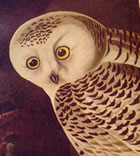
The Wise Owl Gazes Backward
Snowy Owl
John James Audubon
The Birds of America, 1827
Starting Position: Wu Ji
Movement Name: The Wise Owl Looks from Side to Side, the Wise Owl Gazes Backward
Left and step with left foot and place your feet at a shoulder's width apart.
Look straight ahead and gaze at some distant point.
Hands at hips with your palms facing down. Press down with palms.
Stand up straight. Relax. Lift your head up, chin tucked in a bit. Smile.
Hips and butt are tucked in, sealing the pelvic floor.
Don't move your shoulders or back much during the exercise.
Inhale slowly.
Slowly and gently turn your head to the left side.
Look behind you as far as you can; turn your eyes to the far left.
Gaze into the distance behind you at some point on the ground.
Exhale slowly as you look behind you.
After you have completely exhaled, then begin to slowly inhale, and return your head slowly and gently to the front.
Look straight ahead and gaze at some distant point.
Slowly and gently turn your head to the right side.
Continue to slowly inhale as you turn your head to the right.
Look behind you as far as you can; turn your eyes to the far right.
Gaze into the distance behind you at some point on the ground.
Exhale slowly as you look behind you.
After you have completely exhaled, then begin to slowly inhale, and return your head slowly and gently to the front.
Look straight ahead and gaze at some distant point.
Repeat the movement, gazing to the front, left rear, and right rear, from 4 to 8 times.
As you warm up your neck muscles, turn a little farther to side and back.
Be gentle with yourself, move very slowly.
Be sure to gaze as far backward and downward as possible when looking to the back.
Breath naturally, easily, slowly.
Inhale slowly as you move your head from side to side.
Exhale slowly as you look backward.
Imagine yourself as a wise old owl turning his head from side to side. Imagine having the powers of distant vision and the kind of night vision of some birds of prey possess.
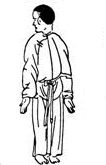
Return you left foot back into the Wu Ji position to rest and realign the body-mind.
Wu Ji signals the end of one movement and the beginning of the next movement.
Enjoy some cleansing breaths. Opening/Closing.
Stand up straight and tall. Lift the head. Tuck the chin inward a little.
Loosen Up, Soften, Merge and Relax.
Feel yourself sinking and rooting into the Earth.
Variations of Movement 4 (Wise Owl Looks Backward) The Eight Section Brocade Chi Kung
a)
Hold your arms up at shoulder height, elbows bent, and palms facing forward.
Slowly turn your torso at the waist to the left and move your left arm to the back.
Turn your head to the left and look backward.
Keep your feet at shoulder width.
Turn your neck to the side and back as you turn your waist.
Repeat the movement to the other side.
Move slowly and gently!
Do not make this into the dangerous and vigorous calisthenics exercise called "The Windmill."
Gently stretch the waist, back and neck.
Repeat 6 to 8 times on each side.
b)
Lift your arms and place your palms together at shoulder width height. Extend your left leg forward as you move your left arm backward. Place your left toe on the ground at a comfortable distance in front to maintain your balance. Turn your torso to the left side and backward. Look at your left hand behind you. The right arm should remain in front at shoulder height. When the arms are extended the hands should be open, all the fingers spread wide apart, the fingers pointing up, and the wrist flexed, and forearm tensed - "willow leaf palm." Stay balanced. Return the left arm back to the front, and look at both hands in front. When the hands come to the front, only the thumb and pointer finger should touch, forming a triangle with the two hands. Move the left leg back to a shoulder width stance. Keep the weight more in the back leg.
Extend your right leg forward as you move your right arm backward. Place your right toe on the ground at a comfortable distance in front to maintain your balance. Turn your torso to the right side and backward. Look at your right hand behind you. The left arm should remain in front at shoulder height. Hands should be in the "willow leaf palm" or "starfish" hand position - fingers spread wide, tensed, and pointing upwards. Relax - Soong! Stay balanced. Return the right arm back to the front, place both hands together in a triangle mudra (hand sign), and look at both hands in front. Move your right leg back to a shoulder width stance. Keep the weight more in the back leg. Repeat 6 to 8 times on each side.
Compare this movement variation with the "Topple Mountain Range with Palm" movement in the Luohan Qigong system taught by Dr. Gaspar Garcia.
This variation is one of my favorites and I often add this to the ESB set or use this to replace ESB Movement 3. This variation requires considerable balance, gracefulness, and poise. Basically, it is a spinal twisting movement, and students of Hatha yoga have "spinal twists" in standing, seating, and prone versions. I use the same movement in myDragon Chi Kung, Movement 4, The Black Dragon Walks at the Edge of the Abyss.
c) This movement can be done when walking. Turn your head from side to side and gaze backward. Allow you arms to swing naturally as you walk forward. Keep your torso facing forward; only turn your head from side to side and look backward.
d) This movement can be done while seated. Move slowly! Move gently.
e) Place your right hand behind your head. Keep your right elbow up. Gently hold your head. Turn your head to the left and look backward. Exhale as you turn your head and look backward. Lift your right elbow up slightly as you inhale and as you move your head forward. Inhale as you turn your head forward. Do 6 to 8 eight repetitions. Reverse hands and to 6 to 8 eight repetitions looking to the right side with left elbow up.
f) Shoulder width stance. Open both arms out, up, and back. Bend backwards gently. Turn the head to the right side, looking back and up, back bent, arms open wide, then hold. Return arms to front and look forward. Repeat movement to the left side. Wild Goose Qigong does this kind of movement.
Health Benefits of Movement 4 (Wise Owl Looks Backward) The Eight Section Brocade Chi Kung
Exercises the neck muscles.
Exercises the eye muscles.
Balance and brain functions are improved by coordinated movements.
Stretching helps contribute to the relaxation of stiff and tense muscles.
A clear and peaceful mind reduces negative stress on the body.
Using both sides of the body (mirroring in a movement form) can have positive effects on the structural alignment of the body and enhance coordination.
Slow, deep and regular breathing brings extra oxygen into your blood.
Disclaimer.
Ba Duan Jin Exercise Set 4 "Relieving the exhaustion of the five internal organs and injuries caused by the seven human emotions, by practicing looking backward. The Ba Duan Jin Exercise Set 4 is one of the most potent of the eight exercises. It has a powerful effect on your central nervous system and the circulation of both blood and Chi to your head. It stimulates the vital power of your kidneys. It also strengthens the activity of your eyeballs, your neck and shoulder muscles, and your nerves, and is excellent for alleviating high blood pressure and hardening of the arteries." - Chinese Acupuncture and Chinese Medicine
References for the Names of Movement 4 (Wise Owl Looks Backward)
Eight Section Brocade Chi Kung (See below for reference sources.)
Turn Head to Look Back to Allay Five Strains and Seven Impairments. (Zong Wu and Li Mao, R1)
Looking Back like a Cow Gazing at the Moon. (Lam Kam Chuen, R2)
Thrust out the Chest and Twist the Neck to take a Good Look to the Rear.
The Five Weaknesses and Seven Injuries will be Gone. (Yang Jwing-ming, R3)
Eye of the Tiger. (Geoff and Phyllis Pike, R4)
Looking Backward to Get Rid of Weary and Injurious Feelings. (PRC Publication, R5)
Looking Behind to Cure Fatigue and Distress. (Kenneth Cohen, R6)
The Wise Owl Gazes Backward. (Michael Garofalo, R7)
Turning the Head and Looking Behind. (Sanley Wilson, R8)
Turn and Glance to Eliminate the Five Ailments and Seven Dangers, (Daniel Reid, R9)
Looking Backwards to Mend the Body (Jiao Guorui, R10)
Turning Head. (Wong Kiew Kit, R11)
Turning Your Head to Tonify the Nervous System. (Maoshing Ni, R12)
Looking Backwards to Prevent Sickness and Strain (Chinese Health Qigong Association, R13)
Names of the movements of the Eight Section Brocade Chi Kung in languages other than English.
Comments about Movement 4 (Wise Owl Looks Backward)
Eight Section Brocade Chi Kung
Persons with neck ailments should be very careful when doing this movement. Turn very little!! Move very slowly. Take your time, don't rush, be patient. Do not bend your head backward towards your back - this hyper extends the neck and puts stress on the vertebrate in the neck. Keep your head up straight, chin slightly down and just turn your head from side to side.
Every beginner should stay within their comfort zone, don't over stretch, and be gentle with your body and mind. Don't try to "exactly" imitate a fellow student who is an intermediate or advanced Chi Kung player or the teacher. Know and respect your own body and mental state. Don't go beyond your own personal bodily conditioning, skills, abilities and limits. Some advise reducing your exertion levels and doing 30% to 40% less than you can do. Be reasonable and kind to yourself. Take your time, advance slowly, be careful, be patient, and remain injury free. Sometimes, an old or new injury, or joint disease, will limit your range of motion. Know your own strength and limitations - the practice ofChi Kung andTai Chi forms will reveal to you your strengths and limitations. Resolve to make two positive contributions today. Stay within your comfort zone, explore with the body-mind, and renew-recreate both self-awareness and awareness of Self, and come to experience your comfort zone. Float on the Wu-wei raft on the Tao River; when standing on Earth thenroot,soften,move.
"Gently Shake the Heavenly Pillar means to crick and move the neck. Properly, the neck is cricked to the left and right sides along with a gazing procedure. The two shoulders are followed by the gaze when swaying. The left and right sides are counted separately, with each side being performed twenty-four times, and collectively forty-eight times. This cricking of the neck, swaying of the shoulders, and gazing in accordance with the movements in effect remove the fire of the heart and eliminate any invasions or disturbances of external malignant spirits."
- Master Li Ching-yun, Translated by Stuart A. Olson.
Really turn the eyes to the side as you look down and backwards. Exercise the eyes!
"Referring to the seven factors causing impairments by overstrain, viz., [1] overfeeding that impairs the spleen; [2] fury that causes adverse flow of Qi and impairs the liver; [3] forced overloading or prolonged sitting in damp places that injures the kidneys; [4] cold weather or drinking cold beverages that injures the lungs; [5] sorrow and anxiety that injure the heart; [6] wind and rain, cold and summer-heat that impair the constitution; and [7] great shock and intemperance that impair mentality."
- Ancient Way to Keep Fit, compiled by Zong Wu and Li Mao, 1992, p. 113. - Regarding "Turn Head to Look Back to Allay five Strains and Seven Impairments."
"Fourth Movement: Five Weaknesses and Seven Injuries Disappear, Look Behind You. Look Backwards as Much as You Might, Will Recover Your Body From Tiredness Quite." - Philip Bonifonte
5. The Big Bear Turns from Side to Side
Starting Position: Wu Ji
From the Wu Ji position step out with your left foot into a horse stance. Your feet should be wider than shoulder width. Feet can be pointing straight ahead or pointing out from your body at a 45� angle. The knees should be bent as you squat down. The depth of the squat will depend upon your level of conditioning and any body mechanics or injury issues you may have. Try to squat down a little more with every second repetition of this exercise. Back should be straight, Torso should be centered and upright. Rest your hands on the sides of your thighs. Your elbows should be pointing our to the sides at a 90� angle from the direction you are facing (if you are facing north, your right elbow would point to the east and the left elbow to the west). Take a wide angle and soft focus with your eyes. Breath naturally, deeply, and comfortably - as you bend down breathe out, inhale when facing to the
sides.
Movement: The Big Bear Turns from Side to Side
Face north.
Keep your hands on the sides of your hips throughout this exercise.
Slowly turn your waist to the left until your chest is facing east.
Your right elbow should be pointing north and you should have your head turned and looking north.
Inhale completely.
Slowly turn to the right as you bend forward to the front.
Exhale as you move to the right side towards the west.
When you are facing north in the middle, your head and shoulders should be at the lowest point bending forward.
Continue turning your waist to the right and lifting the upper torso.
Slowly turn your waist to the right until your chest is facing west.
As you turn to the right your left knee will bend more.
Your left elbow should be pointing north, and you should have your head turned and looking towards the north.
Inhale completely.
Slowly turn to the left as you bend forward to the front.
Exhale as you move to the left side towards the east.
When you are facing north in the middle, your head and shoulders should be at the lowest point bending forward.
Continue turning your waist to the left and lifting the upper torso.
Slowly turn your waist to the left until your chest is facing east.
As you turn to the left your right knee will bend more.
Your right elbow should be pointing north, and you should have your head turned and looking towards the north.
Inhale completely.
Repeat the movement, back and forth, from side to side, for a number of repetitions, preferably eight times to each side.
Get the feel of slowly swinging from side to side. Keep the posture erect as you face east and west, and bend the head and shoulders and back down as you move towards the front (north). High, low, high.
Turn at the waist. Swing from side to side using the waist. Stay centered in your waist.
Exercise the middle of your body: waist, hips, lower abdominals, groin.
Demonstration by Mike Garofalo of Movement #7: Big Bear Turns to the Left Side and Back
115Kb, Animated GIF.
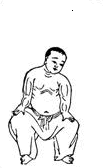
Return you left foot back into the Wu Ji position to rest and realign the body-mind.
Wu Ji signals the end of one movement and the beginning of the next movement.
Enjoy some cleansing breaths. Opening/Closing.
Stand up straight and tall. Lift the head. Tuck the chin inward a little.
Loosen Up, Soften, Merge and Relax.
Feel yourself sinking and rooting into the Earth.
Free up the mind, reduce thinking, forget, become outside more.
Variations of Movement 5 (The Big Bear Turns from Side to Side) The Eight Section Brocade Chi Kung
a)
Assume the horse stance.
Place your hands on the center of your thighs, palms down, thumb on the outside of the thigh and four fingers on the inside of the thigh.
Turn the head and shoulders to the left side and the waist to the left side.
Push down into the right leg as you turn to the left.
Turn the right shoulder towards the left. Return to center. Repeat by turning to the right side.
Turn and swing from side to side. Don't bend low when in the middle.
Keep the torso upright throughout the exercise.
Keep your spine, neck and head in one plane, in-line, upright.
The Big Bear Turns From Side to Side, #7
Drawing by Nadezda Kotrchova
Shaking the Head and Wagging the Tail to Eliminate the Heart-Fire
Health Benefits of Movement 5 (The Big Bear Turns from Side to Side) The Eight Section Brocade Chi Kung
Most of the Eight Section Brocade Chi Kung,Animal Frolics Chi Kung, and traditional Chinese medical literature says that this exercise benefits the heart, and gets rid of "heart fire." Exercising the lungs (metal) helps absorb the heat and control the fire, the heart fire - heartburn (Hsin For - heart fire).
The horse stance will strengthen and condition the legs and lower back.
Moving while in deeper horse stances will have some aerobic conditioning effect if the exercise is done with many repetitions.
Bending and turning at the waist will strengthen and stretch the hip, abdominal, and lower back muscles.
The upper back and triceps will be tightened and stretched as you turn and look forward when facing the side.
The spine is gently turned to effect realignment and prevent stiffness.
Squatting down exercises theleg muscles including the thighs (quadriceps), hamstrings (biceps femoris), buttocks (glutes), calves (gastrocnemius), iliopsoas, and increases demands on the cardio-vascular system.
Counter indications: Persons with uncontrolled blood pressure should not have their head lower than their heart. Persons with hip, abdominal or lower back injuries should avoid deep bends from the waist.
I interpret this exercise as primarily waist training. Many Chinese exercises focus on bending, turning, twisting, swinging, or moving from the waist. Yogaand Pilates also use many exercises that strengthen the mid-section of the torso, one's Powerhouse, through exercises that involve bending or turning at the waist. Dragon Chi Kung also exercises with turning, twisting, spiraling, and swinging movements.
"Fifth Movement: Sawy the Head and Swing the Tail. By Turning Your Head and Wagging Your Butt, To a Degree Finite, Your Ill-Temper Will Say, "Good Night." - Philip Bonifonte
"Thus, exercising the waist area regularly will enable ch'i to circulate freely in the Tu Mo and will also stimulate the Shen Yu point. As a result, the kidneys will be full of energy. Since the kidneys store _ching_- the fundamental substance - it follows that when the kidneys have and abundant supply of energy, then ching ch'i, the essential energy of life, will also be richly available. And yuan ch'i, the primary vital energy, will be vigorous in the maintenance of health. For this reason, the traditional Chinese fitness exercises pay special attention to the training of the waist region."
- Knocking at the Gate of Life, 1985, p. 33. Chinese Waist Training Theory
Ba Duan Jin Exercise Set 5: "Shaking the head and wagging the tail to remove excess heat from the heart. The Ba Duan Jin exercise set 5 prevents against fever and reduce tension in the sympathetic nervous system. It certainly has a powerful relaxing effect and, as such, eases the flow of energy along a number of your body's meridians." - Acupuncture and Chinese Medicine.
References for the Names of Movement 5 (The Big Bear Turns from Side to Side) The Eight Section Brocade Chi Kung
(See below for reference sources.)
Shake Head and Sway Buttocks to Extinguish Fire in Heart. (Zong Wu and Li Mao, R1)
Lowering the Head and Hips Removes Excess Heat from the Heart. (Lam Kam Chuen, R2)
Sway the Head and Swing the Tail to Get Rid of the Heart Fire. (Yang Jwing-ming, R3)
Search the Clouds. (Geoff and Phyllis Pike, R4)
Wagging Head and Tail to Eliminate the Heart's Flame. (PRC Publication, R5)
Bending Over, Wagging the Tail to Calm Heart-Fire. (Kenneth Cohen, R6)
The Big Bear Turns From Side to Side. (Michael Garofalo, R7)
Bending the Trunk and Stretching the Neck. (Stanley Wilson, R8)
Turning the Head and Twisting the Tail to Expel Fire from the Heart. (Daniel Reid, R9)
Shaking the Head and Wagging the Tail to Dispel Heart Fire (Jiao Guorui, R10)
Swaying the Spinal Column to Take Away Heart Fire. (Maoshing Ni, R12)
Swinging the Head and Lowering the Body to Relieve Stress (Chinese Health Qigong Association, R13)
The Constant Bear
Names of the movements of the Eight Section Brocade Chi Kung in languages other than English.
Comments about Movement 5 (The Big Bear Turns from Side to Side) The Eight Section Brocade Chi Kung
Please refer to my comments about The Bear of the Five Animal Frolics.
Every beginner should stay within their comfort zone, don't over stretch, and be gentle with your body and mind. Don't try to "exactly" imitate a fellow student who is an intermediate or advanced Chi Kung player or the teacher. Know and respect your own body and mental state. Don't go beyond your own personal bodily conditioning, skills, abilities and limits. Some advise reducing your exertion levels and doing 30% to 40% less than you can do. Be reasonable and kind to yourself. Take your time, advance slowly, be careful, be patient, and remain injury free. Sometimes, an old or new injury, or joint disease, will limit your range of motion. Know your own strength and limitations - the practice ofChi Kung andTai Chi forms will reveal to you your strengths and limitations. Resolve to make two positive contributions today. Stay within your comfort zone, explore with the body-mind, and renew-recreate both self-awareness and awareness of Self, and come to experience your comfort zone. Float on the Wu-wei raft on the Tao River; when standing on Earth thenroot,soften,move.
Cheng Man-ch'ing: Master of Five Excellences. Translation and commentary by Mark Hennessy. Berkeley, California, Frog, Ltd., 1995. On pages 113-117, there is "An Explanation of the "Constant Bear." Cheng Man-ch'ing (1901-1975) was a famous Taijiquan master and Doctor of Traditional Chinese Medicine. "It means "ch'ang" or constant, and refers to the constant, daily swinging to and fro of the bear's waist. So, this move should be called The Constant Bear. The Constant Bear combines the Five Animal Frolics and t'aichi into a single move." p. 114 "I bequeath the Constant Bear movement to the elderly, the sick, and the frail.
It is a wonderful, traditional exercise which is both simple and easy. You can also use it for self-defense until you are years old. All this is easily obtained. Although my explanation is short and simple, if you understand its principles and practice with perseverance, after as few as one hundred days of moving your ch'i, you will notice a marked improvement in health and strength and no longer need to worry about illness. It is truly a "sacred raft" to strengthen our bodies and bears no semblance to other well know yet inferior exercises." p. 115
6. Punching with an Angry Gaze
S tarting Position: Wu Ji
Movement Name: Punching with Angry Eyes, Purging Anger from the Liver
Movement
Step out to the left into a horse stance: feet pointing forward, feet at more than shoulder width, knees bent, back straight, head up, eyes looking forward, shoulders relaxed.
Hips are raised, butt tucked, and lower back strong.
Arms are positioned at the waist. Hands are held in a soft and relaxed fist. Palms are up.
Slowly extend the right arm to the front, turning the fist as the arm moves forward. The arm should be gently lifted up and extended. The arm should end at about chest level. The fist should be palm down at the end of the extension. Do not use intense and powerful muscular force to strike forward.
Exhale through the mouth as the arm moves out, inhale through the nose as the arm moves in. The lips should be slightly parted, with the tongue at the top of the mouth.
Eyes should be wide open, staring forward, and the gaze should be intense. Open the eyes really wide! Project fire, fierceness, toughness, determination and courage through your eyes. Glare at your opponent.
Clench your teeth, part your lips - snarl!
Imagine that energy is projected outward from the fist and moves into an imaginary opponent. This energy travels along a path set by your stare.
The right arms returns to the waist as the left arm duplicates the previous movement of the other arm. The combined movement results in alternating soft punches by each arm.
Repeat the soft punch with each hand for a number of repetitions: 2, 4, 8, 16, 36, etc
Stay relaxed, keep your head up, and keep your back straight.
Generally, exhale as you strike something. Inhale as you gather your energy before a strike.
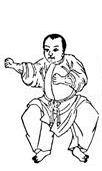
Return you left foot back into the Wu Ji position to rest and realign the body-mind.
Wu Ji signals the end of one movement and the beginning of the next movement.
Enjoy some cleansing breaths. Opening/Closing.
Stand up straight and tall. Lift the head. Tuck the chin inward a little.
Loosen Up, Soften, Merge and Relax.
Feel yourself sinking and rooting into the Earth.
Free up the mind, reduce thinking, forget, become outside more.
Variations of Movement 6 (Punching with Angry Gaze) The Eight Section Brocade Chi Kung
a) Sink lower in the horse stance every 2 to 4 punches. The lower the horse stance the more physically demanding the exercise because of the tension in the quadriceps.
b) Some hold the hands at the waist in a open position with the fingers pointed forward. When the arm is extended, the hand moves to strike with the palm and with the fingers up. The movement is still done slowly and gently, but palm rather than fist strikes are used.
c) Chi Kung movements are generally done in a relaxed, soft, and gentle manner. However, if your spirit is in a Yang mode and your energy high, you might sometimes punch with a bit more gusto. If the intent is to develop speed, power, and throw the fire of anger outward, then some additional energy must be used and projected, in addition to sinking even lower in the horse stance, and opening the eyes wider. This kind of dynamic and forceful punching is sometimes referred to as punching with fa-jing (emitting jing energy).
d) Some stand in a shoulder width stance, knees only slightly bent. They gently rise up and down as punches are made, rising up and exhaling as the punch goes out.
e) Right fist is at the right side of your waist. Palm strike straight in front with the left hand. Make a fist with the left hand, turn the left wrist over and backfist strike with the left fist. Pull the left arm back to left side of your waist, left fist up at side. As left arm comes back, strike forward with a right palm strike. Make a fist with the right hand, turn the right wrist over and backfist strike with the right fist. Pull the right arm back to the right side of your waist, right fist up at side. As the right arm comes back, strike forward with a left palm strike. Repeat! Repeat back and forth, alternating arms. Inhale as you turn your wrist, exhale forcefully as your backfist and then palm strike. I like this variation the best while walking.
f) In the autumn and winter of 2017, five of us (David, Joel, John, Mike, and George) practiced the _Ba Duan Jin_led bySifu David Fetyko in Vancouver, Washington. In this version, for this movement sequence, we stood in a wide horse stance. Fists were at our waist, with glaring focused eyes, we slowly punched out with one arm, and ended the punch with our thumb up. We then opened the hand as we turned the palm outward, extending the thumb downward. Then, gently turn the wrist, fingers relaxed, until the palm faces upward. Move the thumb to the center on the palm, then curl the fingers over the thumb. Then draw the fist back to the waist. Alternating arms, do the same movement sequence with the other arm.
[My own arthritic fingers favor a supplementary wrist exercise: 1. make a fist with the thumb closed over the fingers, 2. open the fingers, relax fingers, palm up and open, 3. make a fist with the fingers closed over the thumb, 4. open the fingers, relax the fingers, palm up and open, 5. alternate between 1. and 3. Do both right and left hands.]
g) Punching from a horse stance, or a lunge stance, or boxers stance (e.g., Play the Pi Pa) is a standard training technique in all martial arts. Likewise, in cane weapon techniques, we practice different striking (punching, attacking, blocking) techniques.
Health Benefits of Movement 6 (Punching with Angry Gaze) The Eight Section Brocade Chi Kung
Horse stances strengthen the thighs, back, and cardiovascular system.
Shoulders and wrists are exercised.
Balance and coordination are improved.
Angry and tense feelings are vented, released, and dispelled.
Eye muscles and face muscles are exercised.
Breathing is deep and frequent - additional oxygen is supplied to the blood.
In traditional Chinese medical theory this movement helps stimulate and revitalize the liver.
Emulation of the fighting spirit helps engender courage and toughness.
Squatting down exercises theleg muscles including the thighs (quadriceps), hamstrings (biceps femoris), buttocks (glutes), calves (gastrocnemius), iliopsoas, and increases demands on the cardio-vascular system.
Ba Duan Jin Exercise Set 6: "Touching the feet with both hands to rid the heart of its illness. The Ba Duan Jin exercise set 6 is good for the muscles of your lower back and legs and for stretching your spine. It is also beneficial for the internal organs of your lower abdomen. The movements of your waist actually bring every tissue and organ of your abdomen into play. The whole exercise strengthens your kidneys, your adrenal glands, and the arteries, veins, and nerves associated with them. Since your kidneys playa vital role in regulating the water metabolism of your entire body, this exercise helps maintain a healthy balance in your internal environment."
References for Names for Movement 6 (Punching with Angry Gaze) The Eight Section Brocade Chi Kung
(See below for reference sources.)
Clench Fists and Look Angrily to Build Up Physical Strength. (Zong Wu and Li Mao, R1)
Clenching the Fists Increases Strength. (Lam Kam Chuen, R2)
Screw the Fist with Fiery Eyes to Increase Chi Li. (Yang Jwing-ming, R3)
Grip the Swallow's Egg. (Geoff and Phyllis Pike, R4)
Holding Fists and Opening Angry Eyes to Increase Physical Strength. (PRC Publication, R5)
Punching with Angry Gaze to Increase Qi and Strength. (Kenneth Cohen, R6)
Punching with an Angry Gaze. (Michael Garofalo, R7)
Punching with Angry Eyes. (Stanley Wilson, R8)
Twisting the Fist and Focusing Fierce Eyes to Cultivate Energy and Generate Power. (Daniel Reid, R9)
Clenching the Fists and Stretching the Arms for Strength (Jiao Guorui, R10)
Thrust Punch. (Wong Kiew Kit, R11)
Clench the Teeth, Widen the Eyes, and Strike in Four Directions. (Maoshing Ni, R12)
Thrusting the Fists and Making the Eyes Glare to Enhance Strength (Chinese Health Qigong Association, R13)
Clench the Fist, Zhuan Quan Shi (Shifu Yan Lei, R14)
Names of the movements of the Eight Section Brocade Chi Kung in languages other than English.
Comments about Movement 6 (Punching with Angry Gaze) The Eight Section Brocade Chi Kung
This movement (#6) can be done very slowly and one can imagine sending energy outwards, or a powerful beam of chi-light from your hand. One of my teachers had us punch softly, but asked us to imagine our energy blasting through the brick wall of the dojo. Or, this movement can be one of really punching with some force with intense and angry eyes.
"Screw the Fists with Fiery Eyes. With Your Fiery Eyesight, as If You're Doing a Fist-Fight; the Way to Develop Your Strength by Making You Excite." - Philip Bonifonte
Compare this movement (#6) with the one described by Rachel Schaeffer in her informative and beautiful book "Yoga for Your Spiritual Muscles." p. 118. She calls the movement "Hara Punches and Hara Pulls." She says that "hara is the Sanskrit word for the area of the body (around the abdomen) from which life energy emanates. Focus on drawing power from this area as you imagine you are throwing away tensions with each punch. Apply your robust presence to push stress away from your physical and mental being. As you pull your hands to you belly, visualize that you are drawing into your body strength and energy from the abundance of the universe." I believe hara is the Japanese word for the area of the Dan Tien or "elixir field" (丹田) spoken of by Chinese Taoists, or, that area spoken about in Kundalini or Tantric Yoga, and referred to as the Manipurna Chakra or
"jeweled city."
Every beginner should stay within their comfort zone, don't over stretch, and be gentle with your body and mind. Don't try to "exactly" imitate a fellow student who is an intermediate or advanced Chi Kung player or the teacher. Know and respect your own body and mental state. Don't go beyond your own personal bodily conditioning, skills, abilities and limits. Some advise reducing your exertion levels and doing 30% to 40% less than you can do. Be reasonable and kind to yourself. Take your time, advance slowly, be careful, be patient, and remain injury free. Sometimes, an old or new injury, or joint disease, will limit your range of motion. Know your own strength and limitations - the practice ofChi Kung andTai Chi forms will reveal to you your strengths and limitations. Resolve to make two positive contributions today. Stay within your comfort zone, explore with the body-mind, and renew-recreate both self-awareness and awareness of Self, and come to experience your comfort zone. Float on the Wu-wei raft on the Tao River; when standing on Earth thenroot,soften,move.
Michael P. Garofalo's: Cloud Hands Blog Facebook Hypertext Notebook's Index

This webpage work is licensed under a Creative Commons Attribution-NonCommercial-NoDerivatives 4.0 International License,� 2018 CCA 4.0
Michael P. Garofalo, M.S., Green Way Research, Valley Spirit Center, Gushen Grove, Vancouver, Washington
Green Way Research, � 2000-2019.
7. Touching the Toes then Bending Backwards
| Touching the Toes then Bending Backward Eight Section Brocade Chi Kung Opening and Movements |
|---|
| From the Wu Ji position step out with your left foot about 6" to 12". Your stance should be comfortable. Your feet should point straight ahead. Bend the knees slightly. Relax the shoulders. Let your arms relax at your sides and the inside of your hands touch your hips. Breathe easily and deeply. Inhale through the nose and out through the nose. Take a long, deep, slow inhale and relax and extend your abdomen as you inhale. Begin to exhale as you move down |
Slowly bend forward from the hips as your hands move slowly down the outside of your legs. Both hands should remain touching your body during this entire exercise movement. Feel your body with your hands, and feel your hands with your body. Slowly exhale as you bend forward, and draw the abdomen inward. Continue to move the hands down the sides of the legs as you bend forward. Bend your knees! Lower your head, relax your shoulders and back. Move both hands down until you reach your ankles. Hold for a few seconds in this low position. Slowly move both of your hands up the back of the legs as you unbend and lift your head and back. Keep the knees bent. Slowly trace the hands up the hamstrings and up over the glutes. Slowly inhale as you bring your hands from your ankles to your lower back. Place the hands on the lower back. The back of the hands should touch the area in the lower back about where the kidneys are located. Massage the lower back by moving the back of the hands in semi-circles. Gently massage the area behind the kidneys. Stand up straight, but not rigidly. Lift the head. Relax the shoulders. Enjoy this gentle lower back massage for 30 seconds or more. Breathe freely. This massage movement is also know as "Rub the Court of the Kidneys." Slowly and gently bend backwards, keeping your hands on your lower back. Look upwards and backwards as you bend backwards. Be careful, be gentle with yourself, know your limits, don't overdo, don't push (allow wu wei). Lift your chest upwards and back. Your head should bend back gently. Bend your back and neck only to the degree that you feel safe and comfortable. Hold for 20 seconds or more. Keep the backs of your hands on your lower back. Breathe freely. Slowly unwind forward as your hands move from your back, along your sides, and to the front of the hips. Gently straighten the back and neck till you are standing up straight. Relax your shoulders. Smile. Enjoy a long, deep, and slow inhale. Rest in Wu Ji as needed. Repeat this movement sequence 4 to 8 repetitions. Move slowly. Don't jerk. Relax,Center,Ground.  Return you left foot back into the Wu Ji position to rest and realign the body-mind. Wu Ji signals the end of one movement and the beginning of the next movement. Enjoy some cleansing breaths. Opening/Closing. Stand up straight and tall. Lift the head. Tuck the chin inward a little. Loosen Up, Soften, Merge and Relax.Feel yourself sinking and rooting into the Earth. Free up the mind, reduce thinking, forget, become outside more. Return you left foot back into the Wu Ji position to rest and realign the body-mind. Wu Ji signals the end of one movement and the beginning of the next movement. Enjoy some cleansing breaths. Opening/Closing. Stand up straight and tall. Lift the head. Tuck the chin inward a little. Loosen Up, Soften, Merge and Relax.Feel yourself sinking and rooting into the Earth. Free up the mind, reduce thinking, forget, become outside more.  |
| Variations of Movement 7 (Touching the Toes then Bending Backwards) The Eight Section Brocade Chi Kung |
Some emphasize striving to bend forward while keeping the legs straight. Caution is advised for those with weak or out of condition muscles. This kind of "touch your toes" callisthenic can be harmful to the lower back and/or hamstrings. Some teachers will emphasize the Meridian pathways that the fingers should follow as they move up and down the legs, or press on in the back. For example, the Kidney Meridian runs along the inside of both legs, the Gallbladder Meridian runs along the outside center of both legs, the Bladder Meridian runs along the back center of both legs, and the Stomach Meridian runs along the front center of both legs. Following these Meridian pathways with your fingers and hands stimulates and invigorates these specific organ systems. Numerous charts of the Meridian pathways and books on the subjects are now available in English. Some do not massage the lower back in the middle of the movement. Many emphasize lowering the torso until you can place your fingers under your toes. This is fine if you keep your knees bent sufficiently while in the forward bend. The movement then becomes more of a squat. Some recommend keeping the feet together and the knees straight when bending down. Some start the movement by drawing both hands up above the head and reaching towards the heavens, and then lowering the arms forward and then down as the torso bends forward and down. This style is similar to the yoga movement in Uttanasana or at the start of the Sun Salutations, Surya Namaskar. In the autumn and winter of 2017, five of us (David, Joel, John, Mike, and George) practiced the _Ba Duan Jin_led bySifu David Fetyko in Vancouver, Washington. In this version, for this movement sequence, we stood in a shoulder width stance. Hands would be drawn upward in front then down. The hands then turn upward, fingers pointed backwards, hands drawn backward along side the rips. Then, massage the kidneys. Draw the hands down the back of the legs, then touch the toes. Extend the arms forward and bend from the waist to raise the arms. Breathe comfortably. Not much of a back bend in this version.  |
| Health Benefits of Movement 7 (Touching the Toes then Bending Backwards) The Eight Section Brocade Chi Kung |
Stretching and lengthening the muscles of the lower back. Inversions bring more blood into the upper torso. Works both the quadriceps and hamstrings. Both hip flexors and abductors are challenged. Massage increases circulation and feelings of pleasure to the lower back area. Back bends strengthen both the abdominal and lower back muscles. Stimulates various meridians in the body. Counter-indications: Persons with uncontrolled high blood pressure problems should avoid moving their head below their heart. Persons with lower back stiffness or pain should avoid bending forward or backward too deeply from the waist. Avoid bending forward with the knees locked in a straight position as this places undue stress on the lower back and hamstrings. Heavy persons should use caution when bending with arms extended out from the body - keep the arms close to the torso to decrease the leverage stresses. Make sure you are thoroughly warmed up before doing forward bends. This is one reason why this movement is most often placed nearly at the end (#7) of the workout routine. Disclaimer Ba Duan Jin Exercise Set 7: "Clenching fists and glaring to increase physical strength. The Ba Duan Jin exercise set 7 develops the flow of Chi from your feet through your entire body and extends it through your hands and eyes. It excites your cerebral cortex and related nerves, and speeds the circulation of blood and oxygen in your cardiovascular system. This is not a punching exercise - it is designed to strengthen the flow of your internal power: it must be done slowly and calmly with great concentration. Each movement begins gently and the full power comes in only at the end of each extension." - Acupuncture and Chinese Medicine.  |
| References for the Names of Movement 7 (Touching the Toes then Bending Backwards) The Eight Section Brocade Chi Kung (See below for reference sources.) |
Touch Toes to Reinforce Kidneys. (Zong Wu and Li Mao, R1) Touching the Feet with Both Hands Reinforces the Kidneys and Loins. (Lam Kam Chuen, R2) Two Hands Hold the Feet to Strengthen the Kidneys and Waist. (Yang Jwing-ming, R3) Touch the Sky, Press the Earth. (Geoff and Phyllis Pike, R4) Reaching Toes with Both Hands to Strengthen the Kidneys and Waist. (PRC Publication, R5) Toe Touching to Strengthen the Kidneys and Waist. (Kenneth Cohen, R6) Touching the Toes then Bending Backwards. (Michael Garofalo, R7) Touching the Toes and Arching the Back. (Stanley Wilson, R8) Embracing Legs with Two Arms to Make the Kidneys Firm and Stong. (Daniel Reid, R9) Touching the Feet to Strengthen the Kidney and Waist (Jiao Guorui, R10) Carrying the Moon, Nourishing the Kidneys. (Wong Kiew Kit, R11) Grabbing the Ankles to Strengthen Your Vital Force. (Maoshing Ni, R12) Moving the Hands Down the Back and Legs, and Touching the Feet to Strengthen the Kidneys (Chinese Health Qigong Association, R13) Hold Your Feet, Pan Jiao Shi (Shifu Yan Lei, R14) Names of the movements of the Eight Section Brocade Chi Kung in languages other than English.  |
| Comments about Movement 7 (Touching the Toes then Bending Backwards) The Eight Section Brocade Chi Kung |
Aspects of this movement and posture are quite familiar to students of Hatha Yoga. The first part of this movement is similar to the intense forward stretch posture, Uttanasana, or standing forward fold. Movement 7 in the Eight Section Brocade keeps the hands on the legs at all times during the forward bend; while the Yoga movement is more strenuous with the hands kept out from the body. The second part of this movement is similar to the first part of the camel posture, Ustrasana; although that posture is done while kneeling, and advanced forms of the camel pose involve a very deep back bend. When bending backwards, players are often advised to "tuck the hips" or "tense the butt." The same advice is often given by many instructors telling students how to do movements 1, 2, 4, 5 and 8 of the ESB qigong set. Similar advice is also given while performing other qigong and taijiquan exercises. This movement involves slightly rotating the hips forward and upward, tensing/flexing the gluteal muscles, squeezing/flexing the anal sphincter muscle as if you were holding in a bowel movement, slightly tensing/flexing the upper hamstrings, and slightly tensing/flexing the lower abdominal area and drawing it inward. This movement strengthens the pelvic diaphragm and the muscles of the pelvic floor, and is a way of "sealing" the anatomical perineum. The forward portion of the pelvic floor, the urogenital triangle, the genital muscles, are not tensed/flexible to any significant degree. Practitioners of Hatha yoga will recognize many similarities with the practice of the Ashwini Mudra (David Coulter, Anatomy of Hatha Yoga, 177-183). Martial artists also do related exercises to strengthen this area in preparation for kicking movements, and as a defensive response to being kicked in the groin area. "Lift and Touch Toes. Push the Sky and Reach Down to the Ground. Touch the Tip-Toes with Your Left and Right, Be Your Waist in Good Sight." - Philip Bonifonte Massaging the kidney area with the backs of the hands is a common self-massage technique found in many qigong sets. This movement "Touching the Toes and Bending Backwards" is very similar to the movements "Carrying the Moon" and "Nourishing Kidneys" 18 Lohan Hands Qigong. Every beginner should stay within their comfort zone, don't over stretch, and be gentle with your body and mind. Don't try to "exactly" imitate a fellow student who is an intermediate or advanced Chi Kung player or the teacher. Know and respect your own body and mental state. Don't go beyond your own personal bodily conditioning, skills, abilities and limits. Some advise reducing your exertion levels and doing 30% to 40% less than you can do. Be reasonable and kind to yourself. Take your time, advance slowly, be careful, be patient, and remain injury free. Sometimes, an old or new injury, or joint disease, will limit your range of motion. Know your own strength and limitations - the practice ofChi Kung andTai Chi forms will reveal to you your strengths and limitations. Resolve to make two positive contributions today. Stay within your comfort zone, explore with the body-mind, and renew-recreate both self-awareness and awareness of Self, and come to experience your comfort zone. Float on the Wu-wei raft on the Tao River; when standing on Earth then root,soften,move.  |
| Return to the Main Index |
8. Shaking the Body
Eight Section Brocade Chi Kung
Starting Position: _Wu J_i
Name of Movement 8: Shaking the Body, Rising Up on Tiptoes, Jolt the Body, Shaking the Pillar, Cure the 100 Ailments, Lifting the Heels
Here is how I was taught Movement 8 of the Eight Section Brocade Chi Kung back in 1985: Begin by standing in a relaxed and attentive manner, standing up straight, with your hands gently touching your hips. Slowly lift your heels off the ground and bring your weight down on the front sole of your feet. Stay still and balanced. Flex the wrists and push the palms down towards the earth as you rise up on your toes. Go to 40% of your maximum heel lift and pause for a three count, then rise up to 70% of your maximum and hold for a count of three. Lower your heel to 40% and pause for a three count. Finally lower both heels to the floor and rest. Repeat slowly rising your heels up and and down. Repeat the movement 4 - 8 times. There was no emphasis upon jolting, shaking, or bouncing of the body.
I've attended classes and workshops whereself-massage was introduced and practiced. Chinese selfmassage includes a more robust "patting" and "tapping" the body with the open palm. When we do the exercise "Ringing the Temple Bell", we swing from the waist and allow the arms to swing and "pat" or "slap" the pectorals and lower-middle back. Self-tapping in Chi Kung has healing routines to focus on specific energy pathways in the body as per Chinese acupressure massage or Chinese acupuncture theory and treatments. Martial artists "tap, slap, punch, grab, smack" the human body to develop martial skills, toughness, and conditioning.
I attended aHeavenly Essence Chi Kung, Part I, Workshop in October 2009 at the Green Gulch Farm, Green Dragon Temple, north of San Francisco. The workshop leader was Master Liping Julia Zhu, L.Ac, Internal Arts, from from San Francisco. She spoke positively about Shaking Chi Kung practices, and we practiced them. I saw Master Kevin Weaver of Red Bluff, California, do his version of Shaking the Body back in 2001. Master Robert Moore had us patting, tapping, bouncing and shaking in Chi Kung practices back in 1985.
I frequently call this exercise "Cure the 100 Ailments." Let's say you have to do 100 repetitions to "Cure the 100 Ailments." Sometimes I am quite content with just "Curing the 50 Ailments" and doing 50 repetitions.
The names used for Movement 8, Shaking the Body, are quite varied.
Jolt Body to Keep All Illnesses Away. (Zong Wu and Li Mao, R1)
Shaking the Body Wards Off All Illnesses. (Lam Kam Chuen, R2)
Seven Disorders and Hundreds of Illnesses Disappear and are Left Behind your Back. (Yang Jwing-ming, R3)
Lift the Rock. (Geoff and Phyllis Pike, R4)
Jolting the Back of the Body to Eliminate Disease. (PRC Publication, R5)
Reaching Down to Dissipate Disease. (Kenneth Cohen, R6)
Shaking the Body. (Michael Garofalo, R7)
Raising the Heels to Keep All Illnesses Away. (Stanley Wilson, R8)
Seven-Fold Spinal Stretch to Expel the Myraid Ailments. (Daniel Reid, R9)
Raising and Lowering the Heels to Cure Diseases (Chinese Health Qigong Association, R13)
Cure the 100 Illnesses.
Shaking the Pillar, Bouncing on the Toes, Lift the Heels
The active verbs include: jolt, shake, lift, bounce, raise, lower, etc. Therefore, my version of Movement 8 is as follows:
Movement 8, Shaking the Body Eight Section Brocade Chi Kung
Assume a cat stance with the right foot forward.
I turn my torso 45 degrees to the right side.
Place the right leg about a foot in front of the left leg.
You will adjust stances as you become more proficient with the movement skills.
The right foot should be on the toes, on the front sole of the right foot.
Most of the bodyweight should be on the back bent left leg.
Your arms should be at your hips, with your palms facing down.
Press down with your palms. Keep the wrists flexed.
Bend your knees and move your torso down.
Straighten your knees and move your torso up.
Always keep the knees slightly bent.
Raise your body up and down.
Your front heel moves up as you move up, and down as your body moves down, but does not touch the floor.
Your back left heel says flat on the floor.
Do 8 to 150 repetitions in a slow and deliberate manner, or in fast paced manner.
Breathe in as you move up; breathe out as you move down.
Bouncing up and down and jolting or shaking the internal organs in the torso is the signature feature of this movement.
Gaze out to infinity.
Try to Loosen and Soften (Sung).
Stretch and lengthen your spine as you move up on your toes.
Imagine energy from your body intermingling with energies from the Earth through theYong Quan (Bubbling or Gushing Well) acupressure and acupuncture point
on the front center of your feet. Yong Quan is an endpoint on the Kidney meridian.
Return to the starting position.
Assume a cat stance with the left foot forward.
I turn my torso about 45 degrees to the left side.
Place the left leg about a foot in front of the right leg.
The left foot should be on the toes, on the front sole of the left foot.
Most of the bodyweight should on the back bent right leg.
Your arms should be at your hips, with your palms facing down.
Press down with your palms. Keep your wrists flexed.
Bend your knees and move your torso down.
Straighten your knees and move your torso up.
Always keep the knees slightly bent.
Raise your body up and down.
Your front heel moves up as you move up, and down as your body moves down, but does not touch the floor.
Your back right heel says flat on the floor.
Do 8 -150 repetitions in a slow and deliberate manner or in a fast paced manner.
Breathe in as you move up; breathe out as you move down.
Gaze out to infinity.
Try to Loosen and Soften (Sung).
Stretch and lengthen your spine as you move up on your toes.
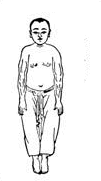
Return you left foot back into the Wu Ji position to rest and realign the body-mind.
Wu Ji signals the end of one movement and the beginning of the next movement.
Enjoy some cleansing breaths. Opening/Closing.
Stand up straight and tall. Lift the head. Tuck the chin inward a little.
Loosen Up, Soften, Merge and Relax.
Feel yourself sinking and rooting into the Earth.
Free up the mind, reduce thinking, forget, become outside more.
Variations of Movement 8 (Shaking the Body) The Eight Section Brocade Chi Kung
a)
Stand in a shoulder width stance. Your arms should be at your waist with palms down. Move up and down with your heels seven times. Flex and stretch the calf muscles and the Achilles tendon. Most qigong teachers start beginning students with their feet
in a shoulder width stance for this 6th movement of the Eight Treasures. Balancing is easier in a shoulder width stance. In this position, one is raising and lowering the heels off the ground, and not really bouncing. In the gym, with heavy weights on one's
shoulders, this exercise is called toe raises for the calves. Rise up as high as possible to stretch the calves and tendons of feet.
b)
Some do many repetitions of the movement. They bounce up and down in a rapid manner. Arms can be held in any position that enables you to keep your balance while bouncing. Some do up to 160 repetitions. Keep your eyes focused on a point in front of you to help you keep your balance. The faster you move, bouncing and pumping up and down on your toes, the movement involves the calves and thighs more and stretching the spine less. Some do some of the bouncing with all the weight on the back leg and the front leg raised off the floor. This is for advanced players!
c)
Some stand on one leg and do not bounce up and down. They sink the weight into the back leg, holding one knee raised high off the floor, Cheng Man-ch'ing says,
"The basic method for beginners is to take three to five minutes in the morning and evening and alternatively stand on one foot. Gradually increase the time and little by little sink deeper. Pay attention to sinking the _ch'i_into the tan-t'ien and to the sole of the foot sticking to the ground. Do not use the least bit of force. Standing in the "post" position, use your middle and index fingers to steady yourself again a chair or table so as to provide stability and balance. After some practice, eliminate the middle and use only the index finger to support yourself. After time, you will develop greater stability and will be able to forego all support and naturally stand steadily. After this, Raise Hands or Play Guitar to continue your standing practice."
- Cheng Man-ch'ing, Advanced T'ai-Chi Form Instructions, Wile 1985, p.24
d)
Some do only two repetitions, very slowly. They circle their arms up and back down the center of the body until they are positioned alongside the hips. They visualize the Qi energy of body and the earth interacting in a positive manner through the Bubbling Springs (Yung Chuan) points on the soles of the feet.
e)
In the autumn and winter of 2017, five of us (David, Joel, John, Mike, and George) practiced the Ba Duan Jin led bySifu David Fetyko in Vancouver, Washington. In this version, for this movement sequence, we slowly raised our heels up and then would suddenly drop the heels to the ground. We would jolt the legs and body as we dropped the heels. We stood in a comfortable shoulder width stance.
Health Benefits of Movement 8 (Shaking the Body) The Eight Section Brocade Chi Kung
The calves and thighs are exercised.
Raising your heel up and down using the resistance of your bodyweight and/or additional weights will strengthen and enlarge the calf muscles.
In Chinese medical theory, bouncing in this manner stimulates the immune system and helps rid the body of many diseases. Vibrating, shaking, or jolting the internal organs is considered to have positive health benefits in many Chinese Chi Kung systems and will "Cure the 100 Ailments."
The hips and lower back are exercised.
Stretching and lengthening the spine can align and strengthen the back.
The muscles in the feet and ankles are exercised and stretched.
The Achilles tendons are stretched.
Leg muscles are strengthened as more work is done on one leg.
Squatting down exercises theleg muscles including the thighs (quadriceps), hamstrings (biceps femoris), buttocks (glutes), calves (gastrocnemius), iliopsoas, and increases demands on the cardio-vascular system.
Ba Duan Jin Exercise Set 8: "Shaking the body to ward off all illness. The Ba Duan Jin exercise set 8 aims to refresh and regenerate all your internal organs by enabling them to massage each other. It is also excellent for your spine, your nervous system, and your sense of balance."
References to the Names form Movement 8 (Shaking the Body) The Eight Section Brocade Chi Kung
(See below for reference sources.)
Jolt Body to Keep All Illnesses Away. (Zong Wu and Li Mao, R1)
Shaking the Body Wards Off All Illnesses. (Lam Kam Chuen, R2)
Seven Disorders and Hundreds of Illnesses Disappear and are Left Behind your Back. (Yang Jwing-ming, R3)
Lift the Rock. (Geoff and Phyllis Pike, R4)
Jolting the Back of the Body to Eliminate Disease. (PRC Publication, R5)
Reaching Down to Dissipate Disease. (Kenneth Cohen, R6)
Shaking the Body. (Michael Garofalo, R7)
Raising the Heels to Keep All Illnesses Away. (Stanley Wilson, R8)
Cure the 1000 Illnesses. (Daniel Reid, R9)
Shaking the Back to Cure Diseases (Jiao Guorui, R10)
Raising the Heels to Remove Physical and Mental Weakness. (Maoshing Ni, R12)
Raising and Lowering the Heels to Cure Diseases (Chinese Health Qigong Association, R13)
Seven Stamps, Qi Dian Shi (Shifu Yan Lei, R14)
Names of the movements of the Eight Section Brocade Chi Kung in languages other than English.
Comments about Movement 8 (Shaking the Body) The Eight Section Brocade Chi Kung
Every beginner should stay within their comfort zone, don't over stretch, and be gentle with your body and mind. Don't try to "exactly" imitate a fellow student who is an intermediate or advanced Chi Kung player or the teacher. Know and respect your own body and mental state. Don't go beyond your own personal bodily conditioning, skills, abilities and limits. Some advise reducing your exertion levels and doing 30% to 40% less than you can do. Be reasonable and kind to yourself. Take your time, advance slowly, be careful, be patient, and remain injury free. Sometimes, an old or new injury, or joint disease, will limit your range of motion. Know your own strength and limitations - the practice ofChi Kung andTai Chi forms will reveal to you your strengths and limitations. Resolve to make two positive contributions today. Stay within your comfort zone, explore with the body-mind, and renew-recreate both self-awareness and awareness of Self, and come to experience your comfort zone. Float on the Wu-wei raft on the Tao River; when standing on Earth thenroot,soften,move.
"Feet and Head Lifted. Lift your heels. Seven Times After You Bob you Heels and Let Them Alight, No More Illness You Have to Fight." - Philip Bonifonte
This movement of Shaking the Body is discussed in:Tai Chi Chuan: The 27 Forms. By Marshall Ho'o. Burbank, California, Ohara Publications, Inc., 1986. 111 pages. ISBN: 0897501098. VSCL. He briefly describes the Nine Temple Qigong exercise set. MovementNumber 5 of theTemple Qigong is called "Bouncing 100 Times."
References (Refer to bibliography below for information on citations.)
(R1) The Ancient Way to Keep Fit, complied by Zong Wu and Li Mao, 1992, pp.110-127.
(R2) The Way of Energy, Lam Kam Chuen, 1991, pp. 63-81.
(R3) The Eight Pieces of Brocade, Yang Jwing-ming, 1988, 70 pages.
(R4) Ch'i - the Power Within, Geoff and Phyllis Pike, 1996, pp. 122-146.
(R5) Knocking at the Gate of Life, People's Republic of China, 1985, pp. 24-33.
(R6) The Way of Qigong, Kenneth Cohen, 1997, pp. 186-194.
(R7) The Eight Section Brocade Qigong, Michael P. Garofalo, 2002-2012, 410Kb
(R8) Qi Gong For Beginners: Eight Easy Movements for Vibrant Health, Stanley Wilson, 1997, 148 pages.
(R9) The Complete Guide to Chi-gung. Daniel Reid, 1998.
(R10) Qigong Essentials for Health Promotion. Jiao Guorui, 1988. pp. 151-162.
(R11) Chi Kung: The Eighteen Lohan Hands. By Wong Kiew Kit, 50KB+, 2003.
(R12) The Eight Treasures Energy Enhancement Exercise, Maoshing Ni, 1996.
(R13) Ba Duan Jin, Chinese Health Qigong Association, 2007.
(R14) Instant Health: The Shaolin Qigong Workout for Longevity, Shifu Yan Lei,2009.
Comments on the Sequence of Movements Eight Section Brocade Chi Kung
There is no universal agreement as to the sequence of the movements in the Eight Section Brocade. Research into the topic using books, videotapes, DVDs, and live instructors will reveal to you the variety of sequences used. Based upon my experiences and practice over the years, I favor the following sequence A.
Sequence A: Soft Qigong (Rou Gong), Inner Qigong (Nei Gong); Slow Pace, Gentle, Soft, At Ease,Relaxed (Sung), Rooted/Sunk, Yin Style
This sequence begins with the upper body, loosens the shoulders and upper back before the neck turns, moves to the middle back, then to the hips, thighs, and calves. It is a top to bottom approach. I teach the Eight Section Brocade Chi Kung in my public Tai Chi Chuan, Qigong and Yoga classes. This sequence is the one I describe and discuss on this webpage.
1. Pressing Up to the Heavens with Two HandsWorks upper back, neck, shoulders.
2. Drawing the Bow and Letting the Arrow FlyWorks shoulders, arms, and thighs. 3. Separating Heaven and Earth Works middle and upper back, shoulders, and stretches spine.
4. Wise Owl Gazes From Side to SideWorks neck and upper back.
5. Big Bear Turns from Side to Side Works hips, lower back, thighs, and knees.
6. Punching with Angry Eyes Works thighs, lower back, knees, and shoulders.
7. Touching Toes then Bending BackwardsWorks lower back, hamstrings, abdominals, hips. 8. Shaking the Body Works calves, thighs and lower back.
Sequence B: External Qigong (Wai Gong), Hard Qigong (Ying Gong); Moderate Pace, More Vigorous Movements, Energetic, Yang Style
This sequence favors a warm up phase, energetic phase, cool down phase, and resting phase.
The number of repetitions of each movement are increased, the horse stances are lower, and
the movements more energetic and forceful. It corresponds to a Qigong-Yoga Exercise Cycle
that I use, which is based on one I Ching Trigram arrangement.
1. Shaking the Body Warmup. Thunder (Chen) over Earth.
2. Punching with Angry Eyes Stoke the Fires of Growth, Heat (Li) Building.
3. Touching Toes then Bending Backwards More Energetic Action, Joyful (Tui) Movement. 4. Big Bear Turns from Side to Side Vigorous, active, hot, summertime (Chien) energy.
5. Drawing the Bow and Letting the Arrow Fly Lively, Flying-Wind (Sun), productive energy.
6. Pressing Up to the Heavens with Two Hands Cooling down, slowing down, feel the autumn rains (K'an)
7. Separating Heaven and Earth Calming, resting on the mountain (Ken)
8. Wise Owl Gazes From Side to SideResting, Relaxing, Gazing at the snow on the earth (K'un)
Sequence C: Trigrams, Bagua, and Eight Section Brocade (Ba Duan Jin) Exercises Correlations Soft Qigong (Rou Gong), Inner Qigong (Nei Gong); Slow Pace, Gentle, Soft, At Ease,Relaxed (Sung), Rooted/Sunk, Yin Style
| Eight Section Brocade Exercise | I Ch'ing Trigram | Parts of the Body Affected |
|---|---|---|
| 1. Pressing Up to the Heavens with Two Hands | South, Summer Ch'ien, Qi�n, Heaven, Sky, Air Intense Yang Lion |
Heart, Small Intestine, Stomach, Lungs (The Triple Warmer) |
| 2. Drawing the Bow and Letting the Arrow Fly | Southwest, Mid-Summer Sun, Wind Yang Phoenix |
Kidneys, Spleen, Waist, Eyes, Legs |
| 4. Wise Owl Gazes Backward | West, Autumn K'an, Water Yang-Yin Snake |
Lungs, Immune System, Large Intestine |
| 5. Big Bear Turns from Side to Side | Northwest, Mid-Autumn Ken, G�n, Mountain Yin-Yang Bear  |
Heart, Waist, Legs |
| 3. Separating Heaven and Earth | North, Winter K'un, Earth Intense Yin Unicorn, Qilin |
Spleen, Kidneys, Bladder, Pancreas |
| 8. Shaking the Body | Northeast, Mid-Winter Chen, Zh�n, Thunder Yin Dragon |
Immune System, Calves, Feet |
| 6. Punching with Angry Gaze | Spring, East Li, Fire Yin-Yang Hawk, Falcon |
Liver, Gallbladder, Blood, Eyes |
| 8. Touching Toes then Bending Backwards | Southeast, Mid-Spring Tui, Lake Yang-Yin Monkey |
Kidneys, Waist, Legs, Back |
The above three charts were proposed in 2005 by Mike Garofalo, in this webpage on the _Eight Section Brocade._See also Mike's webpage on theEight Trigrams.
In 2014, Christina Barea-Young and Peyton Young provided another set of associations for the Eight Section Brocade movements with the Eight Trigrams in Qi Magazine (Volume 24, No. 2, 2014, p. 48).
I find these kinds of correlations, associations, and relational charts quite inconsistent between various authors. Yoga, Western Esoteric Magic, and Qigong have many of the same kind of charts and tables of correlations. Other than the "traditions of esoteric schools", I find the associations rather arbitrary, primarily aids to remembering clusters of ideas, poetic devices, magical-metaphysical lore, and lacking in much pragmatic-scientific meaningfulness. Contrast these charming and pre-scientific tables with the modern and justifiably famous "Periodic Table of the Elements" for a real lesson in an objective and empirical approach to understanding the world. Nevertheless, these clusters of ideas may stimulate the imagination and are fun for playing thought games.
Common Practice Options After Doing the Eight Section Brocade Chi Kung: Self-Massage Techniques
Zhan Zhuang (Standing Meditation)
Bibliography, Resources and Links
The Eight Section Brocade Chi Kung
八段锦气功
A Note to Readers: The Cloud Hands webpages have been online continuously since 2001. In 2009, for example, over 1,350,000 webpages (excluding graphics) were served to readers around the world from my Cloud Hands T'ai Chi Ch'uan, Valley Spirit Chi Kung, Walking, Taoism,Somatics, andYoga websites. I taught yoga, qigong, and taijiquan at the Tehama Family Fitness Center in Red Bluff, California, from 2002 - 2016. Since 2005, I have also provided information about Taijiquan, Qigong, Walking, Gardening, Mysticism, and the Eight Ways at my Cloud Hands Blog. Since the these mind-body arts websites are very well-established and stable websites, they provide readers with a good and secure starting point for their online research into Chi Kung, Taijiquan, Walking, Taoism, Meditation, and Somatics. The Cloud Hands websites are funded entirely byGreen Way Research, with volunteer efforts by Michael P. Garofalo.
Unfortunately, as everyone knows, many other websites and webpages, documents, and videos appear and then disappear from the Internet scene. Authors do not pay to keep up their web hosting services, loose a "free hosting" option, change filenames, recode away from HTML, or decide to remove the webpages for various reasons. Consequently, links to some good webpages or videos become invalid and the files are no longer found on the Internet. You may find a some of these "dead links" to nonexistent webpages or videos cited below; and, there is no way to avoid this troublesome situation. For this reason, when you do find a good and useful webpage or document, security cleared for bugs, then be sure to save the webpage or document to a folder on your thumb drive or hard drive or server.
I welcome your suggestions for how to improve this webpage. Your comments, ideas, contributions, and constructive criticism are encouraged. Send your suggestions to my email box.
Acht Delen Brokaat(Qi Gong: Acht Kostbare Schatten) German language webpage. 15Kb.
Alphabetical Index to Cloud Hands Website
Aligned, Relaxed, Resilient: The Physical Foundations of Mindfulness. By Will Johnson. Boston, Shambhala, 2000. 137 pages. ISBN: 1570625182. MGC.
Alphabetical Index to Cloud Hands Website
Alternative and Complementary Medicine: A Focus on Qigong. A Master's Thesis by Shannon Larry Sumrall.
The American Yoga Association Beginner's Manual. By Alice Christensen. New York, A Fireside Book, Simon and Schuster, 1987. Glossary, index, bibliography, 203 pages. Spiral bound. ISBN:0671619357. Chapter 2, "Getting Ready to Exercise: The Yoga Warm-Up," pp. 19-34, has many similarities with the Eight Section Brocade.
Anatomy of Hatha Yoga: A Manual for Students, Teachers and Practitioners. By H. David Coulter. Foreword by Timothy McCall. Honesdale, Pennsylvania, Body and Breath, 2001. Index, bibliography, appendices, 623 pages. ISBN: 0970700601. 2002 winner of the Benjamin Franklin Award for Health, Wellness and Nutrition.
Anatomy of Movement. By Blandine Calais-Germain. Seattle, Washington, Eastland Press, 1985, 1993. Translated from the French by Nicole Commarmond. Index, 289 pages. ISBN: 0939616173.
Ancient Way to Keep Fit. Compiled by Zong Wu and Li Mao. Translated by Song Luzeng, Liu Beijian, and Liu Zhenkai. Paintings by Zhang Ke Ren. Foreword by Kumar Frantzis. Bolinas, California, Shelter Publications, 1992. 211 pages, glossary. ISBN: 0679417893. Outstanding illustrations by Zhang Ke Ren. MGC. The notes and illustrations for the "Brocade" Exercise in Eight Forms (pp. 110-132) were take from Dao Shu complied during the Southern Song Dynasty (1127-1279 CE).
Animal Frolics, Wu Qin Xi, Daoyin (Chi Kung, Qigong): Bibliography, Resources, Lessons, Links, History. By Mike Garofalo. Animal Frolics: Crane, Bear, Tiger, Monkey, and Deer.
Animal Spirits Within the 8 Silk Brocade. By Christina Barea-Young and Peyton Young. Found in "Qi: The Journal of Traditional Eastern Health and Fitness" Volume 24, No. 2, Summer 2014, pp. 46-52. An alternative interpretation of this set by linking each movement to the energetics of the Yin Style Bagua Zhang, the internal alignment of the tendons as found in Xing Yi, and the prenatal arrangement of the Bagua Trigrams.
Arthritis Therapy - Exercise - Tai Chi Chuan and Qigong Bibliography, links, notes, quotes, and references to medical studies. 25Kb.
The Art of Chi Kung: Ba Duan Jin. By Sifu Wong Kiew Kit. 25Kb.
The Art of Chi Kung: 18 Lohan Hands. By Sifu Wong Kiew Kit. 30Kb.
Authentic Shaolin Heritage: Training Methods of 72 Arts of Shaolin. By Jin Jing Zhong and Andrew Timofeevich. Lulu, 2006. 280 pages. Originally published in 1934. ISBN: 184728406X.
Ba Duan Jin: Amzaon Books Search
Ba Duan Jin: Google Images Search
Ba Duan JinBy Mike Symonds. Includes some good advice and cautions. 23Kb.
Ba Duan Gin. By Andreas W. Friedrich. Kirchheim Peter, 1994. 77 pages. ISBN: 3874100618.
Ba Duan Jin Features a videoclip of Professor Craig Turner performing this exercise. From his Wu style Tai Chi website.
Ba Duan Jin By Howard Reid. 35K Instructions and illustrations.
Ba Duan Jin Videotape by Andy Susanto und Lilo Ambach. In German.
Baduanjin Includes illustrations of the eight postures. Brief descriptions. 64Kb.
Baduanjin. By Howard Choy. 60Kb. Detailed instructions and photographs.
Baduanjin24Kb.
Ba Duan Jin and Shi Er Duan Jin 28Kb. In German.
Baduanjin " Brocade" Exercises in Eight Forms The Eight Treasures or Eight Sections (Baduan) Brocade (jin). Seated and standing forms are explained and illustrated. 17K.
Ba Duan Jin: Eight-Section Qigong Exercises Compiled by the Chinese Health Qigong Association. Beijing, China, Foreign Languages Press, 2007. 158 pages, charts, and instructional DVD included. ISBN: 9787119047812. VSCL.
Ba Duan Jin Chi Kung - Google Search
Ba Duan Jin Chi Kung - UTube Search
Ba Duan Jin: Chinesische Heilgymnastik. Instructional videotape in German.
Ba Duan Gin - Die Acht Brokate. Instructional videotape in German.
Ba Duan Jin: Eight Section Brocade. Instructional videotape featuring Master Tang Lai Wei. Qi Productions.
Ba Duan Jin: Eight Section Qigong Exercises. Chinese Health Qigong Association. Singing Dragon, 2008. 60 pages. ISBN: 1848190050.
Ba Duan Jin - Eight Strands of the Brocade 35Kb.
Ba Duan Jing - Eight Section Brocade. Instructional videotape by Sifu Michael Gilman. 60 minutes, VHS.
Ba Duan Jin Exercises - Google Search
Ba Duan Gin (Hachi Dan Kin) Les huit exercices del la soie. Phillipe Munn. Instructions in French and photographs.
Ba Duan Jin: Les Huit Pieces de Brocart. Explanation in French. 27Kb.
Ba Duan Jin Music. Martial arts music for Physical Fitness. 38 Minutes, CD. Produced by Wang, Xu-Dong.
Ba Duan Jin or Eight Piece Brocade. By Jim Dees. 12K. Experiences
Ba Duan Jin or Eight Section Brocade Qigong By Michael P. Garofalo. 370Kb+. Includes detailed descriptions of each of the eight movements, extensive comments, noted variations, comprehensive bibliography and links, history of this popular qigong form, many quotations, and numerous charts.
Ba Duan Jin Qigong Exercises. The Chi Kung Warm Up Exercises. Mike Jacques. Brief descriptions. 14Kb.
Ba Duan Jin Qigong. Instructional videotape by Dr. Ji Liang Chen.
Ba Duan Jin - Shaolin (Gli Otto Broccati) In Italian. 76Kb.
Ba Duan Jin: The Octupled Brocade. By Dinghai Yu. Instructional DVD. Beauty Culture Communication, 2005. ASIN: B000S9JZHW.
Ba Duan Jin Qigong (Eight Section Brocade). Instruction DVD by Brad Wagland.
Ba Duan Jin Qigong: The Standardized Form of The Eight Strands of Silk Brocade. By Mike Symonds. Five Elements Publications. ISBN: 0954293215. Eight Strands of Silk Brocade Ch'i Kung (Qigong). "Professor Mike Symonds discovered that there are more than thirteen variations of this wonderful and gentle exercise set. Nowadays safety is paramount and some variations were far less than safe for beginners. Over several years, Professor Symonds gathered and analyzed information and came up with the 'Standardized Form' of Pa Tuan Chin."
Baduanjin Qigong - Wikipedia Article
Ba Gua Zhang ( Pa Kua Chang): Bibliography, links, resources, quotes, and notes. Circle walking internal martial arts. By Michael P. Garofalo. 100Kb+.
Beat Stress with the Eight Treasures. By Faye Yip. 45 minute instructional videotape.
Beijing Short Form, Simplified Standard 24 Movements, Tai Chi Chuan, Yang Style. By Michael P. Garofalo. List of the movements (.html and .pdf), links, instructions, lists of movements in four languages, bibliography, quotations, and notes.
Big Bear Turns from Side to Side. Movement #5 in the Eight Section Brocade Chi Kung.
Blog - The Cloud Hands Blog: Taijiquan and Qigong
The Bodhisattva Warriors. The Origin, Inner Philosophy, History and Symbolism of the Buddhist Martial Art within India and China. By Shifu Nagaboshi Tomio (Terence Dukes). Boston, MA, Weiser Books, 1994. Index, bibliography, extensive notes, 527 pages. ISBN: 0877287856. VSCLC.
"Born to Move: Qigong." By Linda Shelton. Eight Section Brocade. Natural Health, June, 2004, pp. 40-44. Photographs.
Bouncing on the Toes (Shaking the Body). Movement #8 of the Eight Section Chi Kung.
Breathing Practices: Qigong, Taijiquan and Yoga (Pranayama)
A Brief Introduction to Ba Daun Jin. "Reinterpreting Ba Duan Jing From the Theories of the Eight Extra Meridians" by Lee Chang-Chih May 10th 2005.
Brocades - Artwork, banners, scrolls, mats.
El Brocado de las Trece Posiciones del Qigong. Por Alberto Navarrete L�pez Presidente de la Sociedad Estatal de Taichi "Himpo" A.C. 223 Kb.
Cane, Zhang, Short Staff, Gun Weapons and Exercise Methods
Chi Kung and Other Alternative Medicine Options Index. 2K
Chi Kung: The Chinese Art of Mastering Energy. By Yves Requena. Healing Art Press, 1996. 120 pages. ISBN: 0892816392. Includes instructions for Eight Section Brocade.
Chinese Healing Arts: Internal Kung Fu. Edited by William R. Berk. Burbank, CA, Unique Publications. 209 pages. ISBN: 0865680833. VSCL. Includes numerous translations of classic works.
Chinese Healing Exercises: The Tradition of Daoyin. By Livia Kohn. University of Hawaii Press, 2008. 268 pages. ISBN: 0824832698. History of Daoist health practices. The Eight Brocades are discussed on pages 180-195.
Chinese Qigong: Eight Section Brocade. Ba Duan Jin Gong Fa, Eight Section Brocade Exercise, 2 VCDs, Mandarin Chinese instruction; Beijing Youth Audio-Visual Publishing House; ISBN 788304060X.
Chinese Qigong: Eight Section Brocade VCD
Chinese Qigong. By Guo Yui. A Practical English-Chinese Library of Traditional Chinese Medicine. Publishing House of Shanghai University of Traditional Chinese Medicine, 1990.
Ch'i - The Power Within. Chi Kung Breathing Exercises for Health, Relaxation and Energy. By Geoff Pike and Phyllis Pike. Charles E. Tuttle Co., 1996. 272 pages. ISBN: 0804830991. Section Six, pp. 122-146, on "Pa Tuan Tsin - Eight Precious Sets of Exercises." VSCLC.
Chi Tao, Ba Duan JinPhotographs and French descriptions. 14Kb.
Cloud Hands Blog: Taijiquan and Qigong
Cloud Hands - Tai Chi Chuan and Chi Kung. By Michael P. Garofalo. 1.5MB+.
The Complete Book of Chinese Health and Healing. By Daniel Reid. Random House, 1994. 484 pages. ISBN: 0877739293. Includes a detailed explanation of the Eight Section Brocade. VSCL.
The Complete Eight Strands of Silk Brocade. Instructional videotape by Colin Orr. Produced by Andy Trohear.
The Complete Guide to Chi-Gung: Harnessing the Power of the Universe. By Daniel Reid. Illustrations by Dexter Chou. Boston, Shambhala, 1998. Appendix, index, 326 pages. ISBN: 1570625433. VSCL.
Comments and Praise for this Webpage
Crane Frolic of the Five Animal Frolics
Cross-Training for Dummies. By Tony Ryan and Martica K. Heaner. Foster City, California, IDB Books, 2000. Index, appendices, 350 pages. ISBN: 0764552376. Notes. VSCLC.
Cultivating the Chi: The Secrets of Energy and Vitality. Compiled and translated by Stuart Alve Olson. Revised and expanded third edition. Chen Kung Series, Volume One. St. Paul, Minnesota, Dragon Door Publications, 1993. Index, 166 pages. ISBN: 0938045113. VSCL.
Cure the 100 Diseases (Shaking the Body). Movement #8 of the Eight Section Chi Kung.
Da Duan Jin, Eight Sections Brocade Blog by Jiawen Miao In Chinese.
Daoism: Ripening PeachesTaoist Studies and Practices
Daoist Nei Gong: The Philosophical Art of Change By Damo Mitchell. Singing Dragon, 2011. 240 pages. ISBN: 978-1848190658.
Dao-yin = Qigong, Chi Kung, Shiu Liao, Nei Gong, Daoist Exercises, Yangsheng or Nourishing Life practices.
Diabetes Therapy - Exercise: Tai Chi Chuan and Qigong. Links, bibliography, quotes, notes.
Discovering Chi. A three part videotape series by Linda Modaro teaches the Eight Treasures.
Dao De Jing, Laozi. Prepared by the Librarian of Gushen Grove.
Dao House: Of Discourses and Dreams "A compendium of links to great online Daoist (Taoist) resources." An excellent selection of fine links with informative and fair annotations; all presented in an attractive and easy to read format. The in-depth and creative collection of links are arranged by 18 topics.
Daoist Perspectives: Bibliography, Links, Quotations, Resources, Notes. By Mike Garofalo.
Daoyin and _Tuna_Brief Explanation
Drawing Silk: A Training Manual for T'ai Chi. By Paul B. Gallagher. Guilford, VT, Deer Mountain Taoist Academy, 1988. Reading lists, lists, 128 pages. VSCLC. No ISBN given.
Drawing the Bow and Letting the Arrow FlyMovement #2 of the Eight Section Brocade Chi Kung. Archer Draws his Bow, Taking Aim. Works shoulders, back, arms, and thighs.
The 8 BrocadeDescriptions for seated and standing forms with drawings. 58Kb.
Eight Brocades Seated Chi-Kung (Ba Duan Chin). Translated and compiled by Stuart Olive Olson.
Eight Pieces of Brocade (8 Pezzi di Broccato) In Italian
8 Pieces of Brocade. Instructional DVD by Professor Lu Shi Cai. "Elegant and slow but with no loss of content, Dr. Lu demonstrates this version of Qigong. Judging by certain key postures, he has taken the Shaolin style as the basis. This standing Ba Duan Jin is slower and less forceful than its predecessors. His graceful interpretation should be appropriate to just about anyone given, of course, individual considerations. His is, to our mind, one of the gentlest but most conscious versions. If you are used to the standard Ba Duan Jin. there will be a few expressly different interpretations of some movements but everything here is intact. Dr. Lu sits on many boards and is particuarly interested in a blend of Western and Eastern medical methods and spreading Qigong for health." Plum Publications
8 Pieces of Brocade. Willamette Valley Tai Chi. By Dwight Campbell. 23Kb.
The Eight Pieces of Brocade - Ba Duan Jin Qigong
"Eight Pieces of Brocade Ch'i Kung." By Yang, Jwing-Ming, Ph.D.. Internal Arts, Vol. 3, No. 3, May, 1988, pp. 20-22.
Eight Pieces of Brocade-Chi Kung. By Dr. Yang Jwing-Ming. Videotape and DVD.
The Eight Pieces of Brocade: Improving and Maintaining Health. By Dr. Yang, Jwing-Ming. Jamaica Plain, Massachusetts, Yang's Martial Arts Association, YMAA, 1988. Appendix, x, 70 pages. ISBN: 094087105X. Includes many photographs and drawings. Includes both a seated and standing version of this form. Cover title: "The Eight Pieces of Brocade (Ba Duann Gin), A Wai Dan Chi Kung Exercise Set for Improving and Maintaining Health." Includes a glossary of Chinese and English terms. VSCLC.
Eight Pieces of Brocade Qigong. By Susan A. Matthews, M.S.. VHS
Eight Pieces of Brocade Qigong for Relaxation, Health and Longevity. By Michelle Wood, Stress Management Expert. From Living Stress Free Naturallly Blog.
The Eight Pieces of Silk. By Dan Holahan. Breathe Deep Qigong Newsletter #11
Eight Pieces of Silk Brocade Includes illustrations.
Eight Section Brocade Chi Kung
Starting and Resting Position, Wuji
1. Pressing Up to the Heavens with Two Hands
2. Drawing the Bow and Letting the Arrow Fly
3. Separating Heaven and Earth
5. Big Bear Turns from Side to Side
6. Punching with an Angry Gaze
7. Touching the Toes then Bending Backwards
Comments on the Sequence of Movements in the Eight Section Brocade
List of Movements of the Eight Section Brocade, 1 page, PDF file, read or print. A handout for my for Qigong students.
Eight Section Brocade: Amazon Books Search
Eight Section Brocade. Instructional videotape by James McNeil.
Eight Section Brocade Choi�s Kung Fu � Bul Mu Do Association
Eight Section Brocade Brief instructions with photographs of movements. By Jiawen Miao. 30K.
Eight Section Brocade - Google Search
Eight Section Brocade - Google Images Search
Eight Section Brocade Qigong By Marcus James Stanter, Qigong 15.
Eight Section Brocade - Wing Lam Kung Fu. Videotape. Song Dynasty Qigong Eight Section Brocade
Eight Section Brocade: Song Dynasty Qigong. Instructional DVD by Shifu Jiang Jian-ye. Videotape 76 minutes. Teaches the ever popular Song Dynasty qigong system. "Eight Section Brocade is one of the more popular among the many styles of Qigong. It requires no equipment, very little space, and is easily practiced by old and young alike. Good for improving health, preventing disease and treating existing health conditions."
Eight Section Brocade Qigong Cane. How to practice this form using a wooden cane. Notes by Toma. Based, I think, on the Northern Energy Taiji Cane by James Bouchard.
Eight Section Brocade Chi Kung A webapage by Mike Garofalo.
Eight Section Brocade Chi Kung: A List of Movements. 1 page, PDF file. By Mike Garofalo.
Eight Section Brocade Qigong Research by Michael P. Garofalo. Provides information about the history and purpose of this popular Chi Kung practice. Detailed descriptions are provided for each of the eight movements; including information on movement variations, health benefits, qigong meaning, and cautions. The document includes the most extensive bibliography, link guide, and comments on Ba Duan Jin Qigong resources available anywhere. Some animated graphics are provided in linked files. This document is updated as new information is discovered. This qigong set is the most popular set practiced around the world, and is also known as: Baduanjin, Pa Tuan Jin, Eight Silken Treasures, Ba Duan Jin, Pal Dan Gum, Ba Duan Gin, Pa Tin Kam, Otto Pezzi di Tesoro, Acht Delen Brokaat, Les Huit Exercices del la Soie, Eight Silken Treasures, Brocade Qigong, Wudang Brocade Qigong, Brocade soft qigong (Rou Gong), Eight Treasures inner qigong (Nei Gong), Silk Treasures Qigong, and the first eight Buddha Lohan Hands. This document is about 110 pages, 26,000 words, and with a filesize of 340Kb. Last updated on April 15, 2008. Web File Location: http://www.egreenway.com/taichichuan/esb.htm.
"The Eight Section Brocade: Qigong from the Shaolin Temple." By Gene Ching. Kungfu Magazine, May/June 2001.
Eight Section Brocade Standing Qigong. Instruction by Sifu Franklin Fick. Instructional DVD.
Eight Section Brocade - UTube Search
Eight Sections of Silk. By Joe Hing Kwok Chu. 67K. Information on acupressure massage and stretching movements. This author tries to make the case that the exercise is more accurately related to the "pull and break tendons" exercise set of the Shaolin Buddhist training regimen. I believe that Da Mo's (Bodhidharma) bone marrow washing and tendon changing exercises are not the same as the Eight Section Brocade qigong. The ability of the tendons or ligaments to stretch is very limited, most stretching occurs in the belly of muscle fibers.
Eight Silk Movements. Tak Wah Kung Fu Club. Illustrations and descriptions for each movement. 10Kb.
Eight Simple Qigong Exercises for Health: The Eight Pieces of Brocade
Eight Simple Qigong Exercises for Health DVD. The Eight Pieces of Brocade. By Yang Jwing Ming. Boston, YMAA Publication Center, 2003. 140 minutes, color DVD5-NTSC - All Regions. ISBN: 1594390037. DVDB00016USR8.
Eight Steps of Brocade Instruction on a videotape by Yu Ding Hai.
Eight Strands of the Brocade 5K.
18 Buddha Hands Qigong: A Medical I Ching Exploration. By Larry Johnson. White Elephant Monastery, 1999. 299 pages. ISBN: 0924071990.
Eighteen Hands Lohan Qigong (King Mui Version) Description and photographs.
Eighteen Hands of the Lohan (Lohan Shi Ba Shou). Shaolin history. 34Kb.
The Eighteen Lohan Skills: Traditional Shaolin Temple Kung Fu Training Techniques. Translation and commentary by Stuart Alve Olson. Edited by Patrick D. Gross. Phoexin, Arizona, Valley Spoirit Arts, 2015. Reading list, 315 pages. ISBN: 978-1507784204. VSCL.
Eight Treasures Chi Kung - Google Search
Eight Treasures System of Tantric Qigong by Rev. Keith Hall
The Eight Treasures: Energy Enhancement Exercises
"Eight Treasures from Old China: Baduanjin - The Eight Brocade Exercises" by Foen Tjoeng Lie. Taijiquan and Qigong Journal, Volume 4, Issue 2, 2001.
Eight Treasures Qi Gong By Michael P. Garofalo. 325Kb. Descriptions of the movements, comments, links, bibliography, quotations, and charts.
The Eight Treasures: Energy Enhancement Exercise. By Maoshing Ni, Ph.D.. With a preface and commentaries by Hua-Ching Ni. Santa Monica, California, Seven Star Publications, 1996. Index, glossary, 196 pages. ISBN: 0937064742. VSCL.
Exercise Danger: 30 Exercises to Avoid plus 100 Safer and More Effective Alternatives. By Grant Donovan, Jane McNamara, and Peter Gianoli. Wellness Australia PTY LTD, 1989, 1997. ISBN: 1875139036. 29 pages.
"The Eye of the Beholder." By David Life. "The practice of Drishti is a gazing technique that develops concentration and teaches you to see the world as it really is." Yoga Journal, February 2002, pp. 73- 76.
Feedback or complaints about this webpage?
Five Animal Frolics,Wu Qin Xi, Daoyin (Qigong): Bibliography, Resources, Lessons, Links, History. By Mike Garofalo. Animal Frolics: Crane, Bear, Tiger, Monkey, and Deer.
Five Elements and Eight Brocades of Silk. Chi Kung Series, Volume 1. VHS videotape, 45 Minutes.
The Five Tibetans: Five Dynamic Exercises for Health, Energy, and Personal Power. By Christopher S. Kilham. Healing Art Press, 1994. 96 pages. ISBN: 0892814500. Although this book draws from Tantra and Kundalini yoga traditions, rather than from Chinese qigong, the comments on forward and back bending are instructive. VSCL.
Friedrich, Andreas W: Qi Gong, Ba Duan Jin, Die Acht Edlen Ubungen.
Gil Otto Broccati or Ba Duan Jin. Studion de un'antica pratica de qigong ancora molto diffuse in Cina. By Maria Luisa Vocca. Good instructions, with photographs, in Italian. Includes bibliography. 38Kb.
Ginnastica Cinese: Stretching e Pa Tuan Chin. In Italian. 24Kb.
Baduanjin Qigong - Wikipedia Article
Green Way Research, Red Bluff, California
Gymnastic Qigong: Eight Section Brocade. Audio CD. By GZ Beauty.
The Healing Promise of Qi: Creating Extraordinary Wellness Through Qigong and Tai Chi. By Roger Jahnke, O.M.D.. Chicago, Contemporary Books, 2002. Index, notes, extensive recommended reading list, 316 pages. ISBN: 0809295288. VSCL.
Health and Fitness with Chinese Arts: Pa Tuan Chin
Health and Long Life: The Chinese Way. An integrated survey of Chinese health practices, from acupuncture to inner alchemy. By Livia Kohn. Three Pines Press, 2005.
Herbalshop - Ba Duan Jin Seated version of Eight Section Brocade.
How Can I Get My Product Reviewed or Listed Here?
An Illustrated Handbook of Chinese Qigong Forms from the Ancient Texts
Index to the Cloud Hands Website
Instant Health: The Shaolin Qigong Workout For Longevity
Knocking at the Gate of Life and Other Healing Exercises from China. Official Manual of the People's Republic of China. Translated by Edward C. Chang. Pennsylvania, Rodale Press, 1985. Index, 202 pages. ISBN: 0878575820. The Eight Section Brocade, Pa Tuan Chin: pp. 24-29.
Kudos and Praise for this Webpage
Kuldtikandi Harjutus: Baduanjin 18Kb.
Lifting the Heels (Shaking the Body). Movement #8 of the Eight Section Chi Kung.
Light on Yoga. B.K.S. Iyengar. New York, Schocken Books, 1966, Revised Edition 1977, 1979. Glossary, index, 544 pages. ISBN: 0805210318. Subtitle:Yoga Dipika. I use the revised paperback edition, 1979. VSCL.
List of Movements in the Eight Section Brocade in Chinese
List of Movements in the Eight Section Brocade in English. 1 page, PDF file. By Mike Garofalo.
List of Movements in the Eight Section Brocade in English
Living Stress Free - Naturally: The Eight Pieces of Brocade
Lohan Qigong System. By Howard Choy. 23Kb
Lohan Qigong, 18 Buddha Hands Qigong, Shaolin Buddhist Qigong
"Longevity and the Eight Brocades." The Empty Vessel: A Journal of Daoist Philosphy and Practice, Summer 2002.
Longevity Arts of Tibet and China
Luohan Qigong. Sifu Gaspar Gaspar, M.D. 14 Luohan forms description.
Luohan Qigong, Lohan Chi Kung, Shaolin Buddhist Qigong Bibliography, links, resources, history, notes, lessons.
Magic Pearl Qigong: A Tai Chi Medicine Ball Exercise Routine and Meditation Technique. Developed by Michael Garofalo.
Meditation: Links, Bibliography, Notes, Quotes.
Mount Wudang Qigong and Kung Fu The Shaolin Buddhist Temple is associated with northern China's Buddhist qigong and kungfu, while Mount Wudang is associated with southern China's Taoist qigong and Taiji. The legendary Master Zhang Sanfeng is associated with the Taoist qigong and Mount Wudang. Numerous references to the Eight Section Brocade are found in Wudang qigong sources.
Muscle and Tendon Transforming Classic Qigong (Yi Jin Jing)
Names of the movements of the Eight Section Brocade Chi Kung in languages other than English.
Nan Bei Wushu � Chi Gung Some information about making specific sounds while doing the ESB.
Las Ocho Piezas del Brocado - Google Search
Las Ocho Piezas del Brocado: Ba Duan Jin. Very good instructions in Spanish, with drawings. 30Kb.
Las Ocho Piezas del Brocado Sentado: Ba Duan Jin. Instructions in Spanish for the seated version. 13Kb.
Opening the Energy Gates of Your Body: Qigong for Life Long Health. By Bruce Kumar Frantzis. Fairfax, California, Energy Arts, 1993, 2006. Index, 300 pages. ISBN: 9781583941461. VSCL.
Pa Kua Chang, Bagua Zhang, Circle Walking: Links, Bibliography, Quotations.
Pa Tuan Chin (8 Section Brocade) Information from the UCT Tai Chi Club. 4K. A list of the benefits of each movement.
Pa Tuan ChinIncludes photos and instructions. In the German language. 15Kb.
Pa Tuan Chin CourseNorfork, England.
Pa Tuan Chin. By H. F. Xue. Wan Li Book Co., Hong Kong.
Pa Tuan Chin and Pa Kua German language.
Pressing the Heavens with Two HandsMovement #1 of the Eight Section Brocade. Press Heaven with Two Hands, Lift water from the Lake, Splash Your Face, Press Heaven with Two Hands. Level I: Works upper back, neck, shoulders. Level II (splash water version): Works the thights, calves, waist, upper back, neck, shoulders.
Punching with an Angry Gaze. Movement #6 of the Eight Section Brocade.
Qigong. Kodai No Bushido. 16Kb.
Qigong: A Legacy in Chinese Healing: The Eight Treasures With Qigong Meditations
Qigong and Tai Chi Chuan: Health Benefits
Qi Gong Ba Duan Jin: Die Acht Edlen Ubungen. By Andreas W. Friedrich. Book. ISBN: 3874100618.
Qigong Basics. By Ellae Elinwood. Tuttle Publishing, 2004. 192 pages. ISBN: 0804835853.
Qi Gong: Bibliography, Links, Resources. By Michael P. Garofalo.
Qigong (Chi Kung) - Red Bluff, California
Qigong Empowerment: A Guide to Medical, Taoist, Buddhist, and Wushu Energy Cultivation. By Liang, Shou-Yu and Wu, Wen-Ching. Edited by Denise Breiter-Wu. Rhode Island, Way of the Dragon Publishing, 1997. Index, glossary, 348 pages. ISBN: 1889659029. This is an excellent reference and instruction book. VSCLC.
Qigong Essentials for Health Promotion. By Jiao Guorui. Translated by Jiao Tielan. Beijing, China Reconstructs Press, 1988. ISBN: 750720100. ASIN: B000B6TA54. The text includes illustrations (line drawings). The Eight Section Brocade is discussed on pages 152-162. VSCL.
Separating Heaven and Earth #3
Las 8 Piezas del Brocado
Qi Gong for Beginners: Eight Easy Movements for Vibrant Health.By Stanley D. Wilson. Photographs by Barry Kaplan. Sterling Publications, 1997. 148 pages. ISBN: 0915801752. Very good photographs, clear descriptions, useful supplementary information and instruction. VSCL.
Qigong for Health. By Emilio Gonzalez and George Wedemeyer. Instructional videotape set, 2 Volumes.
Qigong for Meditators: Eight Section Brocade 46Kb
Qi Gong Illustrated
Qigong Links Over 1,000 links from DMOZ/Google.
Qigong: Bibliography, Links, Resources, Quotes, Lessons By Mike Garofalo.
Qigong Teachings of a Taoist Immortal. By Stuart Alve Olson. 12K.
Qigong Teachings of a Taoist Immortal: The Eight Essential Exercises of Master Li Ching-yun
Quest for Longevity: A Taoist Perspective By Francesco Garri Garripoli. 31Kb.
Relaxing Into Your Being. The Water Method of Taoist Meditation Series, Volume 1. By Bruce Kumar Frantzis. Fairfax, California, Clarify Press, 1998. Reader's Edition. 208 pages. Republished by: North Atlantic Books, 2001, ISBN: 1556434073. Sifu Frantzis's lectures on "dissolving" are important for the Wu Ji meditation posture.
Relaxation (Sung, Song): Links, bibliography, quotes, notes.
Ripening Peaches: Taoist Studies and Practices
Rochester Chen Taijiquan Ba Duan Jin Excellent and clear instructions. 15Kb.
The Root of Chinese Chi Kung: The Secrets of Chi Kung Training. By Yang Jwing-Ming. YMAA Chi Kung Series #1. Jamaica Plain, Massachusetts, Yang's Martial Arts Association, 1989. Glossary, 272 pages. ISBN: 0940871076. VSCL.
Scholar Warrior: An Introduction to the Tao in Everyday Life. By Deng Ming-Dao. Harper San Francisco, 1990. Index, bibliography, 351 pages. ISBN: 0062502328. MGC.
Seated Version of Ba Duan Jin Seated version of Eight Section Brocade. Herbalshop.
The Secret Art of Seamm-Jasani: 58 Movements for Eternal Youth from Ancient Tibet. By Asanaro. Jeremy P. Tarcher, 2003. 210 pages. ISBN: 158542241X. Some speculate that general Chong Li-quan might have learned some yoga/qigong from Tibetans and Taoists living near Tibet. VSCLC.
Separating Heaven and Earth Movement #3 of the Eight Section Brocade Chi Kung. Separate Heaven and Earth, Press Up to Heaven, and Press Down to Earth. Works middle and upper back, shoulders, wrists, and stretches spine.
Shaolin Buddhist Temple Ba Duan Jin Qi Gong Wellness Practice
Shaolin Ba Duan JinIn the Check language. 15Kb.
Shaolin Ba Duan Jin. Brief directions for each movement and larger instructive photographs of a demonstration of the form by Shi Xing Xi, Shaolin warrior monk and head coach.
Shaolin Buddhist Qigong: Luohan Gong Bibliography, links, resources, history, notes, lessons.
Shaolin Eighteen Lohan Hands. By Sifu Wong Kiew Kit. 14Kb. Compare the first 8 movements of 18 Lohan Hands with the Eight Section Brocade. Includes illustrations of movements. Comments.
One can clearly see the similarities between:
| 18 Lohan Hands | Eight Section Brocade |
|---|---|
| Lifting the Sky 1 | Pressing the Heavens with Two Hands 1 |
| Shooting Arrows 2 | Drawing the Bow and Letting the Arrow Fly 2 |
| Plucking Stars 3 | Separating Heaven and Earth 3 |
| Turning Head 4 | Wise Owl Gazes Backward 4 |
| Thrust Punch 5 | Punching with Angry Gaze 5 |
| Carrying the Moon 7 and Nourishing Kidneys 8 | Touching Toes and Bending Backwards 8 |
Note, however, that the performance of the Luohan Qigong set is one continuous flow from one named form to the next. There is no repetition of a form multiple times as is done in the Eight Section Brocade.
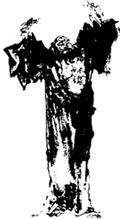
Bodhidharma Lifting the Sky
The great Zen teacher, Bodhidharma (448-527 CE), supposedly created the Eighteen Hands of the Lohan Qigong
Shaolin Wahman - 18 Lohan Hands
The Shaolin Workout: 28 Days to Transforming Your Body and Soul the Warrior's Way. By Sifu Shi Yan Ming. Rodale Press, 2006. Index, 293 pages. ISBN: 1594864004.
Silken Treasures Qigong By Michael P. Garofalo. Descriptions of the eight movements, comments, variations, links, bibliography, quotations, animated .gif photographs of the movements, and charts.
Simple Fitness Exercises: Traditional Chinese Movements For Health & Rejuvenation
The Spiritual Legacy of the Shaolin Temple: Buddhism, Daoism, and the Energetic Arts. By Andy James. Foreword by Dr. Jerry Alan Johnson. Summerville, MA, Wisdom Publications, 2004. 208 pages. ISBN: 0861713524. VSCLC.
Song Dynasty Qi Gong Eight Section Brocade. Eight Section BrocadeInstructional DVD by Shifu Jiang Jian-ye. Videotape 76 minutes.
Stand Still and Be Fit: The Way of Energy. By Master Lam Kam Chuen. Videotape. Includes instruction on the Eight Treasures.
Strength Training Anatomy. By Frederic Delavier. Champaign, Illinois, Human Kinetics, 2001. 124 pages. ISBN: 0736041850. Revised edition of "Guide des mouvements de musculation" Paris, Ditions Bigot, 1998. An outstanding illustrated guide to muscles at work. Both male and female models are used. VSCLC.
Strength Training: Taijiquan, Qigong, Kung Fu and Yoga
Subject Index to Cloud Hands Website
Sun Lu Tang's Internal Martial Arts: Baguazhang, Xingyiquan, Taijiquan, and Qigong. Bibliography, Links, Quotes, Resources, Instructions.
Sun Style of T'ai Chi Ch'uan: Standard Competition 73 Movements Form. Research by Michael P. Garofalo, M.S.. Webpage: 450Kb, June 2008. This webpage includes an introduction, information on the history of the Sun Taijiquan forms, a detailed bibliography, extensive links, references to video resources, a large collections of quotations about Sun Taijiquan, recommendations on the best media resources on the topic, and suggestions for learning the 73 competition Sun Taijiquan form. A detailed comparative list of the names of each of the 73 movements isprovided, with source references, and the movement names are given in English, Chinese, Chinese characters, French, German, and Spanish. This webpage includes detaileddescriptions of each of the 73 movements with black and white illustrations for each movement sequence along with commentary and comparisons. Many additional nomenclature lists and section study charts in the PDF format, photographs and graphics are also provided - over 1.3 MB of information. This webpage is the most detailed and complete document on the subject of the Sun Taijiquan Competition 73 Form available on the Internet. This document was published by Green Way Research, Valley Spirit Taijiquan, Red Bluff, California, 2008. URL:http://www.egreenway.com/taichichuan/sun73.htm.
Sun Lu Tang's Style of Internal Martial Arts: Links, Bibliography, Resources, Quotes, Notes
Sword: Standard 32 Sword Form, Yang Style, Practice
Tai Chi Basics and Eight Pieces of Brocade. By Wong, Doc-Fai. San Francisco, CA. Demonstration videotape, 70 minutes.
Tai Chi Chuan: Standard 24 Form in the Yang Style
Tai Chi Connections: Advancing Your Tai Chi Experience. By John Loupos. Boston, MA, YMAA Publication Center, 2005. Index, 194 pages. ISBN: 1594390320.
Tai Chi for Arthritis. DVD. Narwee, Australia, East Action Video, 1997. 80 Minutes. DVD format. In 4 languages: English, Spanish, French, and Chinese (Mandarin). Created by Paul Lam, M.D., a family physician in Sydney, Australia and internationally acclaimed Tai Chi Chuan teacher. This work is supported by the Arthritis Foundation of Australia. ReviewsA VHS videotape is also available. Some of the warm up exercises in this program are part of the Eight Treasures.
 Drawing the Bow and Letting the Arrow Fly #2 Shaolin Ba Duan Jin
Drawing the Bow and Letting the Arrow Fly #2 Shaolin Ba Duan Jin
T'ai Chi for Seniors: How to Gain Flexibility, Strength, and Inner Peace. By Philip Bonifonte. New Age Books, 2004. 216 pages. ISBN: 1564146979. Includes the Eight Section Brocade. VSCL.
Taijiquan for Good Health, Fitness and Vitality
Taoist Classics. The Collected Translations of Thomas Cleary. Boston, Shambhala Press. Four Volumes: Volume One, 296 pages, 2003. Volume Two, 640 pages, 1999. Volume Three, 304 pages, 2001. Volume Four, 464 pages, 2003. VSCL.
Taoist Eight-Sectioned Satin Chi-Kung. By Leung Ting. Hong Kong, Leung's Publications, 1995. 126p. ISBN: 9627284181.
Taoist Qigong for Health and Vitality: A Complete Program of Movement, Meditation and Healing Sounds. By Hon, Sat Chuen. Boston, Shambhala, 2003. 208 pages. ISBN: 1590300688. For an audio recording of the Healing Sounds is online. Three of the six exercises can be compared with movements in the Eight Treasures: Spleen, "Fu", Press Heaven and Earth (3); Lungs, "Xi", Draw Bow (2); Triple Heater, ""Hey", Hold Up the Sky (1); Kidney, "Chu"; Heart, "Ho"; Liver, "Xu". VSCLC.
Taoist Studies and Practices Ripening Peaches
Tao Te Ching by Lao Tzu. Prepared by the Librarian of Gushen Grove.
Taoist Ways to Transform Stress into Vitality: The Inner Smile and Six Healing Sounds. By Mantak Chia. Healing Tao Books, 1991. 115 pages. ISBN: 0935621008.
Tao of Yiquan: The Method of Awareness in the Martial Arts. Volume 2 of the Trilogy: Warriors of Stillness. Meditative Traditions in the Chinese Martial Arts. By Jan Diepersloot. Walnut Creek, CA, Center for Healing and the Arts, 1999. Index, notes, 272 pages. ISBN: 0964997614. VSCL.
Ten-Section Brocade Qigong Exercise. A poster with instructions by Lin Housheng.
Thirteen Treasures Walking Qigong. By Michael P. Garofalo.
Thanks to Tristan and Carole for sending me a some good links and references for this webpage.
Tips and Suggestions for Qigong Practice. By Mike Garofalo.
A Tooth from the Tiger's Mouth: How to Treat Your Injuries with Powerful Healing Secrets of the Great Chinese Warrior.
By Tom Bisio. Fireside Books, Touchstone, 2004. 384 pages. ISBN: 978-0743245517. VSCL. Read Chapter 6 on Strength Training, which includes the Eight Brocade (pp.106-123) with nice illustrations by Xue Zhu of Tom Bisio doing the "The Eight Brocade Plus."
Touching the Toes and Bending Backward. Movement #7 of the Eight Section Brocade Chi Kung.
Traditional Valuable Health Preservation Series: Eight Section Brocade Exercises. Instructional DVD. 2007. Featuring Pan Shaozu. 64 Minutes. ASIN: B000W0H5JC. Narration in Chinese with English and Chinese subtitles.
Trigrams of the I Ching and Qigong
24 Form, Yang Style Short Form
Tuna and _Daoyin_Brief Explanation
Valley Spirit Center Red Bluff, California. Instructor: Michael P. Garofalo.
Video Clips Online
Ba Duan Jin Chi Kung - UTube Search
Eight Section Brocade Chi Kung - UTube Search
Ba Duan Jin Exercicio, 1 minute and 5 seconds
Eight Simple Qigong Exercises, Yang Jwing-Jing, 47 seconds
Master Jesse Tsao: Qigong 8 Pieces of Brocade, 5 minutes
VSCL = Valley Spirit CenterLibrary Collection, Red Bluff, California
Walking and Tai Chi Chuan Quotes, links, bibliography, and notes.
Walking - General Fitness Exercise
The Big Bear Turns From Side to Side, #7
Drawing by Nadezda Kotrchova
Shaking the Head and Wagging the Tail to Eliminate the Heart-Fire
The Way of Energy: Mastering the Chinese Art of Internal Strength with Chi Kung ExerciseBy Master Lam Kam Chen. New York, Fireside, Simon and Schuster, 1991. A Gaia Original. Index, 191 pages. ISBN: 0671736450. The Eight Section Brocade, Chapter 4, Preparing for Energy, pp. 63-81. VSCL.
The Way of Qigong: The Art and Science of Chinese Energy Healing. By Kenneth S. Cohen. Foreword by Larry Dossey. New York Ballantine Books, 1997. Index, notes, appendices, 427 pages. ISBN: 0345421094. One of my favorite books: comprehensive, informative, practical, and scientific. The Eight Brocades are described on pages 186 - 194. He also has produced audio-cassettes and qigong instructional videotapes. Master Cohen is a fine writer and very knowledgeable about qigong. I recommend that a person new to qigong purchase this book first! VSCL.
The Way of Harmony By Howard Reid. A guide to self-knowledge through the Arts of Tai Chi Chuan, Hsing I, Pa Kua, and Chi Kung. London, Gaia Books Limited, 1988. Index, 191 pages. ISBN: 0671666320. Instructions and illustrations of the Ba Duan Jin set can be found on pages 26 - 33. VSCL.
Weblog - _The Cloud Hands Blog_by Mike Garofalo
The Web That Has No Weaver: Understanding Chinese Medicine. By Ted J. Kaptchuk, O.M.D.. Chicago, McGraw Hill Contemporary Books, 2nd Edition, 2000. Index, bibliography, appendices, notes, 500 pages. Foreward by Margaret Caudill, M.D., and by Andrew Weil, M.D. ISBN: 0809228408. MGC. An excellent introduction to traditional Chinese medicine and modern research on the topic. VSCL.
Wei Qi Gong In the German language.
Where can I purchase these books and videotapes?
The Whole Heart of Tao: The Complete Teachings from the Oral Tradition of Lao-Tzu. By John Bright-Fey. Crane Hill Publishers, 2006. 376 pages. ISBN: 1575872471. The Reverend Venerable John Bright-Fey, Sifu Fey, is the 12th generation lineage holder of the Blue Dragon Order of Esoteric Zen Buddhism, a distinct line of knowledge descended directly from Shaolin Temple. VSCL.
The Whole Heart of Zen: The Complete Teachings from the Oral Tradition of Ta-Mo. By John Bright-Fey. Crane Hill Publishers, 2006. 296 pages. ISBN: 1575872331. This book includes a good discussion of the 18 Hands of theLohan. Reviewof Book by Ned Mudd. VSCL.
Wild Goose Chi Kung: Bibliography, Links, Resources, Quotes, Notes
The Wise Owl Gazes Backward Movement #4 of the Eight Section Brocade. The Wise Owl Looks Backward from side to side. Works the neck and upper back.
The Wonders of Qigong. A Chinese Exercise for Fitness, Health and Longevity. Compiled by the China Sports Magazine, Beijing, China. Published by Wayfarer Publications, Los Angeles, CA, 1985. 111 pages. 275 line drawings. ISBN: 0935099077. Includes the Eight Section Brocade (pp.28-33). VSCL.
Wudang Mountain Badunjin Qigong 20Kb. Original (in Chinese) written in Hong Kong by Woo Kwong Fat, the 28th Generation Master of Dragon Gate Branch, Wudang Mountain.
Wudang Qigong: China's Wudang Mountain Daoist Breath Exercises. By Yuzeng Liu and Terri Morgan. International Wudang Internal Martial Arts, 1999. 244 pages. ISBN: 0967288908.
Wu Qin Xi, Five Animal Frolics, Daoyin (Chi Kung): Bibliography, Resources, Lessons, Links, History. By Mike Garofalo. Animal Frolics: Crane, Bear, Tiger, Monkey, Dragon, and Deer.
Yang Family Traditional T'ai Chi Ch'uan Long Form, 108 Movements. By Michael P. Garofalo. 215Kb+ Provides a list of the movements divided into five sections for teaching (.html and .pdf versions available). Includes a bibliography, links, notes, and quotations. Provides a list comparing the Yang Long Form 108 to the 85 postures sequence. Many Yang style Taijiquan players warm up with the Eight Section Brocade qigong set.
Yi Jin Jing (Muscle and Tendon Changing) Daoyin (Chi Kung)
Yoga: Guides, Links, Bibliography, Quotes, Notes
The Yoga of Breath: A Step-by-Step Guide to Pranayama. By Richard Rosen. Foreward by Rodney Yee. Illustrations by Kim Fraley. Boston, Shambhala, 2002. Index, notes, 304 pages. ISBN: 1570628890. VSCL.
Yuli Qigong. By Jeff Smoley. Wujigong, Zhan Zhuang, 5 Animal Frolics, Jade Power Qigong, and Eight Section Brocade. Jeff borrowed my disclaimer.
Zhong Li-quan, Zhang Liquan, (Chung Li-ch'�an, Zhongli Quan, Chong Li-quan): Notes 1, Notes 2,
Michael P. Garofalo's: Cloud Hands Blog Facebook Hypertext Notebook's Index

This webpage work is licensed under a Creative Commons Attribution-NonCommercial-NoDerivatives 4.0 International License,� 2018 CCA 4.0
Michael P. Garofalo, M.S., Green Way Research, Valley Spirit Center, Gushen Grove, Vancouver, Washington
Green Way Research, � 2000-2018.
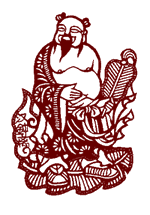
Zhang Liquan (Chong Li-quan)
One of the Eight Taoist Immortals
Legendary Practioner of the Eight Treasures Qigong
Quotations
The Eight Section Section Brocade Chi Kung
八段锦气功
"This exercise consists of eight sections (forms), which the ancients thought as beautiful as brocade, hence its name. To practice this exercise one must keep a tranquil mind, concentrate the mind on Dantian (elixir field), pose as if the head is suspended, keep your mouth shut with the tongue-tip resting on the palate, keep the eyes looking straight forward, relaxing the body as a whole, and breathing naturally. It's practiced in the morning and evening in fresh air for 15-30 minutes each time. In addition, Baduanjincan be used as a warm up exercise."
- Baduanjin
"All students should learn the Eight Treasures first, because many people have serious energy blocks and the Eight Treasures are more effective in quickly breaking through them that the more subtle Tai Chi."
- Hua-Ching Ni, "Workbook for Spiritual Development," Tao of Wellness Press, 1992, p. 138
"Wen Ba Duan is the essential basic set of exercises practiced by Shaolin Monks both prior to, and following their daily long hours of training. The Shaolin Temple, famous as the birthplace of Chinese Martial Arts, was built in 495 AD, and this set of exercises has been documented as having a history in excess of 800 years. The exercises known as Eight Golden Treasures consist of two main parts: the standing forms (Wu Ba Duan) and the seated forms (Wen Ba Duan). Wen Ba Duan emphasizes the internal nature of these exercises in that its principle aim is the cultivation of qi without excessive physical movements of the external Wu Ba Duan. Wen Ba Duan combines the qi cultivation of the mind (yi), deep breathing (tu na), gentle exercise (dao yin) and therapeutic self massage (an mo)."
- Tai Chi Australia
"These are mainly stretching exercises coming from the Shaolin Monastery which is well known for its martial arts. They are the preliminary exercises of the martial arts, including eye exercises, massaging points, stretching, and punching. Traditionally these are not classified as neigong exercise. The name "eight sections of silk," also translated as "eight pieces of brocade," is a misnomer. The correct name is "pull and break tendons.""
- Joe Hing Kwok Chu, Eight Sections of Silk
"Chinese medical chi-gung emphasizes soft, slow, rhythmic movements of the body synchronized with deep diaphragmatic breathing. The purpose of these exercises is to stretch the tendons, loosen the joints, and tone the muscles, to promote circulation of blood, and to regulate all the vital functions of the body. The medical school adapted many forms of 'moving meditation" exercise for therapeutic use, including the ancient _dao-yin_and 'Play of the Five Beasts' forms based on animal movements, martial forms such as 'Eight Pieces of Brocade' and Tai Chi Chuan, and special exercises developed specifically to treat various internal organs."
- Daniel Reid, A Complete Guide to Chi Kung, p. 52.
"These exercises cam to be referred to as nei gong ("internal exercise") because they develop the body from the inside out rather that focusing simply on the external musculature. The practice of internal exercises develops a refined strength. This refined strength can be likened to crude metal that is gradually transformed into tempered steel. The tempering is achieved though slow, steady movements that exercise the muscle evenly throughout their full range of motion. As you move slowly with focused attention, chains of muscles contract and relax synergistically, without engaging the inhibitory reflexes that can interfere with muscle contraction and reduce the applied force of the body's strength. These internal exercises employ natural movements that use the whole body and have wide applicability to sports and activities that require strength, power, and endurance."
- Tom Bisio,A Tooth from the Tiger's Mouth, pp.106-123.
"The Eight Treasures are called Shien Jia Ba Duan Jin in Chinese, meaning "The Eight Groups of Exercise From the Immortal School." I also refer to these movements as the simplified form of Ba Gong Dao-In, which means "Energy-Conducting Exercises of the Eight Old Ones." They have also been called the "Practice of the Eight Immortals," and became more widely known after Prince Liu encourage people to use them as a way integrate the body with the mind and spirit.
The simplified form of the Eight Treasures is more popular than the original form of Ba Gong Dao-In. Later the Eight Treasures were combined with kung fu to become T'ai Chi Ch'uan. The Eight Treasures is a good foundation for learning T'ai Chi Ch'uan because it is easier for people to learn, clears energy blockages, strengthens Chi, and teaches the fundamentals of movement.
The Eight Treasures are comprised of eight sets of movements that combine toning and strengthening exercises, stretching, and specific breathing techniques for the purpose of maintaining health and preventing disease. It is an ancient system of energy enhancement based on the natural motion of the heavenly bodies. This is one way of experiencing that each life is a small model of nature. Moving the body in this fashion guides your internal energies to flow according to the same natural laws that keep the planets on course and the galaxies propelling through space harmoniously."
- By Maoshing Ni,The Eight Treasures Energy Enhancement Exercise.
"China's health-preserving ways of long standing - the technique of Daoyin, meant to activate limbs and the trunk through mind-directed exertion of inner force with simultaneous movements of body-bending and back-inclining, and the extending with withdrawing of limbs; and the technique of _Tuna_consisting of deep breathing exercises of the abdomen - are recorded in the writings of such fourth century B.C. authors as Lao Zi, Zhaung Zi, Meng Zi, and Qu Yuan."
- Chen Style Taijiquan, 1984, p. 4.
"Many scholars attribute the development of the Eight Section Brocade to General (Marshall) Yeuh Fei in the 11th century AD. Others have a different opinion. Stuart Alve Olson, a scholar and Tai Chi Chuan master states: "Pa Tuan Chin, the Eight Pieces of Brocade, is a very ancient form of Tao Yin (Taoist breathing exercises) attributed to Chung Li-ch'uan (also known as Han Chung-li) of the Han Dynasty. Chung Li-ch'uan was the teacher of Lu Tung-pin, one of the Eight Immortals and founder of the Complete Reality Sect. The exercises of Pa Tuan Chin have also been attributed to Chen Tuan, the teacher of the famous Taoist immortal, Chang San-feng, who is credited with inventing T'ai Chi Ch'uan. Pa Tuan Chin has both seated and standing
exercises, in both hard and soft styles."
- Stuart Alve Olson,Cultivating the Ch'i, 1993, p. 138.
"Hua T'o (110-207 A.D.) is one of the famous physicians of the Han Dynasty. In The History of the Later Han, Hua T'o wrote: "Man's body must have exercise, but it should never be done to the point of exhaustion. By moving about briskly, digestion is improved, the blood vessels are opened, and illnesses are prevented. It is like a used doorstep which never rots. As far as Tao Yin (bending and stretching exercises) is concerned, we have the bear's neck, the crane's twist, and swaying the waist and moving the joints to promote long life. Now I have created the art called the Frolics of the Five Animals: the Tiger, the Deer, the Bear, the Monkey, and the Crane. It eliminates sickness, benefits the legs, and is also a form of Tao Yin. If you feel out of sorts, just practice one of my Frolics. A gentle sweat will exude, the complexion will become rosy; the body will feel light and you will want to eat."
- Pual Gallagher, Drawing Silk: A Training Manual for T'ai Chi, Page 6.
"Down through the ages, the exercises as practiced at Shaolin Temple have developed into the largest wushu school with hundreds of routines in different styles, from which many other schools have been derived. Of these mention may be made of Long boxing, "cannon and hammer" boxing, "six-in-one" boxing, baduanjin ("brocade" exercises in eight forms) which is said to have been revised by General Yue Fei (1103-1142) on the arhats' routine in 18 forms, the "stepping exercises" and "heart-and-will" school derived respectively from the dragon's and tiger's sections in Monk Bai Yufeng's routine imitating the five animals' movements, and the long-range boxing in 36 forms compiled by the First Emperor of the Song Dynasty (960-1279). The routines can be practiced solo, duet or trio, and bare hand or with ancient weapons, particularly the cudgel which has earned great reputation for Shaolin Temple."
- China Sports Publications, Shaolin Temple Wushu
"Ba Duan Jin means literally "Eight Pieces of Silk Brocade." These eight exercises are elegant, graceful, and essential methods of qi cultivation. They were first described in an eight-century Daoist text, Xiu Zhen Shi Shu ("The Ten Treatises on Restoring the original Vitality"), in the Daoist Canon. Daoist tradition attributes the exercises to one of the Eight Immortals of Chinese folklore, Chong Li-quan. Chong is frequently represented in Chinese art as a bald-headed, potbellied figure, with a white beard reaching to his navel. Chong had been a general during the Han Dynasty. When his army was defeated in a battle against the Tibetans, Chong withdrew into the mountains rather than face the Emperor's wrath. There he met a Daoist who transmitted to him dao-yin (qigong) "recipes" to create an inner elixir of long life. The Eight Brocades was one of these methods. Before he died, Chong inscribed the exercises on the walls of a cave. When another general, Lu Dong-bin, discovered the cave several centuries later, he followed the diagrams and also became a sage-Immortal. According to a statement in the Ten Treatises, it was General Lu himself who first described the exercise on stone.
- Kenneth S. Cohen,The Way of Qigong: The Art and Science of Chinese Energy Healing. 1997, p. 186.
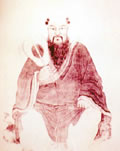
Zhang Liquan (Chong Li-quan)
One of the Eight Taoist Immortals
Legendary Practitioner of the Eight Treasures Qigong
"Ba Duan Jin first appears in writing in an eighth century Taoist text, Ten Treatises on Restoring Original Vitality. It is also explained in an ancient Chinese text call the Dao Shu, compiled during the Southern Song Dynasty (1127-1279 AD). This version is derived from still another Chinese military hero, Marshal Yeuh Fei (1103-1142 AD). He recorded each of the movements in the form of a poem that explained its execution and purpose, and taught them to his soldiers to improve their health, stamina and martial art skills."
- Stanley D. Wilson, Qi Gong for Beginners, 1997, p. 19
"Interestingly, while we do not practice Ba Duan Jin as part of our Shaolin Wahnam official syllabus, ourEighteen Luohan Hands is also found in Ba Duan Jin. Obviously we have 10 more patterns, although personally I only know 3 of the 18. I am aware of some differences between our 18 Hands and Ba Duan Jin, particularly in the breathing methods. For example, in Lifting the Sky (Shuang Shou Tuo Tian), we breathe in as we raise our arms, whereas some practitioners I know breathe out when extending the arms upwards. I think it depends largely on the objectives of the exercise, or it could simply just be a natural variation as the the two sets of exercises evolved through different masters. In fact, I believe that Ba Duan Jin is far from homogeneous among practitioners. I have seen at least 4 different ways of Lifting the Sky and Shaking Waist outside Shaolin Wahnam."
- Zhang Wuji,Eight Section Brocade List Discussion
"Daoyin (a.k.a. Tao Yin), which literally means �guiding and stretching,� is a traditional Chinese form of �calisthenics� (Grk.: �beautiful strength�; physical exercise) or �gymnastics� (Grk.: �to train�). Traditionally and historically speaking, Daoyin practices are stretching exercises, usually combined with breath-work. Some Daoyin practices involve specific breathing (huxi) patterns. The earliest forms of Daoyin were developed during the Early Han dynasty (206 BCE-8 CE), in the context of health and longevity as well as therapeutic movements. Daoyin practice is also sometimes referred to as Yangsheng , which literally means �nourishing life.�"
- Center for Daoist Studies
"The Eight Strands of Silk Brocade are indeed a fine suit of clothes. It has been said that Baduanjin is the most popular qigong exercise set in the world. It is plain to see why. By practicing the whole set of eight exercises in a similar manner to Taijiquan one can expect to see significant changes in health and vitality within six months, more subtle changes within a year and greater changes within five years."
- Shihfu Mike Symonds, Ba Duan Jin
"In the past, people practiced the Tao, the Way of Life. They understood the principle of balance, of yin and yang, as represented by the transformation of the energies of the universe. Thus, they formulated practices such as Dao-yin [qigong], an exercise combining stretching, massaging, and breathing to promote energy flow, and meditation to help maintain and harmonize themselves with the universe."
- Yellow Emperor's Classic of Internal Medicine, _Huang Ti Nei Jing, 8_00 BCE
"Later, during what is known by historians as the Warring States Period, 480-222 BC, we find the emergence of what are called Tao Yin (daoyin) disciplines, again special exercises for health that may, in part at least, have been derived from the much earlier era of the Yellow Emperor. Tao Yin means 'guiding and inducing' - guiding and inducing the flow of chi around the body. At the same time, special breathing techniques combined with meditation were also being introduced by the Taoist philosophers. These techniques, they claimed, were effective not only in the treatment of certain illnesses but also in the prevention of disease. It is important to understand that in those times a philosopher was also someone who meditated and probably also practiced medicine. All these subjects were linked, making up what we would today term an 'holistic' approach."
- History of Chi Kung
"The Eight Strands of Silk Brocade are an extremely fine set of eight Qigong exercises. They are learned and then practiced as one complete, unbroken form; each movement of each of the eight exercises being repeated eight times before doing the next exercise in sequence. Like most of the best things in life they are simple, easy to learn, easy to perform and taking only 14 - 18 minutes to do every morning and night. This is the way to improve health and well-being in a relaxed and easy manner. The only thing which stands in anyone's way is their own laziness or lack of self-discipline."
- The Eight Strands of Silk Brocade
"The most recent evidence of the long history of these movements [Qigong exercises] comes from a silk book unearthed in 1979, known as the Dao Ying Xing Qi Fa ("Method of Inducing the Free Flow of Chi"). The book dates from the Western Han Dynasty, which ran from 204 BC to AD24, and bears 44 drawings of men and women in exercise positions resembling the Ba Duan Jin."
- Master Lam Kam Chuen, The Way of Energy, 1991, p. 81.
Reproduction of the qigong exercises silk scroll (Dao-yin Tu) found in the tomb at Mawangdui, China, in 1973.
This scroll is from the period around 168 BCE. Photo from the Wonders of Qigong, China Sports Magazine, 1985
"The Dao-yin Tu is the finest example of the consistency and continuity of qigong healing
techniques. The majority of the exercises look so similar to the postures of modern qigong
that it is possible to deduce how they were performed. The rich themes found in the
Dao-yin Tu run like a fine thread through the fabric of qigong history and evolution.'
- Kenneth Cohen, The Way of Qigong, 1997, p. 19
�Baduanjin�, which literally translates as �eight pieces of silken brocade�, has always been a very popular exercise in China. Its unusual name derives from the fact that the Chinese character for silken brocade � �jin� � also has the archaic meaning of that of a set of exercises composed of different movements. Hence the title �eight pieces of silken brocade� can be interpreted more accurately as �an exercise composed of eight sets of movements�. Baduanjin has a written history of over 800 years. During this period of time, many modifications and innovations have been added to the original form. Although the variations are numerous, they can be broadly categorized into themes related to the seated and to the standing postures, with the latter further sub-divided into the �Northern� and the �Southern� styles. "
- Howard Choy, Baduanjin
"For nearly a thousand years, Eight Treasures Qigong has been passed down to maintain overall health and increase vitality. There are many versions of this form, but all rely on the same basic principles and theory of Qigong practice. The Eight Treasures is effective in building up energy throughout the body, and particularly in the limbs, where it will then flow into and circulate supporting the internal organs. It thoroughly works all the energy channels in the body in a precise and effortless way. Practitioners of the Eight Treasures will enjoy the gentle stretching and twisting movements to release and relax the entire body, to increase blood and energy circulation and to strengthen their internal organs. The best thing about the Eight Treasures however, is that it is very simple to learn, easy to practice and good for you! Also referred to as the Eight Pieces of Brocade and the Eight Jewels."
- Embrace the Moon Seattle Tai Chi and Qigong
"Ba Duan Jing consists of eight different movements, each one of which is simple, short, and effective. Since time or location does not restrict one's practice, it is quite popular, and consists of two styles. The Wen or sedentary style adopts a sitting position with concentrated mind and attention to one's breathing. This particular type incorporates knocking teeth, shaking head, gargling throat, massaging the kidney area, swaying shoulder, pressing the scalp, stretching the sole of the foot, etc. In contrast, the Wu or active style adopts a standing position emphasizing body movement. These movements are called "Upholding the heaven and regulating Sanjiao," "Stretching the bow with both sides," "Regulating the spleen and stomach," "Looking backwards," "Swaying the head and tail," "Tapping at the back," "Holding fist and staring," "Stretching to both soles," etc."
- Ming Qi Natural Healtcare Center
"The �Eight Brocades� are a static � dynamic Qigong technique widely diffused among the Chinese people. The technique is extremely ancient, with at least a thousand year history. It has been highly studied and perfected throughout the course of its history, to the point where it could represent a complete therapy. It is ideal for stretching the meridians and unblocking the energy channels (qi) in the human organism. It balances the energy in all of the internal organs and eliminates every type of nervous or emotional tension. It can be practiced in different ways, according to the predetermined scope, martial or therapeutic, or according to the person practicing it (young, old, healthy or sick). The exercises of which it is composed can be practiced individually or all together, one after the other separately or in a continuous sequence."
- Gli Otto Broccati
"The Eight Section Brocade exercise has been in existence for more than eight hundred years. Because of its effectiveness for keeping fit, it was accepted by Shaolin monks as one of the basic entering level exercises for Shaolin Wushu. Unlike Shaolin hard kung fu and the rest of Shaolin style for combat, the Eight Section Brocade is a form of soft qi gong. The Eight-Section Brocade is an ideal life time exercise for most people. It is especially recommended for people who work at desks every day. Regular practice of this exercise can strengthen one's internal organs as well as one's muscles and tendons."
- China Guide
"Badunjin Qigong originates from the Dao-Yin life-nourishing techniques of the ancient era. The medical professionals, longevity-research experts, Qigong masters of all ages developed this set of traditional body-strengthening exercise which was founded on the theory of Chinese medicine. The Dao-yin, Qigong, martial arts, gymnastics, massage, breathing arts, life-emulation and ancient dance is amalgamated to form into eight segments. The creation of these segments is based on the physiological condition and pathological changes of the human body, and the emulation of the self-strengthening and self-healing movements of flying birds, diving fishes, running animals and crawling species. The categorization of these uniquely selected segments is based on the concept of Pak Qua. This has been profoundly developed in the past through long-term practice and continual improvements and is rich in the ethnic characteristics of the Chinese race."
- Wudang Mountain Badunjin Qigong, by Dragon Gate Master Woo Kwong Fat, Wudang Mountain.
"The eight brocade is one of the most widely practiced classic exercise sets in China, which can be dated back over 1,000 years. Its long existence has resulted in its adoption by a diverse collection of practitioners, which has lead to numerous variations. This set of excises is often practiced with Qigong. The movements provide a comprehensive system of excise for people of all ages, toning up muscles and stimulating the flow of qi throughout the body. People are advised to perform it vigorously when in good health, to help build up the strength and suppleness. But if you are in illness or in later years you should practice more gently. It is widely regarded as the initial form set for any qigong or martial arts new practitioners. Every movement is designed
to regulate or strengthen organs or bowels."
- DaMo Qigong and Wudang KungFu
"The Eight Pieces of Brocade (Ba Duan Jin). The Eight Pieces of Brocade is a Wai Dan Medical Qigong exercise set. It is actually two sets of eight simple exercises each (a sitting set and a standing set) that can maintain your health and increase your energy reserves if you are healthy, and speed your recovery if you are ill. This set was created by Marshal Yue Fei (1103-1141 A.D.) in the Song dynasty to keep his soldiers strong and healthy. The Eight Pieces of Brocade leads the beginner to the door of understanding Qigong."
- Yang Jwing-Ming's Martial Arts Academy
"Baduanjin which literally translates as the "eight pieces of silken brocade," has always been a very popular exercise in China. Its unusual name derives from the fact that the Chinese character for silken brocade also has the archaic meaning of that of a set of exercises composed of different movements. Hence the title "eight pieces of silken brocade" can be interpreted more accurately as "an exercise composed of eight sets of movements." Baduanjin has a written history of over 800 years. During this period of time, many modifications and innovations have been added to the original form. Although the variations are numerous, they can be broadly categorized into themes related to the seated and to the standing postures, with the latter further sub-divided into the Northern and the Southern styles. The Northern style claims its legendary founder to be Yue Fei, who was a famous general in the Sung Dynasty (960-1279AD). It is considered to be more difficult to perform than the Southern style."
- Baduanjin
"These are the "Buddhidarma Lohan 18 hands" ("lohan kung" for short), the "siu lohan", the "da lohan" and the "wu chi". Together these four form a complete system of internal kung-fu to cover the whole range of choy lee fut qigong skills. We have grouped these four forms under the generic name of "lohan qigong", literally "the art of the breath of the enlightened ones". In its original form lohan qigong is an internal set of exercises for cultivating the "three treasures" of qi (vital energy), jing (essence), and shen (spirit). Done regularly it activates the flow of the intrinsic life energy along the meridians, strengthens the internal organs, increases longevity through maintenance of health and vigor of body and mind, exercises the joints and muscles, promotes relaxation and stress management, prevents occupational physical stress diseases, promotes postural awareness and correct posture, and provides the essence and base for many internal and external martial arts."
- Howard Choy, The Lohan Qigong System, 1999 The Shaolin 18 Lohan Hands system is much more extensive than the Eight Section Brocade. Refer to the bibliography above for more references. Notes on "Lohan."
"The Eight Treasures is an ancient system of Chi Gong or energy practice that is based on the natural motions of the heavenly bodies. The primary function of the Eight Treasures is to establish a balance of yin and yang energies and an activation of all twelve of the main energy meridians in the body. At the physical level, the Eight Treasures can help restore the body to a normal degree of health and beyond. It can provide you with the ability to directly affect and improve your health, and eliminate disease. At the mental level, this practice will help you experience sharpened mental capacity, a clearer mind, balanced emotions and a re-activation of the central nervous system. At the spiritual level, it can allow you to embrace the meaning of oneness with the universe and experience the unity of body, mind and spirit."
- Cindy Kienitz, Atlantic Institute
"The Eight Verses of Wudang Mountain Badunjin :
1. Lift the ground and hold the sky to take care of the three internal cavities
2. Draw a bow to the left and right, just like shooting a vulture
3. Lift the hand up singly to tone and caress the spleen and the stomach
4. Look backwards to cure the five strains and seven injuries
5. Reach down the leg by both hands to strengthen the kidney and the reproductive organ
6. Swivel the head and rock the bottom to calm down
7. Rotate fists and stare to add stamina
8. Vibrate the back seven times to expel illness
The first segment takes care of the three chiaos (internal organs), the second segment strengthens the heart and the lung, the third regulates the spleen and the stomach, the fourth cures strains and injuries, the fifth toughens the kidney and reproductive organ, the sixth calms the nervous system, the seventh increases stamina, the eighth gets rid of illnesses. It has materialized the merging of the theory and movements of Badunjin with clinical sports, as well as specified the importance of life-nourishment and health-preservation. Badunjin Qigong, uplifted by the modern medical confirmation from Chinese and western professionals and scholars, continues to be revitalized and made to perfection. Thus it has been made even more suitable and practical to serve the needs of the modern era, and advances with time.
The theory and movements of Wudang Badunjin is thorough; it is safe and easy to learn, and has a wide application on medical cure. Externally, it exercises the skin, muscles, tendons and bones; internally, it strengthens the organs, improves the circulatory system, and consolidates the spirit of well being. Its movements involve breathing naturally, and are smart & light, continuous and lively, elegant and beautiful, stretchy and graceful, alternating relaxing with tightening, synchronizing harmoniously, can be fast or slow but with distinct rhythm, can be complicated or simple, active or quiet, and cohere the opening with the closing. It stresses on the mutual use of toughness and gentleness, the training of the internal and external body parts, the merging of activity and quietness, the balancing of the left and the right, the top and the bottom, alternating the real and the virtual, and nourishing both the body and the spirit. The amount of exercise and the length of the practice session can be adjusted anytime, and it can be practised alongside with other exercises. Age, sex, body nature, location, equipment, time, season, etc do not restrict the practice. It can be practised individually, with the whole family, or with a group. The all-encompassing effect and value of its body-strengthening and medical aspects is evergreen."
- Wudang Mountain Badunjin Qigong
Original (in Chinese) written in Hong Kong by Woo Kwong Fat, the 28th Generation Master of Dragon Gate Branch, Wudang Mountain. 20Kb.
"Although the term qigong (氣功) has been traced back toTaoistliterature of the earlyTang Dynasty (618-907 AD), the term qigong as currently used was promoted in the late 1940s through the 1950s to refer to a broad range of Chinese self-cultivation exercises, and to emphasize health and scientific approaches, while de-emphasizing spiritual practices, mysticism, and elite lineages. With roots in ancient Chinese culture dating back more than 4,000 years, a wide variety of qigong forms have developed within different segments of Chinese society: intraditional Chinese medicine for preventive and curative functions, in Confucianism to promote longevity and improve moral character, in Taoism and Buddhism as part of meditative practice, and in Chinese martial arts to enhance fighting abilities. Contemporary qigong blends diverse and sometimes disparate traditions, in particular the Taoist meditative practice of "internal alchemy" (Neidan內丹术), the ancient meditative practices of "circulating qi" (Xing qi 行氣) and "standing meditation" (Zhan zhuang 站桩), and the slow gymnastic breathing exercise of "guiding and pulling" (Tao yin導引). Traditionally, knowledge about qigong was passed from adept master to student in elite unbroken lineages, typically with secretive and esoteric traditions of training and oral-mind transmission."
- Qigong, Wikipedia
Dr. Ken Andes, L.Ac, D.Ac. (RI) .a licensed acupuncturist, board certified herbalist, and medical qigong instructor, says this about Baduanjin in the January 2006 issue of �Qi Dao� newsletter:
"It is non-strenuous and can be done by anyone of any age.
It will regulate your digestion and metabolism, thus helping with weight loss.
It takes less than 10 minutes a day to perform.
It is very easy to learn...no matter how uncoordinated you are.
It will stretch and tone all of your muscles, thus increasing your flexibility.
It will help relieve neck, back, and shoulder pain.
It will make your muscles (especially your legs) stronger.
It will stimulate your lymphatic system and help detoxify the body of environmental poisons.
It will develop a calm, focused mind.
It helps relieve depression and anxiety.
It requires no special equipment and can be done anywhere, anytime.
It will make you look and feel many years younger.
It will harmonize and stimulate all of your acupuncture meridians, giving you a similar effect of
an acupuncture treatment....without the needles!!"
"The heart is associated with the negative emotions of arrogance and hate and the positive virtues of kindness and love. Recent scientific research shows that feelings of love and appreciation strongly influence the heart's rhythm and its relationship to the body's physiological systems. The lungs are associated with the negative emotions of sadness and depression, and the positive virtues of courage and righteousness. Emotional depression is often recognized by a physical depression and collapse of the chest and lungs. The kidneys are associated with the negative emotion of fear and the positive emotions of gentleness and kindness. Fear is closely related to the activity of the adrenal glands that lie on top of the kidneys. The adrenal glands secret adrenalin and noradrenalin when stimulated by the body's fight-or-flight response. The liver is associated with the negative emotion of anger and the positive emotions of generosity and forgiveness. Physiologically, the liver is important for storing and rapidly releasing glucose into the blood. The energy of anger requires the rapid availability of metabolic energy stores in the body. The stomach/spleen are associated with the negative emotions of worry and anxiety and the positive emotions of fairness and openness. Most people will be familiar with the "butterflies" and "knots" in the stomach related to worry, apparently related to a network of network of neurons and neurotransmitters in the sheaths of tissue lining the digestive system, known as the enteric nervous system."
- Inner Smile and Six Healing Sounds
Translation:
1. Both hands carry heaven to regulate the triple burner (A). Double hands hold up Heaven to regulate the Triple Burner (B).
2. Draw the bow left and right as if to shoot a vulture. Left and Right open a bow like shooting a Golden Eagle.
3. Regulate spleen and stomach by lifting one hand. Regulate the spleen and stomach by lifting the arms.
4. Remedy the 5 symptoms and 7 disorders by looking backward. Five weaknesses and seven injuries, turn and look backward.
5. Turn the head and swing the tail to eliminate heart-fire. Shake the head and swing the tail to remove heart fire.
6. Two hands grab the feet to strengthen kidneys and waist. Both hands pull the feet up, strengthen kidneys and waist.
7. Clench fists and look angry to increase qi and strength. Screw the fist with glaring eyes to increase strength.
8. Jolt the back 7 times and hundred illnesses will disappear. Seven disorders and hundreds of illnesses disappear and are left behind you back.
A. �I saw you included the list of movements in Chinese in your webpage on Baduanjin. Very good! It might be interesting to add that this is a Chinese (didactic) poem, made for easy remembering the eight movements and their effect. This poem has the classical Chinese format with 8 lines of 7 characters each and rhyme in line 1, 2, 4, 6 and 8."
Thanks to Hielke Hylkema for sending me the above information and translation.
B.
Animal Spirits Within the 8 Silk Brocade. By Christina Barea-Young and Peyton Young. Found in "Qi: The Journal of Traditional Eastern Health and Fitness" Volume 24, No. 2, Summer 2014, pp. 47-48.
"Other theories suggest that the Eight Brocades are a collection of various Taoist breath exercises with influences coming from the Buddhist patriarch Bodhidharma's works, the I chin ching and Hsi sui ching (Muscles Changing Classic and Marrow Cleansing Classic); or, that the Sung dynasty military leader General Yueh Fei invented the exercises. These two highly improbably founders serve more to validate the practice of the Eight Brocades within the Buddhist and martial arts schools. The development of the Eight Brocades is rather clouded. All the various schools have claimed it as their own invention, and have inserted their own ideas. It has even been presented as twelve exercises, or the Twelve Brocades (shih erh tuan chin). The exercises also appear in a more dissected manner with many additions, under the heading Internal Kung for the Four Seasons (nei kung szu ling), as twenty four exercises for specific periods of the year. In martial arts, the Eight Brocades have become a system of not only standing postures but also sword and staff forms. They are now being presented as a form of qigong, a term that did not appear until 1910 in a book entitled Shaolin Tsung fa (Shaolin Orthodox Methods). The author used the term generically to cover a wide range of ideas, including respiratory and meditative exercises directed at mobilizing the breath. Qigong is not in any sense a traditional Taoist term, but has since been adapted to many Taoist works. Since no clear evidence exists as to when the Eight Brocades were first developed, the answer as to their origin really depends on which school or thought of Taoism, Buddhism, Confucianism, medicine, or martial art you wish to believe. Each school seems to have its own unique evidence and prejudice."
- Stuart Alve Olson, Qigong Teachings of a Taoist Immortal, p. 26
"The Baduanjin (traditional Chinese: 八段錦氣功;simplified Chinese: 八段锦气功) is one of the most common forms of Chineseqigong used as exercise. Variously translated as Eight Pieces of Brocade, Eight Section Brocade, Eight Silken Movements and others, the name of the form generally refers to how the eight individual movements of the form characterize and impart asilken quality (like that of a piece ofbrocade) to the body and its energy. The Baduanjin is primarily designated as a form of medical qigong, meant to improve health. This is in contrast to religious or martial forms of qigong. However, this categorization does not preclude the form's use by martial artists as a supplementary exercise, and this practice is frequent.
This exercise is mentioned in several encyclopedias originating from theSong Dynasty. The Pivot of the Way (Dao Shi) (c. 1150) describes an archaic form of this qigong. The Ten Compilations on Cultivating Perfection (Xiuzhen shi-shu) (c. 1300) features illustrations of all eight movements. The same work assigns the creation of this exercise to two of theEight immortals, namelyZhongli Quan andLu Tung-pin.
It is also mentioned in popular tales during the Song. Stories Heard by Yijian (Yijian Zhi) by Hong Mai (1123-1202) details a story about a practitioner who is shocked to learn that practicing this set "may lead to premature death. This is conveyed to him by his helper, who is a "Daoist sage in disguise."
The exercise was later expanded from eight to twelve movements over the centuries and was described in the boxing manual Illustrated Exposition of Internal Techniques (1882) by Wang Zuyuan, a famed practitioner of the Sinew Changing Classic set.
Nineteenth century sources attribute the style to semi-legendary Chinese folk hero GeneralYue Fei, and describe it as being created as a form of exercise for his soldiers. The legend states he taught the exercise to his men to help keep their bodies strong and well-prepared for battle. Martial historian Prof. Meir Shahar notes Yue's mention as a lineage master in the second preface of the Sinew Changing Classic manual (1624) is the reason why he was attributed as the creator of Baduanjin qigong."
- Baduanjin Qigong - Wikipedia Article
"As a traditional Chinese health and fitness Qigong exercise routine, Ba Duan Jin, or Eight Section Exercises, dates back to the Song Dynasty (960-1279). With easy movements and impressive effects on the health, it is a gem in China's health and fitness culture. As a safe aerobic exercise, it features a movement intensity and format in line with the theories of kinetics and physiology. Added to the traditional eight movements, are sections on the preparatory posture and closing form, making the exercises more complete, standardized and rational. It has been proved that the practice of Ba Duan Jin improves the respiratory system, limb strength, flexibility of the joints, and fortifies the nerves, as well as enhances the general balance. It improves the cardiovascular function and helps to cure such illnesses as coronary artery scleroses and osteoporosis. It strengthens one's immune system to a degree, and delays the aging process, so as to increase the life span. It also improves one's mental health. A survey shows most Ba Duan Jin practitioners are satisfied with the practice duration, intensity, and routine format outlined below, and testify to Ba Duan Jin's effects on health improvement."
- Chinese Health Qigong Association, Ba Duan Jin, 2007
"The name �Ba Duan Jin� has been found as early as the Northern Song Dynasty. According to Hong Mai's (洪邁) Yi Jian Zhi (夷堅志, Song Dynasty), Zhenghe Seventh Year, Emperor's Chief Secretary, Li Shi-Ju, lived a simple life. He spent a large portion of his time in his mediation room practicing Daoist Monk�s exercises expanding like a bear and stretching like a bird. In the early hours, he is often found breathing and massaging, practicing the so-called Eight-Section Brocade (Ba Duan Jin). This passage reveals that Ba Duan Jin has been developed and practiced since the Song Dynasty as a general health-keeping regime.
Both sitting and standing forms have been found in the history of Ba Duan Jin (八段錦),. Standing forms were developed into two schools (northern and southern styles) in the Qing Dynasty. The Northern School, said to have been passed down by Yue Fei (岳飛), has tougher forms, and the Southern School, claimed the lineage from Liang Shi-Chang (梁世昌), focuses on softer trainings. Quite a few verses has been passed down during the period from Song Dynasty to Qing Dynasty, but all verses for the standing forms have evolved from the passages recorded in "The Chapter of Wonders, Pivot of Dao" (道樞�眾妙篇, Dao Shu, Zong Miao Pian, Song Dynasty) and verses of the sitting style from the forms recorded in "TheTen Books of Daoist Practices" (修真十書Xiu Zhen Shi Shu, Ming Dynasty ). or"The Methods of Curing"(活人心法, Huo Ren Xin Fa, Ming Dynasty). Sets Ba Duan Jin forms are not always limited to the number of eight. The number of forms in a set range from a single form to tens or as many as a hundred; nevertheless, they are all exercise regimes designed for health-keeping, preventive, and therapeutic purposes, and, liberally saying, all exercise regimes designed for such purposes are part of the Ba Duan Jin system."
- Lee Chang-Chih, A Brief Introduction to Ba Daun Jin. "Reinterpreting Ba Duan Jing From the Theories of the Eight Extra Meridians" 2005
"Interestingly, the first 8qigong exercises from the 18 Lohan Hands qigong/chi kung set also form another set known as Ba Duan Jin or 8 Pieces of Brocade. There are many different versions of the Ba Duan Jin made up of different qigong exercises to the ones in this version (just do a quick search on UTube and you�ll see what I mean). Is that a problem? I don�t think so, I think it makes sense. When you consider that qigong has a history of over 5000 years you�ve got to expect a bit of variety! Especially when you factor in things like different religious and political views, different needs of different people and groups. So let�s not have any of that �my ba duan jin is better than your ba duan jin� nonsense. Recall that Qigong is a composite of Form, Energy and Mind. As long as the 8 qigong exercises of a ba duan jin set are practiced as qigong (and not just qigong form) and a practitioner gets the benefits of practicing qigong from them � then that�s brilliant."
- Marcus James Santer
"This class is designed to introduce the beginning student to the 8 Brocade Qigong practice, a simple Qigong set beneficial for general overall health. Featuring gentle movements, deep breathing, and meditation techniques, this Qigong set promotes the circulation of blood and Qi (vital energy) within the body. The practice is rejuvenating and renewing, and evokes states of internal stillness, centering, balance and a feeling of well being. Qigong is also practiced to strengthen the internal organs and the immune system." This 2013 class was taught byMike Chegini, Longevity Center Associate.
"The Eight Brocade Plus exercises are a form of internal exercise, or nei gong. They are said to have been created by Marshal Yue Fei, a great hero and martial artist from the Song Dynasty. Since that time, they have been used by the Chinese people as a series of health and rejuvenation exercises and by martial arts masters to develop refined strength and power. The Eight Brocade Plus exercises include some variations of the original eight that have been added over the centuries to provide a more comprehensive method of increasing strength and suppleness. If you are in good health and training for sports, the exercises should be performed vigorously."
- Tom Bisio,A Tooth from the Tiger's Mouth, pp.106-123.
�The eight movements correspond to the ba-gwa and five elements as well which directly tells you their relationship with the workout to different organs as well. That is why there are eight movements. It is supposed to designed to work in a very logical order to energize and workout your organs and the meridians of these organs in one simple workout.
"Baduanjin is composed of eight sections of movements. The word �eight� not only refers to the eight movements, but also indicates the multiple elements of the qigong that are inter-restricting, inter-relating and in repeated cycles. This collection of movements is used regularly by Shaolin Disciples as part of the training regime because it is at the core of developing internal energy. Baduanjin, or �Eight Section Brocade�, is a type of Chinese qigong handed down from ancient times. It was created in the Southern Song Dynasty and caught on in the late Northern Song Dynasty. Baduanjin was collectively created by health experts and qigong practitioners through the ages. Ba Duan Jin is thought to have been created by Ling Qiushan, an eminent monk of Shaolin Temple who died at the age of 109. Ba Duan Jin has the function of spreading the bones and muscles, accelerate the circulation of blood, regulating the qi and blood, and promoting the metabolism of the body. By regular practice it can improve your constitution, increase your resistance to illnesses, prevent diseases, and prolong your life."
- Shaolin Kung Fu and Tai Chi Centre
Namesof the Movements in Languages Other Than English The Eight Section Brocade Chi Kung
I welcomeemail contributions corrections for other languages, and will give credit. I would like to improve this section and include more languages.
Eight Section Brocade Chi Kung (Qigong)
Eight Treasures, Eight Beautiful Tapestries Qigong (Chi Kung)
Las Ocho Piezas del Brocado Qigong Spanish
Ba Duan Jin Qigong Chinese
Les Huit Exercices del la Soie Qigong French
De Acht Delen Brokaat Qigong German
Otto Pezzi di Broccato Qigong Italian
Al Presionar a los Cielos con las dos Manos Spanish
Shuang Shou Tuo Tian Li San Jiao Chinese
En Appuyant sur Vers le Ciel avec les Deux Mains French
Dr�cken in den Himmel mit zwei H�nden German
Premendo Fino al Cielo con due Mani Italian
Dibujar el Arco y Dejar Volar la Flecha Spanish
Zuo You Kai Gong Si She Diao Chinese
Dessin de la Bow et de Laisser la Mouche Fl�che French
Den Bogen zu spannen und den Pfeil fliegen Letting German
Tendere l'arco Lasciare Andare la Freccia Italian
Separar el Cielo y la Tierra Spanish
Tiao Li Pi Wei Ju Dan Shou Chinese
S�paration Ciel et la Terre French
Trennung von Himmel und Erde German
Separare la Cielo dal Terra Italian
B�ho Sabio Miradas Hacia Atr�s Spanish
Wu Lao Qi Shang Xiang Hou Qiao Chinese
Le Sage Hibou Gazes Arri�re French
Die Weise Eule Blickt Zur�ch German
Il Saggio Gufo Sguardi All'indietro Italian
El Grand Oso Gira de Lado a Llado Spanish
Yao Tou Bai Wei Qu Xin Huo Chinese
Grand Poeter Tourne de Droite � Side
Der Grosse B�r Wird von Seite zu Seite German
L'orso Grande Giri da un Lato All'altroItalian
Perforaci�n con una Mirada Enojada Spanish
Cuan Quan Nu Mu Zeng Qi Li Chinese
Poin�onnage Avec un Regard en Col�re French
Stanzen mit Einem Zornigen Blick des German
Punzonatura con uno Sguardo Arrabbiato Italian
El Contacto con los Dedos de los Pies a Continuaci�n, Dobl�ndose Hacia Atr�s Spanish
Liang Shou Pan Zu Gu Shen Yao Chinese
Toucher les Orteils, puisse Penchant en Arri�re French
Ber�hren Sie dann die Zehen nach Hinten Beugen German
Toccando le Dita dei Piedi Piegando Italian
La Agitaci�n del Cuerpo Spanish
Bei Hou Qi Dian Bai Bing Xiao Chinese
摇晃的身体Chinese
Secouer le ConseilFrench
Sch�tteln des K�rpers German
Scuotendo il CorpoItalian
Встряхивания телаRussian
Valley Spirit Center, Gushen Grove, Red Bluff, Tehama County, North Sacramento Valley, California (1998-2017) Vancouver, Clark County, Columbia River Valley, Washington (2017-)
State of Washington: Vancouver, Salmon Creek, Orchards, Camas, Washougal, Ridgefield, Battleground, Woodland, Kalama, Longview, Kelso. State of Oregon: Portland, Gresham, Troutdale, Oregon City, Hillsboro, Beaverton, Clackamas, Tigard, Lake Oswego, McMinville, Wisonville, Canby, Woodburn, Salem. Columbia River Valley, Willamette River Valley
� Green Way Research, Valley Spirit Qigong, Michael P. Garofalo, 2002-2023, All Rights Reserved
The information on this webpage was first published on the Internet in March of 2002.
This webpage was last changed, modified, improved, edited, reformatted or updated on January 7, 2023..
Tai Chi Chuan, Taijiquan, T'ai Chi Ch'uan, Tai Chi, Tai Ji Quan, Taiji, Tai Ji Chuan
Chi Kung, Qi Gong, Qigong, Chee Gung, Qi, Chi, Tu Na, Dao Yin, Yi, Neigong, GongFu, Kung Fu, Yang Sheng Gong
Ch'i gung, Ch'i Kung, Nei Gong, Yangsheng Fa
Ba Dun Gin, Baduanjin, Ba Dwan Gin
Pan Dan Gum, Eight Silken Movements, Pa Tuan Chin, Pa Tin Kam (Cantonese)
Otto Pezzi di Tesoro
Eight Treasures Qigong, Eight Silken Treasures Chi Kung, Ba Duan Jin Qigong,
Ba Duan Jin Chi Kung, Eight Section Brocade Qigong, Eight Pieces of Brocade Qigong,
Eight Pieces of Silk Chi Kong, Eight Ancient Ones Chi Kung (Dao-Yin, Tao-Yin)
Eight Animal Frolics Chi Kung, Eight Warrior Attendants of the Buddhist Temple Chi Kung
Eight Mountains Daoist Chi Kung, Eight Wondorous Flowers Chi Kung, Eight Silken Treasures Chi Kung
Ba Duan Jin, Pa Tuan Chin, Pal Dan Gum, Pa Tuan Tsin
